Access Class 12 Maths NCERT Solutions Chapter 7 Integrals Miscellaneous Exercise, contains solutions for all Integrals Exercise Class 12 questions.
Integrals Class 12 NCERT Solutions Maths Chapter Integrals Miscellaneous Exercise

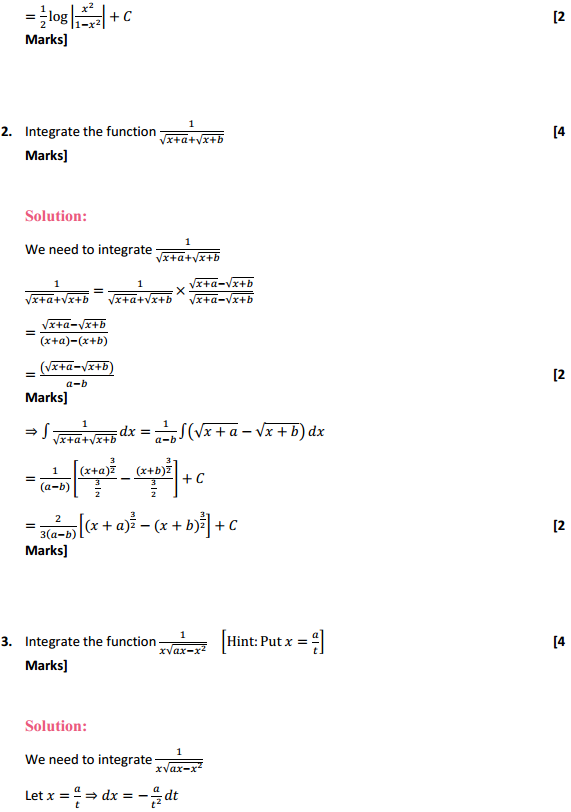

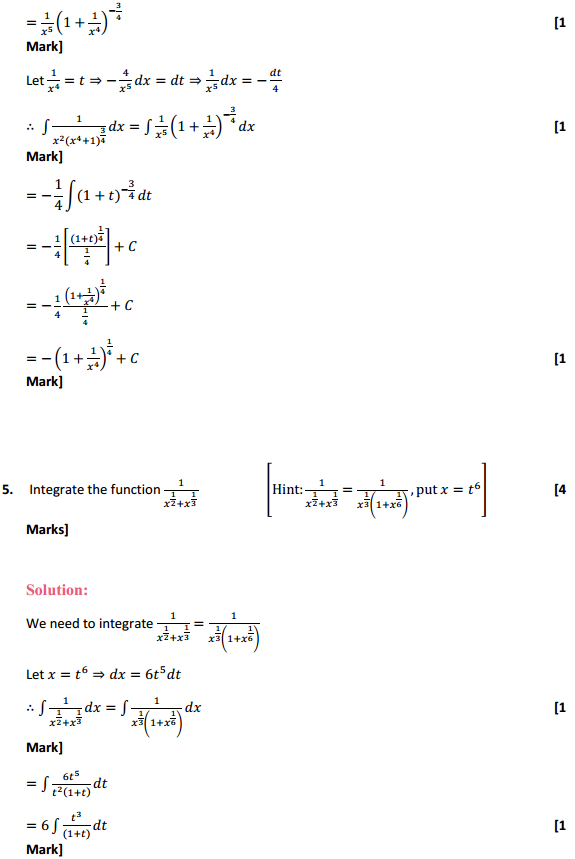
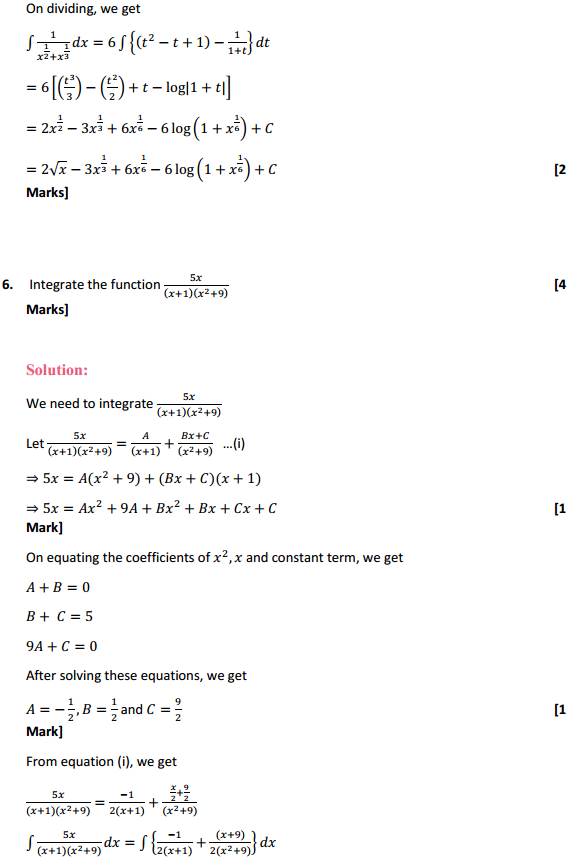
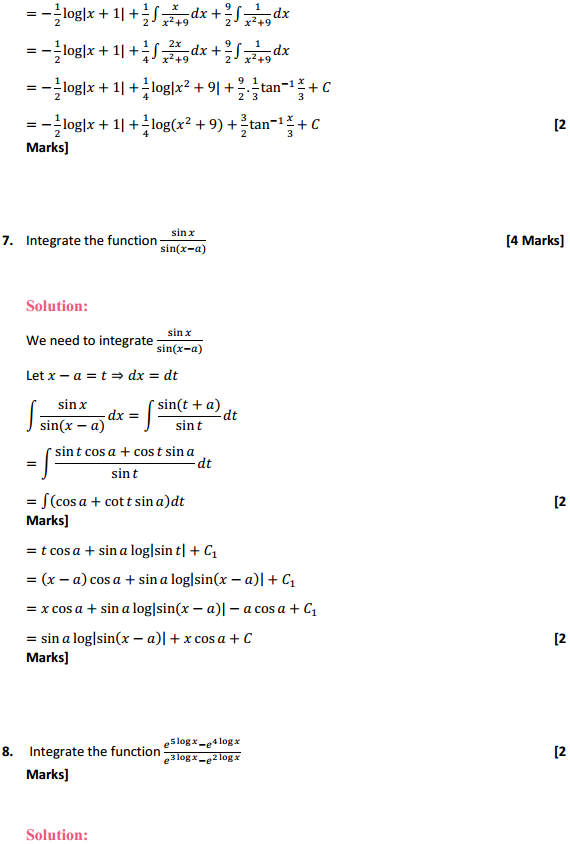
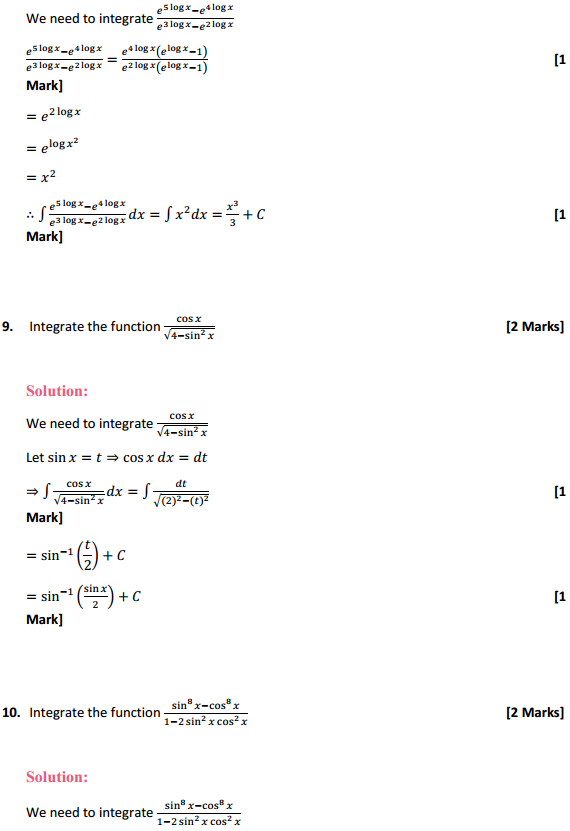
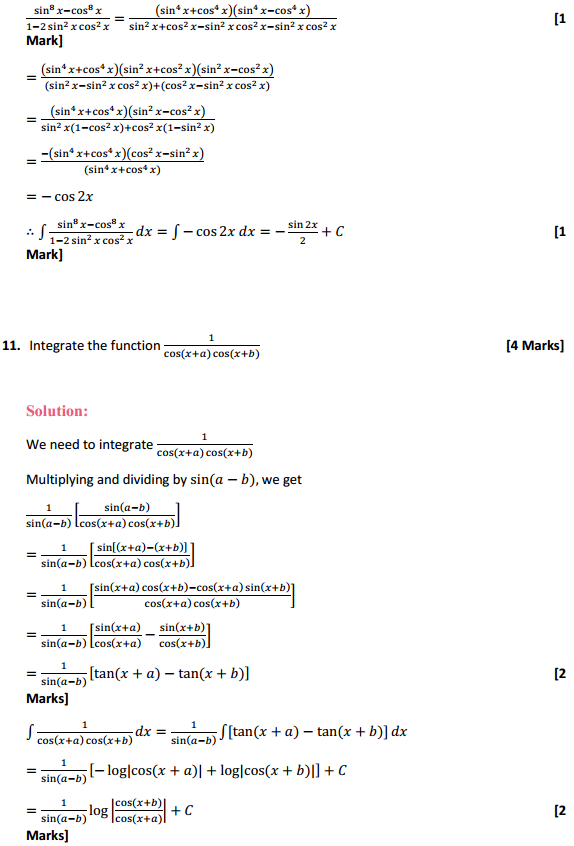
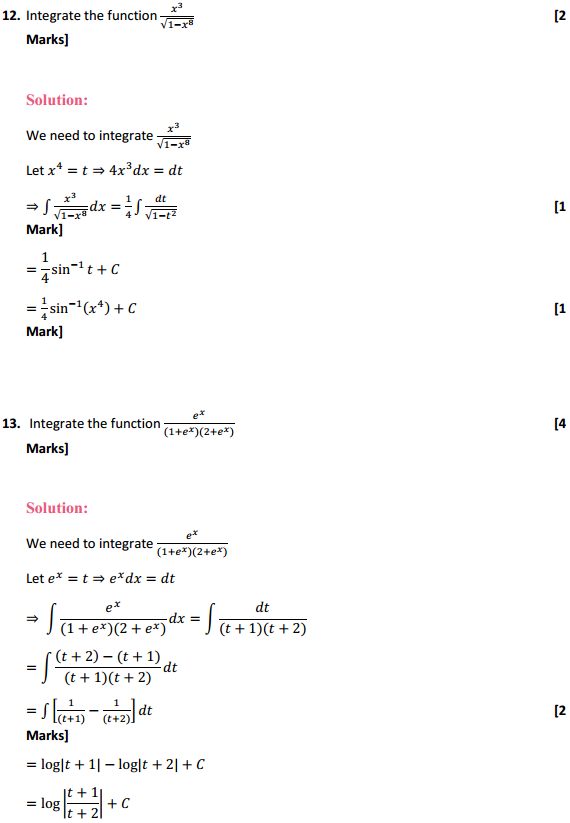
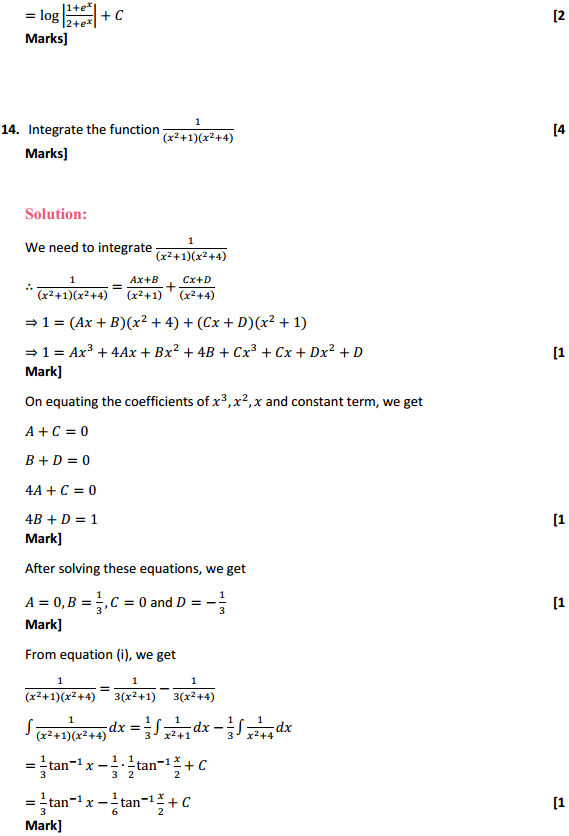
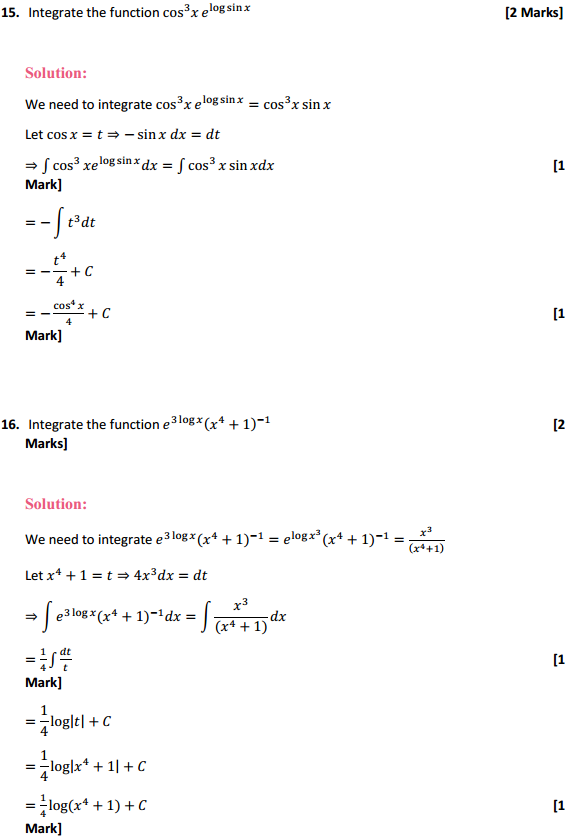

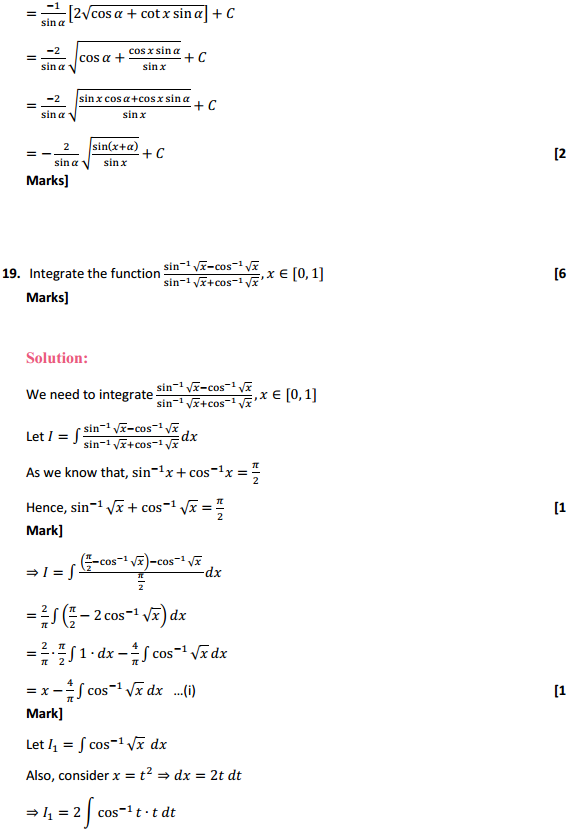
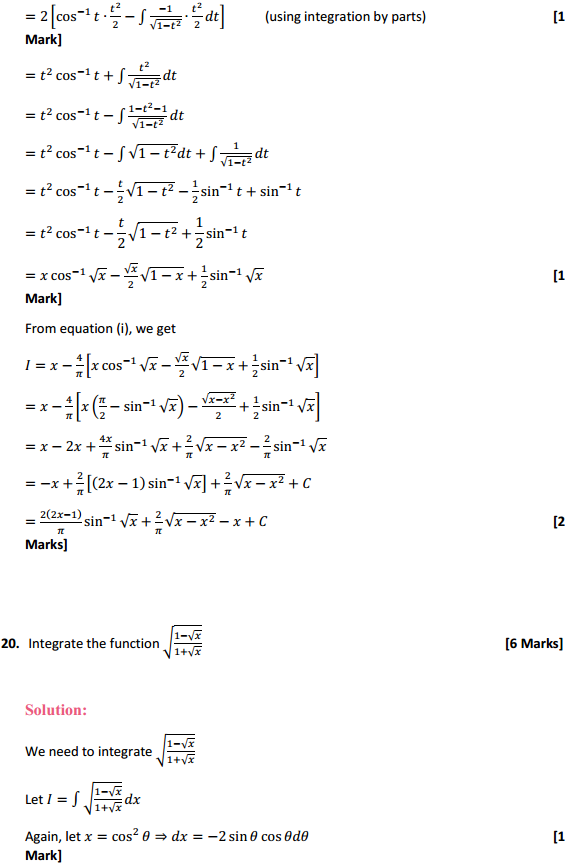
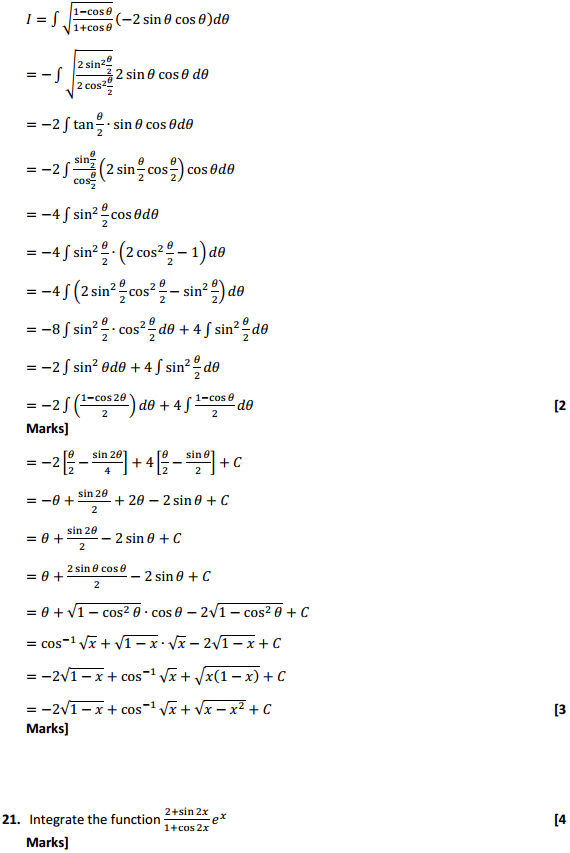
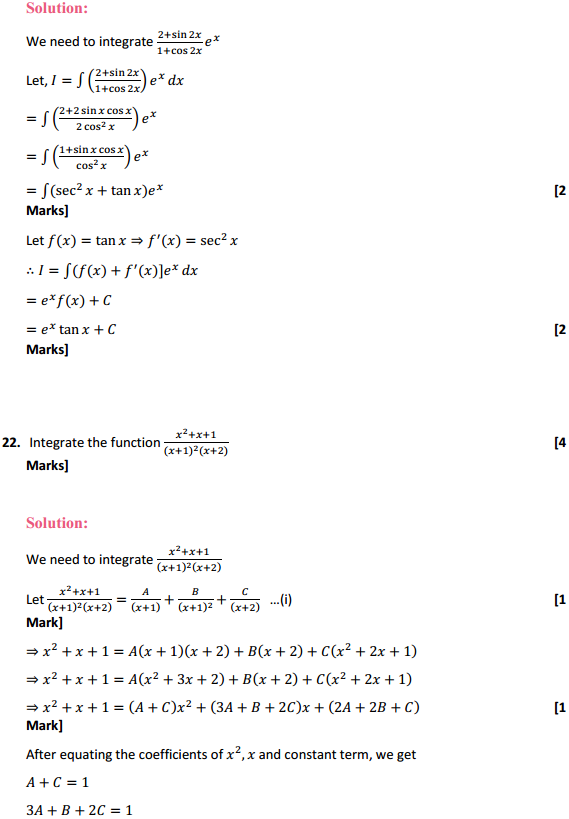
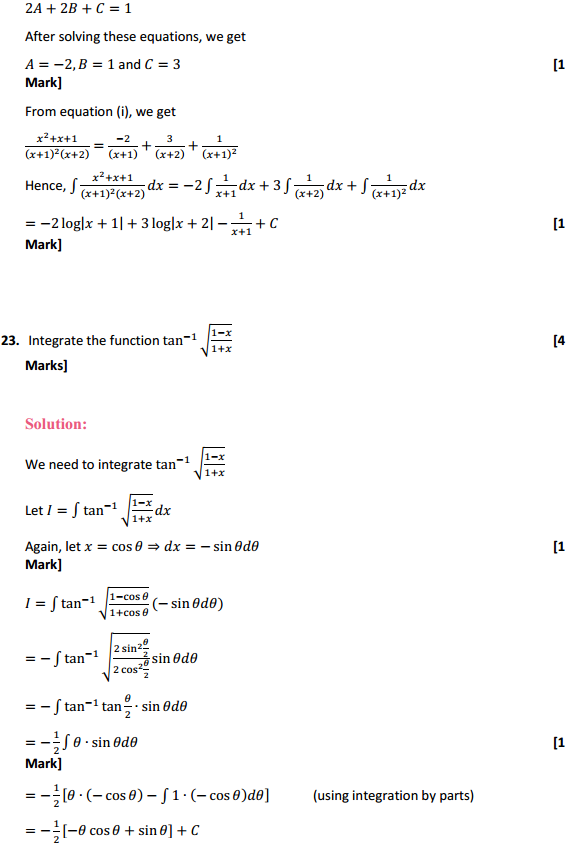
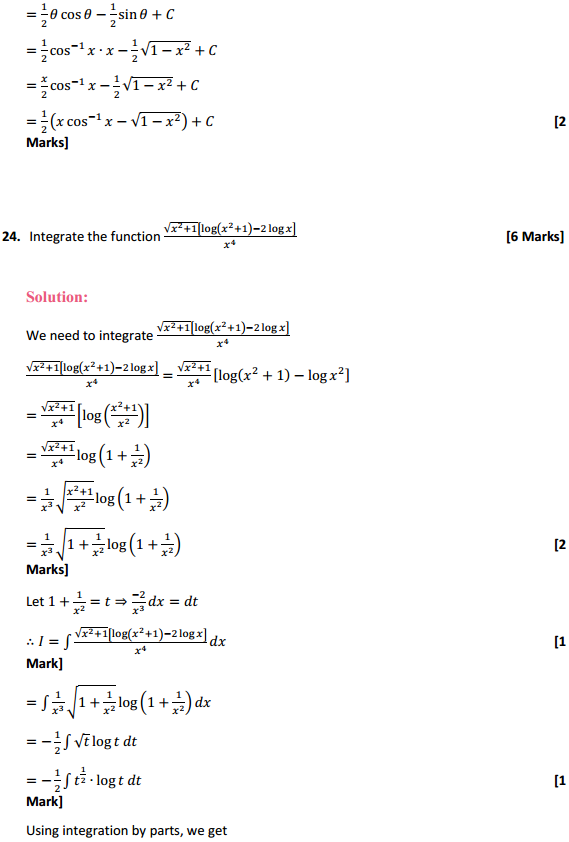
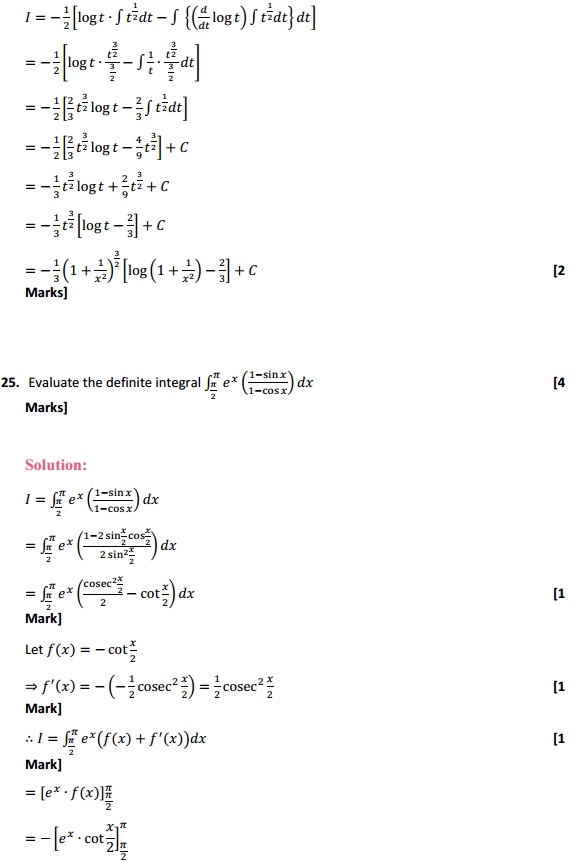
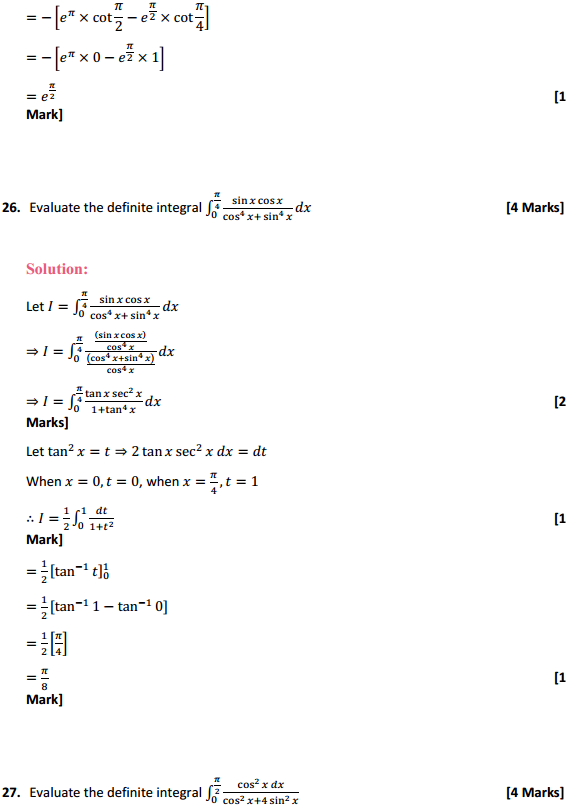
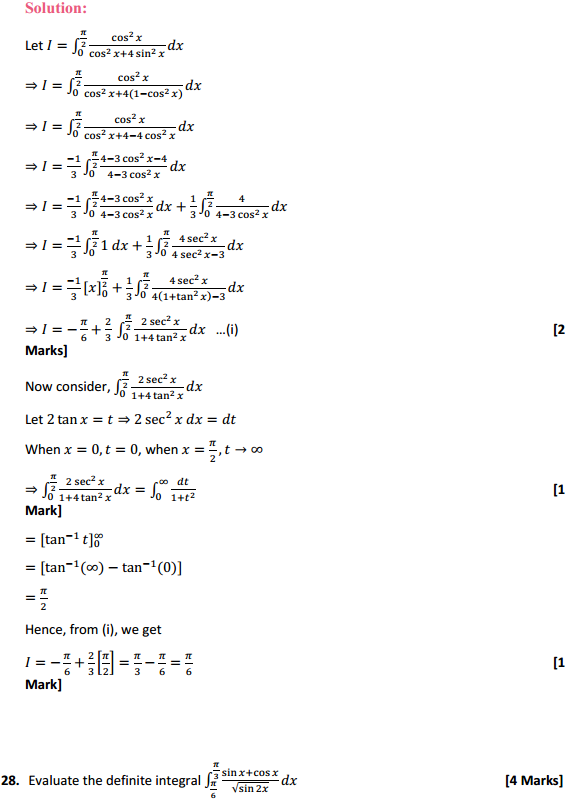
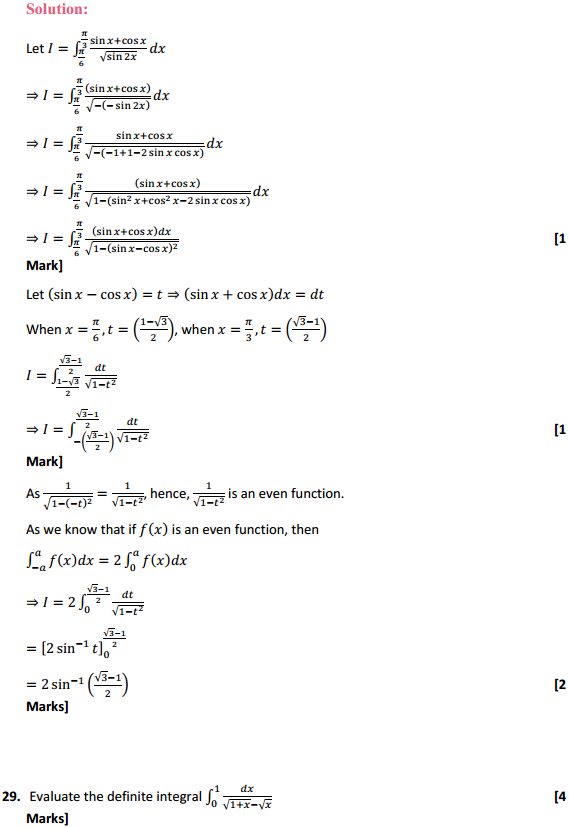
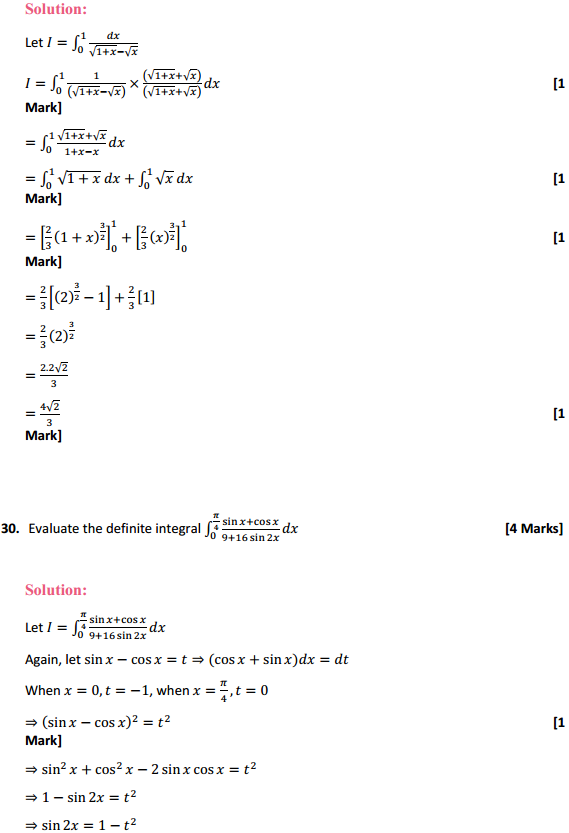

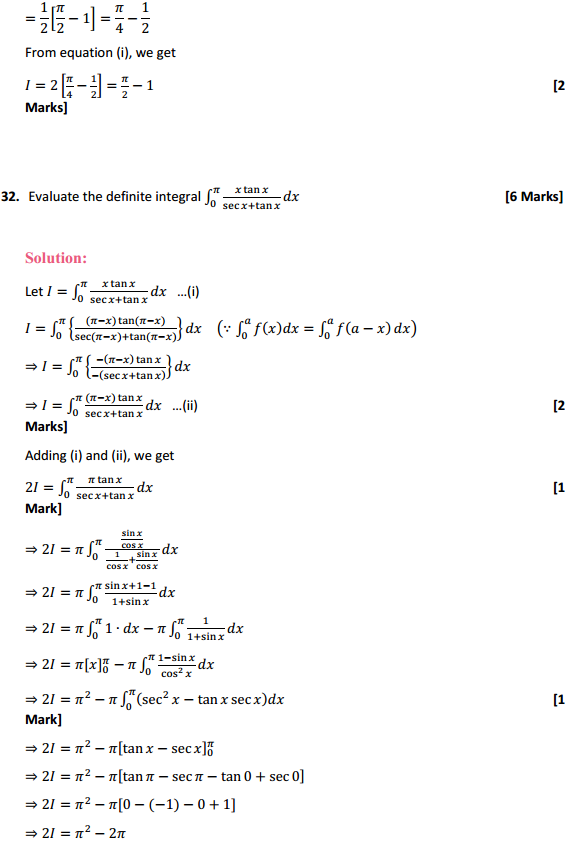
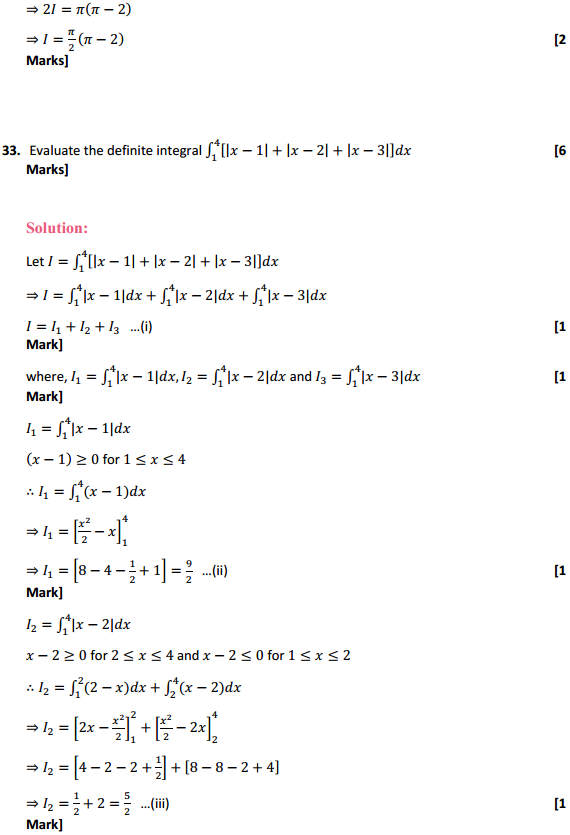
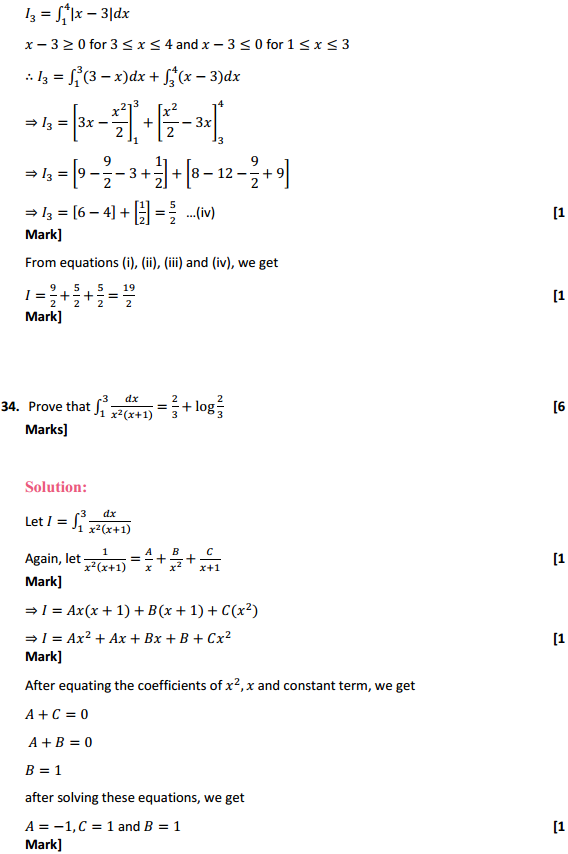

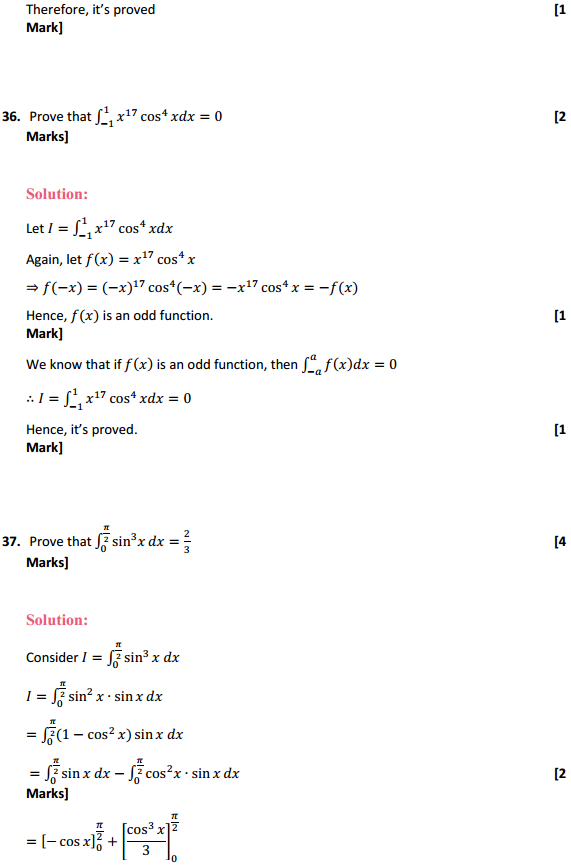

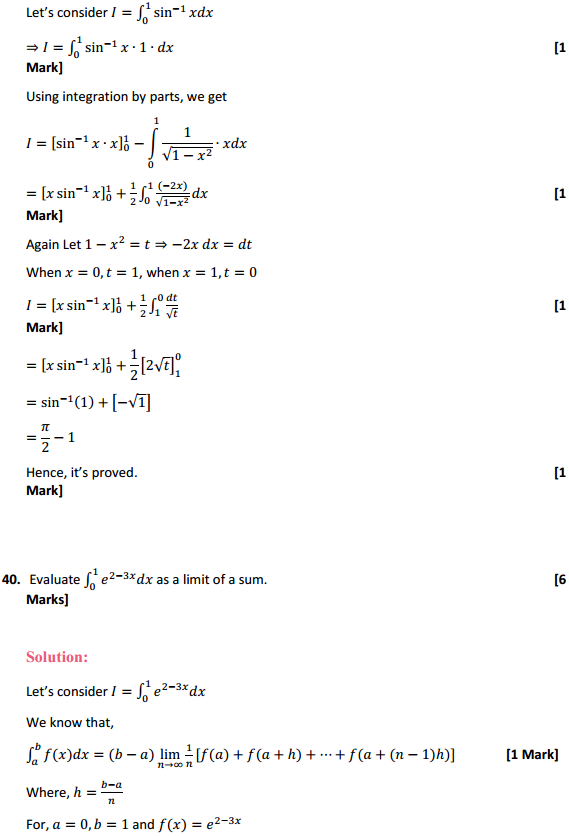

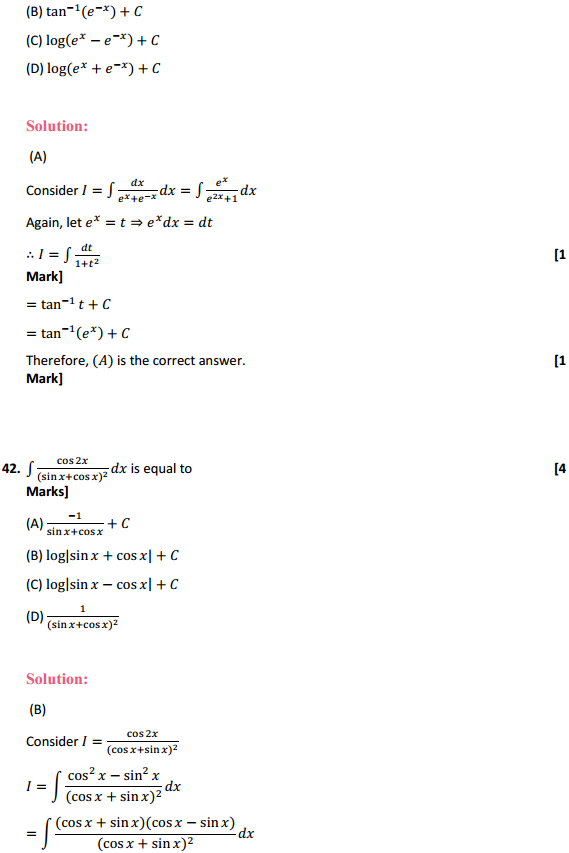
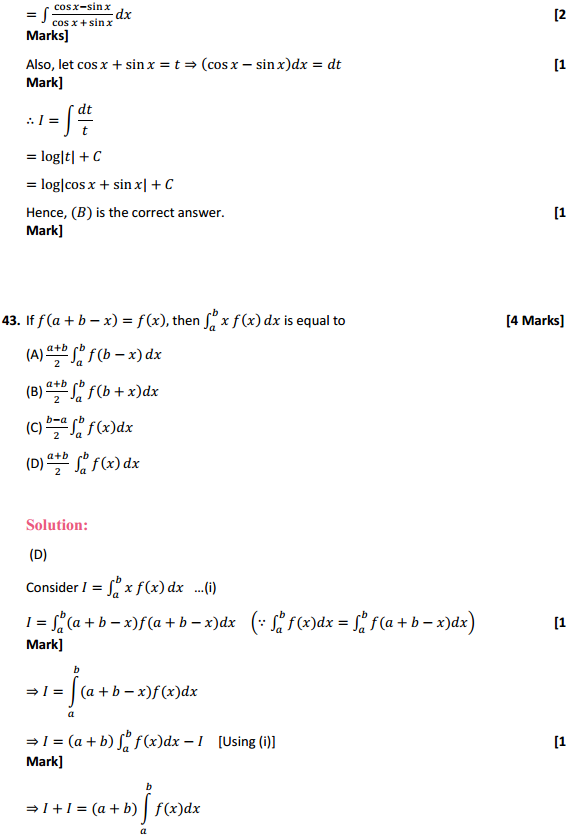
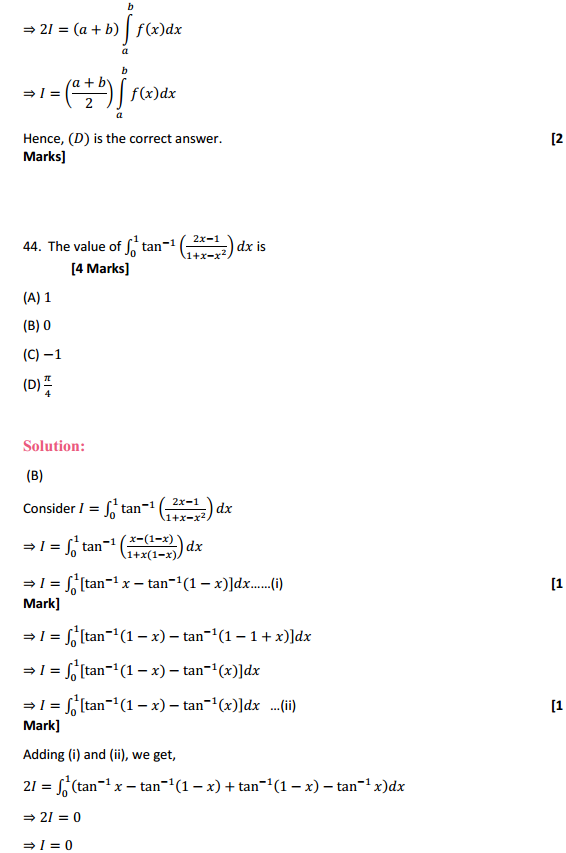
![]()
CBSE Class 12
Access Class 12 Maths NCERT Solutions Chapter 7 Integrals Miscellaneous Exercise, contains solutions for all Integrals Exercise Class 12 questions.



































![]()
These Solutions are part of NCERT Exemplar Solutions for Class 12 Biology. Here we have given NCERT Exemplar Solutions for Class 12 Biology chapter 13 Organisms and Populations
Multiple Choice Questions
Question 1.
Autecology is the
(a) relation of heterogenous population to its environment
(b) relation of an individual to its environ-ment
(c) relation of a community to its environ-ment
(d) relation of a biome to its environment.
Answer:
(a, b) : Ecology is the study of interactions among organisms and between the organisms and their biotic and abiotic environment. The study of reciprocal relationships between every stage of development of a population/ species/individual and its environment is called autecology.
Question 2.
Ecotone is
(a) a polluted area
(b) the bottom of a lake
(c) a zone of transition between two communi¬ties
(d) a zone of developing community.
Answer:
(c) : The adjacent biotic communities do not always have sharp lines of demarcation between them. There are usually transition zones, the ecotones, between them. An ecotone often has some populations from each adjacent community and some characteristic of itself. The total number of species in ecotone is generally greater than in the adjoining communities, a phenomenon called edge effect.
Question 3.
Biosphere is
(a) a component in the ecosystem.
(b) composed of the plants present in the soil
(c) life in the outer space
(d) composed of all living organisms present on earth which interact with the physical environment.
Answer:
(d) : Biosphere or ecosphere is self-sufficient system. It includes the earth’s atmosphere (air, land, water) that sustains life. In biosphere living organisms interact with their physical environment.
Question 4.
Ecological niche is
(a) the surface area of the ocean
(b) an ecologically adapted zone
(c) the physical position and functional role of a species within the community
(d) formed of all plants and animals living at the bottom of a lake.
Answer:
(c) : Ecological niche is specific part of habitat occupied by individuals of a species which is circumscribed by its range of tolerance, range of movement, microclimate, type of food and its availability, shelter, type of predator and timing of activity. Tadpole and adult frog occupy different ecological niches as the former is herbivorous aquatic while the latter is carnivorous amphibian.
Question 5.
According to Allen’s Rule, the mammals from colder climates have
(a) shorter ears and longer limbs
(b) longer ears and shorter limbs
(c) longer ears and longer limbs
(d) shorter ears and shorter limbs.
Answer:
(d) : According to Allen’s Rule, animals in colder climates generally have smaller extremities like shorter ears and limbs. It is a mechanism to conserve heat by checking heat loss from the body. Heat loss can be minimised by decreasing the surface area to volume ratio of body. In the polar regions, small animals are rarely found because of their high surface area and less volume.
Question 6.
Salt concentration (salinity) of the sea measured in parts per thousand is
(a) 10-5
(b) 30-70
(c) 0-5
(d) 30-35
Answer:
(d) : Salinity of water bodies is generally measured in parts per thousand. It determines what kind of organisms can live in it. Salinity of the sea is 30-35 parts per thousand, while for inland waters and some hypersaline lagoons it is less than 5 and more than 100 per thousand parts, respectively. Fresh water animals generally cannot. live for long in sea water and vice versa because of osmotic problems.
Question 7.
Formation of tropical forests needs mean annual temperature and mean annual precipitation as
(a) 18-25°C and 150-400 cm
(b) 5-15°C and 50-100 cm
(c) 30-50°C and 100-150 cm
(d) 5-15°C and 100-200 cm.
Answer:
(a) : Temperature and precipitation are generally most important climatic abiotic factors that influence the geographical distribution of plants. Average temperature decreases from equator to the poles. Precipitation includes rainfall, snow, dew, etc. Tropical forests, which are very productive, need 18 to 25°C mean annual temperature and 150-400 cm mean annual rainfall.
Question 8.
Which of the following forest plants controls the light conditions at the ground?
(a) Lianas and climbers
(b) Shrubs
(c) Tall trees
(d) Herbs
Answer:
(c) : In a forest, plants get arranged in various strata according to their shade tolerance. Tall trees form the canopy of the forest i.e., roof of the forest, thus, controlling the amount of light reaching the ground.
Question 9.
What will happen to a well growing herbaceous plant in the forest if it is transplanted outside the forest in a park?
(a) It will grow normally.
(b) It will grow well because it is planted in the same locality.
(c) It may not survive because of change in its microclimate.
(d) It grows very well because the plant gets more sunlight.
Answer:
(c) : Herbaceous plants are of small height. Since, this herbaceous plant is growing in forest, it must have been adapted to the light intensity reaching it, moisture in surrounding air and soil, soil characteristics, etc. This constitutes the microclimate of this plant. If this plant is transplanted to a park outside forest, this microclimate might get lost, partially or completely, because of which plant might not be able to survive.
Question 10.
If a population of 50 Paramecium present in pool increases to 150 after an hour, what would be the growth rate of population?
(a) 50 per hour
(b) 200 per hour
(c) 5 per hour
(d) 100 per hour
Answer:
(d). Population of Paramecium at time t = 50
Population of Paramecium 1 hour after t= 150
Growth rate of population = 150 – 50 per
hour = 100 per hour
Question 11.
What would be the percent growth or birth rate per individual per hour for the same population mentioned in the previous question (Question 10)?
(a) 100
(b) 200
(c) 50
(d) 150
Answer:
(b) : Initial number of Paramecium = 50
Number of Paramecium after 1 hour = 150 Birth rate

Question 12.
A population has more young individuals compared to the older individuals. What would be the status of the population after some years?
(a) It will decline.
(b) It will stabilise.
(c) It will increase.
(d) It will first decline and then stabilise.
Answer:
(c) : If in a population more young individuals are present as compared to older individuals, population will increase after some years. This is because of the reason that number of individuals in pre-reproductive age is high and thus, more number of individuals will enter the reproductive age in coming years. Such a population can be represented by an age structure forming an upright pyramid.

Question 13.
What parameters are used for tiger census in our country’s national parks and sanctuaries?
(a) Pug marks only
(b) Pug marks and faecal pellets
(c) Faecal pellets only
(d) Actual head counts
Answer:
(b) : In our country, parameters for tiger census in national parks and sanctuaries include both pug marks and faecal pellets. They can be used to determine the number as well as distribution of tiger population. New techniques of excreta DNA analysis and camera trappings are considered more accurate for tiger census.
Question 14.
Which of the following would necessarily decrease the density of a population in a given habitat?
(a) Natality > mortality
(b) Immigration > emigration
(c) Mortality and emigration
(d) Natality and immigration
Answer:
(c) : Population density in a given habitat is influenced by four processes :
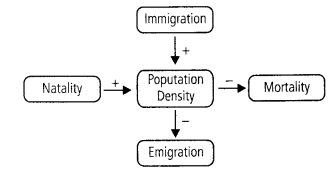
Question 15.
A protozoan reproduces by binary fission. What will be the number of protozoans in its population after six generations?
(a) 128
(b) 24
(c) 64
(d) 32
Answer:
(c) : By binary fission, an individual protozoan will divide in two. In this way after six generations their number will be 64.

Question 16.
In 2005, for each of the 14 million people present in a country, 0.028 were born and 0. 008 died during the year. Using exponential equation, the number of people present in 2015 is predicted as
(a) 25 millions
(b) 17 millions
(c) 20 millions
(d) 18 millions.
Answer:
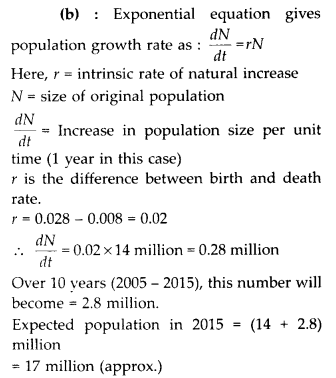
Question 17.
Amensalism is an association between two species where
(a) one species is harmed and other is benefited
(b) one species is harmed and other is unaffected
(c) one species is benefited and other is , unaffected
(d) both the species are harmed.
Answer:
(b) : Amensalism is the interaction between two populations in which oneis adversely affected, whereas other is apparently, neither harmed nor benefited. For example, Penicilliitm does not allow the growth of Staphylococcus bacterium by secreting certain chemicals.
Question 18.
Lichens are the associations of
(a) bacteria and fungus
(b) algae and bacterium
(c) fungus and algae
(d) fungus and virus.
Answer:
(c) : Lichens are association (mutually beneficial) between fungus and alga. The fungal partner is mycobiont and algal partner is phycobiont. Lichens can grow in extremely inhospitable conditions. In many ecosystems they are the pioneer species. The role of mycobiont is to provide body structure and anchorage and absorption of minerals and water. The role of phycobiont is to manufacture food through photosynthesis for itself and also for fungus.
Question 19.
Which of the following is a partial root parasite?
(a) Sandal wood
(b) Mistletoe
(c) Orobanche
(d) Ganoderma
Answer:
(a) : Parasites can be divided into : holo- parasitesandhemiparasites. Holoparasitesare those which are dependent on their host for all of their requirements, while hemiparasites are those, which receive only a part of their nourishment from host. Holoparasites and hemiparasites are also known as complete and partial parasites, respectively. Sandal wood is partial root parasite, which synthesises its own food but is dependent on host’s roots for water and inorganic nutrients. Mistletoe is partial stem parasite. Orobanche (Broomrope) is complete root parasite. Ganoderma, a fungus, is parasitic on hardwood.
Question 20.
Which one of the following organisms reproduces sexually only once in its lifetime?
(a) Banana plant
(b) Mango
(c) Tomato
(d) Eucalyptus
Answer:
(c) : Since tomato is an annual plant, so it reproduces sexually only once in its life time.
Very Short Answer Type Questions
Question 1.
Species that can tolerate narrow range of temperature are called …………
Answer:
stenothermal organisms
Question 2.
What are eurythermic species?
Answer:
Eurythermal organisms are those which can tolerate wide range of temperature variations, e.g., most mammals and birds.
Question 3.
Species that can tolerate wide range of salinity are called
Answer:
eurvhaline species
Question 4.
Define stenohaline species.
Answer:
Species which can tolerate only a narrow range of salinity are called stenohaline species e.g., sharks.
Question 5.
What is the interaction between two species called?
Answer:
The interaction between two species is called interspecific interaction, it can be positive, negative or neutral.
Question 6.
What is commensalism?
Answer:
Commensalism isanassociation between two organisms, in which one is benefited and second is neither harmed nor benefited. E.g., interaction between sucker fish and shark.
Question 7.
Name the association in which one species produces poisonous substance or a change in environmental conditions that is harmful to another species.
Answer:
In amensalism one organism inhibits the growth of the other. This inhibition is done by secreting chemicals called allochemics.
Question 8.
What is mycorrhiza?
Answer:
Symbiotic association between fungus and the roots of higher plants is called mycorrhiza. The fungus helps the plant in absorption of essential nutrients from the soil, while the plant in turn provides the fungus with energy yielding carbohydrates.
Question 9.
Emergent land plants that can tolerate the salinities of the sea are called .
Answer:
halophytes
Question 10.
Why do high altitude areas have brighter sunlight and lower temperatures as compared to the plains?
Answer:
Brighter sunlight at high altitudes is due to thinner air and less pollution. High altitudes have lower temperature because as we go higher, air pressure decreases that causes the temperature to be colder at high altitudes.
Question 11.
What is homeostasis?
Answer:
Homeostasis is the ability to maintain constant body temperature and osmotic concentration irrespective of the environmental conditions.
Question 12.
Define aestivation.
Answer:
The period of dormancy or suspended metabolism during summer months to escape from heat and unfavourable conditions is called aestivation or summer sleep, c.g., snails undergo aestivation to avoid heat and dessication.
Question 13.
What is diapause and its significance?
Answer:
Diapause is the stage of suspended development. During stress period, many zooplanktons and larvae of insects suspend their development and enter a stage of dormancy. They resume their growth during favourable conditions. This helps organisms to escape harsh, extreme conditions.
Question 14.
What would be the growth rate pattern, when the resources are unlimited?
Answer:
When resources like food, space, etc., are unlimited for a population, it grows in an exponential or geometric ratio resulting in a J-shaped growth curve, c.g., growth of algal bloom.
Question 15.
What are the organisms that feed on plant sap and other plant parts called?
Answer:
Organisms feeding on plant sap and other plant parts are called phytophagous.
Question 16.
What is high altitude sickness? Write its symptoms.
Answer:
High altitude sickness is experienced at high altitudes (> 3500 m) like Leh, Rohtang Pass, etc. It is due to low atmospheric pressure at high altitude due to which the body does not get enough oxygen. Its symptoms include nausea, fatigue, heart palpitation.
Question 17.
Give a suitable example for commensalism.
Answer:
The cattle egret and grazing cattle show an example of commensalism. The egrets always forage close to where cattle are grazing, because the cattle, as they move, stir up and flush out insects from the vegetation which are otherwise difficult for egrets to find and catch.
Question 18.
Define ectoparasite and endoparasite and give suitable examples.
Answer:
Ectoparasites live on the surface of the host. They suck blood (in animals), or juice (in plants), c.g., lice on humans and ticks on dogs.
Endoparasites live inside the body of host Most of them spend a part of their life cycle in another host. Their life cycle is more complex because of their extreme specialisation, c.g., Plasmodium in RBCs and Taenia solium in intestine.
Question 19.
What is brood parasitism? Explain with the help of an example.
Answer:
Brood parasitism is an example of parasitism in which the parasitic bird lays its eggs in the nest of its host and the host incubates them. During the course of evolution, the eggs of the parasitic bird have evolved to resemble the host’s eggs in size and colour to reduce the chances of the host bird detecting the foreign eggs and ejecting them from the nest. Most common example is koel whose female lays its eggs in the crow’s nest.
Short Answer Type Questions
Question 1.
Why are coral reefs not found in the regions from West Bengal to Andhra Pradesh but are found in Tamil Nadu and on the east coast of India?
Answer:
Coral reefs are found in zone with high salt concentration (salinity), optimal temperature and with a less siltation condition which fairly facilitate the corals to colonise. In case of high siltation and very high freshwater inflow, coral reefs do not colonise.
Question 2.
If a freshwater fish is placed in an aquarium containing sea water, will the fish be able to survive? Explain giving reasons.
Answer:
freshwater fish is placed in aquarium having sea water, then it would not be able to survive due to osmoregulatory problems. Outer hypertonic environment having high salt concentration would cause exosmosis and fish would die.
Question 3.
Why do all the freshwater organisms have contractile vacuoles whereas majority of marine organisms lack them?
Answer:
Osmotic concentration of freshwater organisms is hypertonic to the surrounding water. The water enters their body by endosmosis. Excess water is expelled out of the body through contractile vacuole. Osmotic concentration of most of the marine organisms is almost equal to surrounding water, i.e., isotonic to surroundings, therefore, they need pot expel extra water out of their body and hence lack contractile vacuole.
Question 4.
Define heliophytes and sciophytes. Name a plant from your locality that is either heliophyte or sciophyte.
Answer:
Plants adapted to bright light are known as heliophytes and are commonly called sun plants. E.g., sunflower.
Plants growing in partial shade or low intensity of light are called sciophytes or shade plants. E.g., money plant.
Question 5.
Why do submerged plants receive weaker illumination than exposed floating plants in a lake?
Answer:
There is a light zonation in deep lakes and oceans. Floating plants are found in upper part of lake and receive more light, however less light penetrates into deep lake and thus submerged plants receive weaker illumination of light.
Question 6.
In a sea shore, the benthic animals live in sandy, muddy and rocky substrata and accordingly developed the following adaptations.
(a) Burrowing
(b) Building cubes
(c) Holdfasts/peduncle
Find the suitable substratum against each adaptation.
Answer:
ln a sea shore, water current restrict distribution of organisms. In streamed areas of ocean, animals are strong swimmers or possess attaching organs such as pedunde, or live under stone, in burrows etc. Burrowing animals like tubeworm, Nereis are strong swimmers. Burrowing, building cubes and hold fast or penduncle are found in sandy muddy and rocky substratum respectively.
Question 7.
Categorise the following plants into hydrophytes, halophytes, mesophytes and xerophytes. Give reasons for your answer.
(a) Salvinia
(b) Opuntia
(c) Rhizophora
(d) Mangifera
Answer:
(a) Salvinia – Hydrophyte – Free floating aquatic plant
(b) Opuntia – Xerophyte – Grows in hot, dry conditions with less rainfall.
(c) Rhizophora – Halophyte – Grows in saline soil.
(d) Mangifera – Mesophyte – Grows in mesic (moderate) conditions with high moisture.
Question 8.
In a pond, we see plants which are free-floating; rooted-submerged; rooted emergent; rooted with floating leaves. Write the type of plants against each of them.”
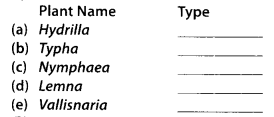
Answer:
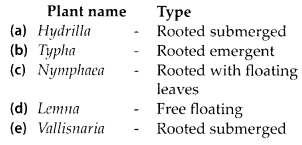
Question 9.
The density of a population in a habitat per unit area is measured in different units. Write the unit of measurement against the following:
(a) Bacteria …………
(b) Banyan …………
(c) Deer ………….
(d) Fish …………..
Answer:
(a) Bacteria – Number per unit volume
(b) Banyan tree – Biomass per unit area
(c) Deer – Number per unit area
(d) Fish – Weight per unit area
Question 10.
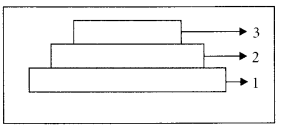
(a) Label the three tiers 1, 2, 3 given in the above age pyramid.
(b) What type of population growth is represented by the above age pyramid?
Answer:
(a)
1 – Pre-reproductive individuals
2 – Reproductive individuals
3 – Post-reproductive individuals
(b) Given age pyramid has broad base or triangular structure which indicates a rapidly expanding population with a high percentage of young individuals and only few old individuals.
Question 11.
In an association of two animal species, one is a termite which feeds on wood and the other is a protozoan Trichonympha present in the gut of the termite. What type of association they establish?
Answer:
Termites and Trichonympha show mutualistic relationship. Termites feed on wood though they do not possess enzymes for digesting the same. Termites harbour cellulose digesting flagellates (e.g., Trichonympha campanula) for this purpose. Flagellates are unable to live independently. Termites would die of starvation in the absence of flagellates.
Question 12.
Lianas are vascular plants rooted in the ground and maintain erectness of their stem by making use of other trees for support. They do not maintain direct relation with those trees. Discuss the type of association the lianas have with the trees.
Answer:
Lianas are woody vascular climbers. They maintain their erectness of stem by using the support of the tree without any direct relation with it. In this relation, lianas are benefited, but the tree neither gets benefit nor is harmed. It represents commensalism, in which one is benefited and other remains unaffected.
Question 13.
Give the scientific names of any two microorganisms inhabiting the human intestine.
Answer:
Escherichia coli and Lactobacillus are two microorganisms which inhabit human intestine.
Question 14.
What is a tree line?
Answer:
The tree line is the edge of the habitat till which trees are capable of growing. Beyond the tree line, trees cannot tolerate the environmental conditions, like, temperature, humidity. Beyond this limit trees are not found.
Question 15.
Define ‘zero population growth rate’. Draw a age pyramid for the same.
Answer:
When birth rate and death rate become equal and there is no increase in population, it is called zero population growth. It is obtained when the number of pre-reproductive and reproductive individuals is almost equal and post-reproductive individuals are comparatively

Question 16.
List any four characters that are employed in human population census
Answer:
Census is an official counting of population and preparing data considering various population characteristics, such as :
Question 17.
Give one example for each of the following types.
(a) Migratory animal
(b) Camouflaged animal
(c) Predator animal
(d) Biological control agent
(e) Phytophagous animal
(f) Chemical defence agent
Answer:
(a) Migratory animal – Arctic tern
(b) Camouflaged animal – Leaf insect
(c) Predator animal – Lion
(d) Biological control agent – Gambusia
(e) Phytophagous – Butterfly
(f) Chemical defense agent – Cardiac glycosides produced by Calotropis
18.
Fill in the blanks:
|
Species A |
Species B |
Type of Interaction | Example |
| + | – | ||
| + | + | ||
| + | Commensalism |
Answer:
|
Species A |
Species B |
Type of Interaction | Example |
| + | – | Predation | Tiger and Deer |
| + | + | Mutualism | Lichen |
| + | O | Commensalism | Sucker fish and shark |
Question 19.
Observe the set of 4 figures A, B, C and D and, answer the following questions.
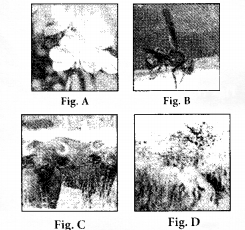
Answer:
Long Answer Type Questions
Question 1.
Comment on the following figures 1,2 and 3. A, B, C, D, G, P, Q, R and S are species.
Answer:
In fig. 1, all the individuals are of same species and show intraspecific competition. Here, all the members of species have similar requirements of food, light, water, space, shelter and mate.
In Fig. 2, there are individuals of three different species (A, B and C) and have interspecific competition. Here two or more populations usually belonging to same trophic level or feeding habit compete with one another for natural resources. E.g., tigers and leopards may compete for same prey in forest, trees, shrubs, herbs and vines compete for water, sunlight, nutrients, pollinators, etc.
In Fig. 3, three different biotic communities interact with one another and with their physical environment and exchange energy and material with surroundings. It represents a biome.
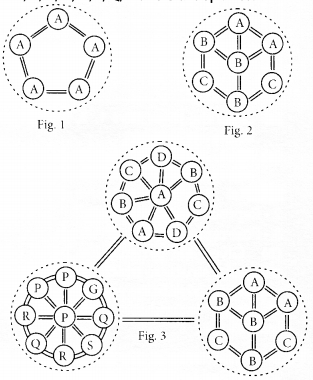
Question 2.
An individual and a population has certain characteristics. Name these attributes with definitions.
Answer:
An individual or an organism is the smallest unit of ecological hierarchy.Characteristics of an individual are :
Population is the total number of individuals of a species in a specific geogra¬phical area.
Characteristics of population are:
Question 3.
The following diagrams are the age pyramids of different populations. Comment on the status of these populations.

Answer:
Fig. A shows a triangular age pyramid. It indicates that number of individuals in pre-reproductive age group are much more than those in reproductive age group, which in turn are more than the individuals in post reproductive age group. This type of population shows rapid growth and is known as expanding population. Fig. B is a bell shaped age pyramid. Here, individuals in pre-reproductive age group and reproductive age group are almost same. Such population show the zero growth rate because death rate and birth rate are equal. The population is termed as stable or stationary population.
Fig. C shows an urn shaped age pyramid.
Here, . number of individuals in pre- reproductive age group are less than number of individuals in reproductive age group. Number of post-reproductive individuals is also sizeable. Death rate is more than the birth rate and this pyramid shows declining population.
Question 4.
Comment on the growth curve given below.
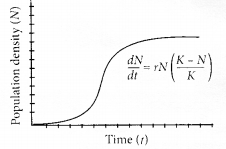
Answer:
The given growth model shows logistic growth, where the resources are limited and a given habitat can support certain number of individuals. The limit beyond which population cannot grow further is known as carrying capacity. Population shows sigmoid growth curve, (S-shaped curve) and has following phases – lag phase, log phase, exponential phase and stationary phase.
This population growth is called Verhulst – Pearl logistic growth, it has following equation :

where,
N = Population density at a time
K = Carrying capacity
r = Intrinsic rate of natural increase.
Question 5.
A population of Paramecium caudatum was grown in a culture medium. After 5 days the culture medium became overcrowded with Paramecium and had depleted nutrients. What will happen to the population and what type of growth curve will the population attain? Draw the growth curve.
Answer:
Paramecium caudatum when grown in a culture medium will show logistic or sigmoid growth curve. Such type of growth occurs when a population is growing in a habitat with ‘limited resources. The population of Paramecium initially shows a lag phase followed by phase of exponential growth as the nutrients and space will be abundant in nutrient medium. When the resources get depleted, the population density starts decreasing and finally the population density reaches carrying capacity beyond which no further growth is possible.
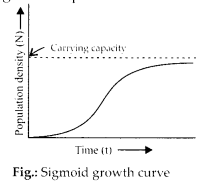
Question 6.
Discuss the various types of positive interactions between species.
Answer:
In positive population interactions, both members involved are either benefited or one is benefited and other remains unaffected. Types of positive interactions are as follows :
(1) Mutualism – An interaction between two organisms of different species where both the partners are benefited. Examples of symbiosis or mutualism are lichens, symbiotic nitrogen fixation, mycorrhizae etc.
Lichen is a composite entity which is formed jointly by an alga (phycobiont) and a fungus (mycobiont). The main body of the lichen is formed of fungus. The fungus also provides, water, minerals and shelter to the alga. The alga manufactures food not only for itself but also for the fungus. This interaction or relationship allows the lichen to grow in highly hostile environment like bare rock,
(2) Commensalism – It is the relationship between two living individuals of different species in which one is benefited while the other is neither harmed nor benefited except to a negligible extent. E.g., sucker fish attaches itself to the under-surface of shark with the help of its dorsal fin which is modified into holdfast. Sucker fish gets a free ride. It is widely dispersed and remains protected from its predators. Sucker fish detaches itself from shark w’hen the latter is feeding to obtain smaller pieces of food.
Question 7.
In an aquarium two herbivorous species of ‘fish are living together and feeding on phytoplanktons. As per the Gause’s principle, one of the species is to be eliminated in due course of time, but both are surviving well in the aquarium. Give possible reasons.
Answer:
According to Gause’s ‘Competitive Exclusion Principle’ two closely related species competing for same resources cannot co-exist indefinitely and the competitively inferior one will be eliminated eventually. If two herbivorous species of fish are co-existing in same ecological niche, then it might be possible that the two herbivorous species of fish may have developed different specialisations, i.e., they may have evolved mechanisms to encourage co-existence, e.g., resource partitioning.
Question 8.
While living in and on the host species, the animal parasite has evolved certain adaptations. Describe these adaptations with examples.
Answer:
Parasites living inside or outside the bodies of host species evolve certain special adaptations to have better survival. The few parasitic adaptations are as follow’s:
Question 9.
Do you agree that regional and local variations exist within each biome? Substantiate your answer with suitable example.
Answer:
Abiome is a major ecological communitv or complex of communities characterised by a major vegetation type and distinct landscape
characters. Different types of flora and fauna exist in a biome. Climate is the main factor that determines the type of soil which in turn determines the type of vegetation. The type of vegetation and climate together determine the type of animal population inhabiting the area. The organisms of a biome are adapted to the climatic conditions associated with the region. There are no distinct boundaries between adjacent biomes which merge gradually with each other.
World major biomes include tropical forests, savanna, deserts, polar regions, chaparral, temperate grasslands, temperate deciduous forests, coniferous forests and tundra. Each biome has regional and local variations so that there is wide variety of habitats and ecological niches. For example, the temperate broad leaf and mixed forests biome include a number of distinct ecoregions with characteristic species. In the south, the middle Atlantic coastal forest occupies the flat Atlantic coastal plain, from the eastern shore of Maryland and Delaware to just south of Georgia. The river swamp or bottom land forests in this ecoregion are dominated by majestic bald cypress and swamp tupelo. Farther north, the north eastern forest type is typified by white and red oak.
Question 10.
Which element is responsible for causing soil salinity? At what concentration does the soil become saline?
Answer:
The most important element responsible for causing soil salinity is Na present as NaCl in the soil. Chlorides, nitrates, sulphates and carbonates of potassium, magnesium and ^sodium; chlorides and nitrates of calcium are important elements to make soil more saline.
Question 11.
Does light factor affect the distribution of organisms? Write a brief note giving suitable examples of either plants or animals.
Answer:
Light is an important abiotic factor responsible for growth, development and distribution of plants. There are three parameters of light.
(1) Decreasing light intensity at various depths in ocean determines distribution of plants.
Green algae – found along the shoreline Brown algae – deeper level Red algae – Very deep in water
(2) Terrestrial communities are regulated by light. The dominant species occupy highest canopy level to utilise maximum light. The quantity and quality of light result in different types of plants growing in different areas in various states.
(3) Day length varies, when we move from equator to poles, it plays important role in plant distribution. According to duration of light available to the plants, they can be long day plants, short day plants or day neutral plants. The flowering period varies depending on the availability and duration of light.
Question 12.
Give one example for each of the following:
Answer:
We hope the NCERT Exemplar Solutions for Class 12 Biology chapter 13 Organisms and Populations help you. If you have any query regarding .NCERT Exemplar Solutions for Class 12 Biology chapter 13 Organisms and Populations, drop a comment below and we will get back to you at the earliest.
These Solutions are part of NCERT Exemplar Solutions for Class 12 Biology. Here we have given NCERT Exemplar Solutions for Class 12 Biology chapter 16 Environmental Issues
Multiple Choice Questions
Question 1.
Non-biodegradable pollutants are created by
(a) nature
(b) excessive use of resources
(c) humans
(d) natural disasters.
Answer:
(c) : Non-biodegradable pollutants are created by humans which effects our environment adversely They have the tendency to accumulate, as they are not degraded or broken down naturally into harmless compounds e.g. DDT (dichloro- diphenyl trichloroethane), BHC (Benzene hexachloride), polythene bags, etc.
Question 2.
According to the Central Pollution Control Efoard, particles that are responsible for causing great harm to human health are of diameter
(a) 2.50 micrometers
(b) 5.00 micrometers
(c) 10.00 micrometers
(d) 7.5 micrometers.
Answer:
(a) : Particulate matter causing air pollution is differentiated into settleable (larger than 10 pm) and suspended (less than 10 pm) particulate matter. According to CPCB, particles of 2.5 pm and lesser diameter are most harmful to human health as they can pass deep into lungs causing breathing and respiratory problems.
Question 3.
The material generally used for sound proofing of rooms like a recording studioand auditorium, etc is
(a) cotton
(b) coir
(c) wood
(d) styrofoam.
Answer:
(d)
Question 4.
Compressed Natural Gas (CNG) is
(a) propane
(b) methane
(c) ethane
(d) butane.
Answer:
(b) : Compressed Natural gas (CNG) is mostly methane. It is better alternative to petrol or diesel in terms of adverse effects on environment. In 2002, public transport vehicles in Delhi switched to CNG by the order of government as it bums more efficiently and cause lesser pollution.
Question 5.
World’s most problematic aquatic weed is
(a) Azolla
(b) Wolffia
(c) Eichhornia
(d) Trapa.
Answer:
(c) : Eichhornia crassipes (water hyacinth) is world’s most problematic aquatic weed, also called “Terror of Bengal”. Because of its very high rate of growth, it can cover the surface of whole water bodies, choke them and cause a threat to other aquatic life forms.
Question 6.
Which of the following causes biomagnification?
(a) SO2
(b) Mercury
(c) DDT
(d) Both (b) and (c)
Answer:
(d) : Biomagnification refer to increase in concentration of toxicant at successive trophic levels. This happens because a toxic substance accumulated by an organism cannot be metabolised or excreted, and is thus passed on to the next higher trophic level. This phenomenon is well-known for mercury and DDT.
Question 7.
The expanded form of DDT is
(a) dichloro diphenyl trichloroethane
(b) dichloro diethyl trichloroethane
(c) dichloro dipyrydyl trichloroethane
(d) dichloro diphenyl tetrachloroacetate.
Answer:
(a)
Question 8.
Which of the following material takes the longest time for biodegradation?
(a) Cotton
(b) Paper
(c) Bone
(d) Jute
Answer:
(c) : Bones are made up of proteins (mainly collagen), inorganic minerals (calcium, hydroxyapatite) and organic ground substance. Out of these four options bone degradation will take the longest time. Collagen, because of its unique structures in one of the most resistant proteins to degradation. Inorganic ions like Ca , further strengthen the bones.
Question 9.
Choose the incorrect statement.
(a) The Montreal protocol is associated with the control of emission of ozone depleting substances.
(b) Methane and carbon dioxide are greenhouse gases.
(c) Dobson units are used to measure oxygen content.
(d) Use 6f incinerators is crucial to disposal of hospital wastes.
Answer:
(c) : Dobson units (DU) are used to represent the concentration or thickness of ozone (03) in our atmosphere. 100 = lppb (parts per billion). Thickness of ozone is more over equators than over poles. Ozone layer in stratosphere protects us from the harmful effects of UV radiation (including skin cancer, inflammation of cornea etc).
Question 10.
Among the following which one causes more indoor chemical pollution?
(a) Burning coal
(b) Burning cooking gas
(c) Burning mosquito coil
(d) Room spray
Answer:
(a) : Among the given four options, both burning of coal and burning of mosquito coil will cause chemical pollution, but burning of coal will cause more pollution. The main ingredient in mosquito coils is pyrethrum C (a natural extract from the chrysanthemum flower). At high doses, it is responsible for various respiratory disorders. The coal leads to release of a wide array of air pollutants (COX, SOX, NOX etc.). Among these CO is very dangerous, it interfer with breathing process. People are generally advised not to sleep with coal burning in the closed room.
Question 11.
The green scum seen in the fresh water bodies is
(a) blue green algae
(b) red algae
(c) green algae
(d) both (a) and (c).
Answer:
(d) : The green scum seen in water bodies includes both green algae as well as blue-green algae. The excessive growth of such bloom forming algae is mainly because of presence of phosphates or nitrates in the water body (eutrophication). Such algal blooms can choke the water body. Green algae and blue-green algas (cyanobacteria) both are photosynthetic and decrease the dissolved oxygen content of water body. This kills much of flora and fauna of that water body. Later on, when microorganisms decompose these algae, further reduction in dissolved oxygen occurs.
Question 12.
The loudness of a sound that a person can withstand without discomfort is about
(a) 150 db
(b) 215 db
(c) 30 db
(d) 80 db.
Answer:
(d)
Question 13.
The major source of noise pollution, world wide is due to
(a) office equipment
(b) transport system
(c) sugar, textile and paper industries
(d) oil refineries and thermal power plants.
Answer:
(b)
Question 14.
Match correctly the following and choose the correct option
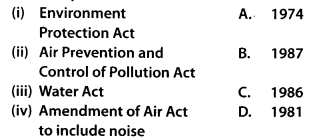
The correct matches is
(a) (i) – C, (ii) – D, (iii) – A, (iv) – B
(b) (i) – A, (ii) – C, (iii) – B, (iv) – D
(c) (i) – D, (ii) – A, (iii) – B, (iv) – C
(d) (i) – C, (ii) – D, (iii) – B, (iv) – A
Answer:
(a)
Question 15.
Catalytic converters are fitted into automobiles to reduce emission of harmful gases. Catalytic converters change unburnt hydrocarbons into
(a) carbon dioxide and water
(b) carhon monaaxide
(c) methane .
(d) carbon dioxide and methane.
Answer:
(a) : Catalytic converters are fitted ‘ into automobiles for reducing emission of poisonous gases. Rhodium and PlatinumPalladium are examples of catalysts used in catalytic converters. They convert unburnt hydrocarbons into carbon dioxide and water and carbon monoxides to CO2 and nitric oxide to N2 gas.
Question 16.
Why is it necessary to remove sulphur from petroleum products?
(a) To reduce the emission of sulphur dioxide in exhaust fumes.
(b) To increase efficiency of automobiles + engines.
(c) To use sulphur removed from petroleum for commercial purposes.
(d) To increase the life span of engine silencers.
Answer:
(a) : By removing sulphur from petrol and diesel, the emission of SO2 can be reduced , in exhaust. SO2 is a very harmful air pollutant. It can damage the vegetation by causing ,chlorosis. It can cause acid rain (by forming H2SO3 and H2SO4), damaging buildings and plants. In human beings it can cause irritation in eyes and damage to respiratory system (e.g. bronchitis).
Question 17.
Which pne of the following impurities is easiest to remove from wastewater?
(a) Bacteria
(b) Colloids
(c) Dissolved solids
(d) Suspended solids
Answer:
(d) : Suspended solids are relatively easier to remove from waste water. They constitute mainly sand, silt and clay. Most of these solids tend to settle if waste water is left undisturbed for sometime. They can be separated easily by physical means. Dissolved solids, both organic and inorganic (nitrates, phosphates etc) as well as bacteria and colloids are relatively difficult to separate.
Question 18.
Which one of the following diseases is not due to contamination of water?
(a) Hepatitis-B
(b) Jaundice
(c) Cholera
(d) Typhoid
Answer:
(a) : Hepatitis-B is caused by Hepatitis-B virus. It can be transmitted through blood transfusion, sexual contact, saliva and sharing of razors. It is not transmitted through contamination of water, as is the case with the rest of diseases.
Question 19.
Nuisance growth of aquatic plants and bloom forming algae in natural waters is generally due to high concentrations of
(a) carbon
(b) sulphur
(c) calcium
(d) phosphorus.
Answer:
(d) : Phosphorus in the form of phosphates as well as nitrates act as nutrients for the bloom-forming algae. Increased growth of algae because of these pollutants added to water bodies by human activities is called as cultural eutrophication. This literally, chokes the water body and lead to death of the organisms. Decomposition of these algae as well as dead water organisms, further deplete the dissolved oxygen content in water.
Question 20.
Algal blooms impart a distinct colour to water due to
(a) their pigments
(b) excretion of coloured substances
(c) formation of coloured chemicals in water facilitated by physiological degradation of algae
(d) absorption of light by algal.cell wall.
Answer:
(a) : Algal blooms are considered as pollutants of water, as they have very damaging effects on flora and fauna of that water body. They mostly consist of green algae and blue-green algae. The colour imparted by them depends on the colour of major pigment in them. For e.g., chlorophyll imparts the characteristic green colour. Also refer answer 19.
Question 21.
Match the items in Column-1 and Column-ll and choose the correct option.
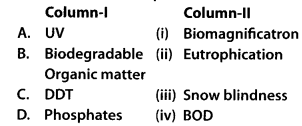
The correct match is:
(a) A-(ii), B-(i), C-(iv), D-(iii)
(b) A-(iii), B-(ii), C-(iv), D-(i)
(c) A-(iii), B-(iv), C-(i), D-(ii)
(d) A-(iii), B-(i), C-(iv), D-(i)
Answer:
(c)
Question 22.
In the textbook you came across Three Mile island and Chernobyl disasters associated with accidental leakage of radioactive wastes. In India we had Bhopal gas tragedy. It is associated with which of the following?
(a) CO2
(b) Methyl Isocyanate
(c) CFC’s
(d) Methycyanate
Answer:
(b) : In the night of December 2-3, 1984, gas clouds of methyl isocyanate (MIC) formed in Bhopal, Madhya Pradesh. The cause was leakage from the pesticide plant in union carbide India limited. The gas had acute health effects as well as long term effects. The acute effects lead to the death of more than 3000 people. Acute effects included suffocation, vomiting, pulmonary oedema as well as cerebral oedema.
Very Short Answer Type Questions
Question 1.
Use of lead-free petrol or diesel is recommended to reduce the pollutants emitted by automobiles. What role does lead play?
Answer:
Lead inactivates catalyst of the catalytic converter.
Question 2.
In which year was the Air (Prevention and Control of Pollution) Act amended to include noise as air pollutant.
Answer:
In 1987 the Air (prevention and control of pollution) act amended to include noise as air pollutant.
Question 3.
Name the city in our country where the entire public road transport runs on CNG.
Answer:
In Delhi the entire public road transport runs on CNG.
Question 4.
It is a common practice to undertake desilting of the overhead water tanks. What is the possible source of silt that gets deposited in the water tanks?
Answer:
The source of silt that get deposited in overhead water tank are soil particles, which are carried out with water from the source of supply like rivers etc.
Question 5.
What is cultural eutrophication?
Answer:
Ageing of lake at a faster rate due to presence of large amount of industrial and agricultural waste and domestic sewage produced as a result of human activities is called cultural or accelerated eutrophication.
Question 6.
List any two adverse effects of particulate matter on human health.
Answer:
The adverse effect of particulate matter on human health are:
Question 7.
What is the raw material for polyblend?
Answer:
Any plastic waste is the raw material for polyblend.
Question 8.
Blends of polyblend and bitumen, when used, help to increase road life by a factor of three. What is the reason?
Answer:
Polyblend is a fine powder of recycled modified plastic. Polyblend prepared from plastic film waste increases the water repelling property of bitumen, which increases the life of roads to three times.
Question 9.
Mentfon any two examples of plants used as wind breakers in the agricultural fields.
Answer:
Question 10.
Name an industry which can cause both air and thermal pollution and as well as eutrophication.
Answer:
Fertiliser industry can cause both air and thermal pollution and as well as eutrophication.
Question 11.
What is an algal bloom?
Answer:
Excess of nitrates and phosphates from fertilisers rundown into ponds, lakes, streams which led to thick growth of planktonic algae called algal bloom. The scum formed is blue green in colour. It is toxic and leads to suffocation of aquatic organisms.
Question 12.
What do you understand by biomagnification?
Answer:
Biomagnification is increase in concentration of certain toxic chemicals in successive trophic levels of a food chain, this phenomenon is well-known for DDT and mercury etc.
Question 13.
What are the three major kinds of impurities in domestic wastewater?
Answer:
Three major kinds of impurities in domestic wastewater are :
Question 14.
What is reforestation?
Answer:
Process of restoring of a forest that once existed but was removed at some point of time in the.past is known as reforestation.
Question 15.
What is the best solution for the treatment of electronic wastes?
Answer:
Evencs is a scientific method of treating e-wastes in an environment friendly manner.
Short Answer Type Questions
Question 1.
Is it true carpets and curtains/ drapes placed on the floor or wall surfaces can reduce noise level. Explain briefly?
Answer:
Yes, it is true that carpets and curtain/ drapes reduce the noise pollution, because being porous in nature they absorb sound and recluce the noise level.
Question 2.
What is hybrid vehicle technology?. Explain its advantages with a suitable example?
Answer:
Technology that involves running of vehicles at dual mode of fuel i.e. Petrol and CNG, is known as hybrid vehicle technology.CNG is a better fuel because it is completely combustible and produces less pollutants. CNG also helps in conservation of fossil fuels.
Question 3.
Is it true that if the dissolved oxygen level drops to zero, the water will become septic. Give an example which could lower the dissolved oxygen content of an aquatic body.
Answer:
Yes, it is true that when the level of dissolved oxygen drops to zero, the water becomes septic. This happens when the amount of organic waste becomes very high and almost all the oxygen content is completely utilised by decomposers. E.g., addition of sewage water in a water body lowers 02 level.
Question 4.
Name any one green house gas and its possible source of production on a large scale. What are the harmful effects of it?
Answer:
Major green house gases are CO2– 60%, CH4-20%, CFCS-14% and N2O-6%. Out of which CO2 is present in maximum amount. Source of CO2 is burning of fossil fuels, volcanic eruptions and respiration process. Due to increased level of CO2 in the atmosphere global atmospheric temperature during the past century has increased to 0.6%. It is called global warming, which results in melting of polar ice caps and rise in sea level etc.
Question 5.
It is a common practice to plant trees and shrubs near the boundary walls of buildings. What purpose do they serve?
Answer:
Growing of plants near the boundary wall of jauildings is known as Green muffler scheme, which reduces the noise pollution by absorbing sound. They also help in trapping of dust particles.
Question 6.
Why has the National Forest Commission of India recommended a relatively larger forest cover for hills than for plains?
Answer:
National Forest Commission has recommended 33% forest cover for plains and 67% forest cover for hills (1988) in his National Forest Policy. Because, forest are responsible for controlling soil erosion, land slides and moderate the climate whereas plains provide land for human settlements.
Question 7.
How can slash and burn agriculture become environment friendly?
Answer:
In slash and burn agriculture, the farmers cut down the trees of the forest and burn the plant remains. The ash is used as a fertiliser and land is used for farming or cattle grazing. After that area is left for several years for recovery. Slash and burn agriculture can become environment friendly if rows of trees and shrubs are left intact, while clearing the area for cultivation which will prevent soil erosion and invasion of weeds. There will be quicker recovery of forest after the area is abandoned.
Question 8.
What is the main idea behind ” Joint Forest Management Concept” introduced by the Government of India?
Answer:
Joint forest management (JFM) committees are set up with joint effort of Government and local communities for protecting and managing forests in sustainable manner. Village communities work together with the government as share the benefits. Presently, there are 84632 JFM committees with 17.33 million hectare forest area under them. Around 85.28 lakh families are involve in them all over the country.
Question 9.
What do you understand by Snow-blindness?
Answer:
Snow blindness is a temporary blindness caused by inflammation of cornea due to absorption of UV-B radiations. It leads to diminishing of eye sight, photoburning and later permanent damage to cornea that results in actual cataract.
Question 10.
How has DDT caused decline in bird population?
Answer:
DDT is a persistent pollutant. Excessive use of DDT, increases its concentration in successive trophic levels in food chain due to its accumulation in fat. This phenomenon is known as biomagnification. High concen-tration of DDT distrub calcium metabolism in birds, which causes thinning of egg shell and their premature breaking that kills embryos eventually causing decline in bird population.
Question 11.
Observe the figure A and B given below and answer the following questions.
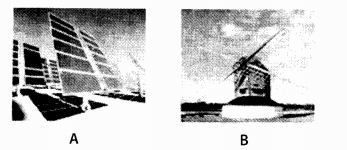
(1) The power generation by the above two methods is non-polluting—True/False.
(2) List any two applications of solar energy.
(3) What is a photovoltaic cell?
Answer:
Long Answer Type Questions
Question 1.
Write a short note on electronic waste. List the various sources of e-wastes and the problems associated with its disposal.
Answer:
Irreparable computers and other electronic goods are known as electronic wastes (e-wastes). Electronic waste is produced by damaged or discarded electronic goods, computer parts, keyboard, monitor, mouse, central processing unit (CPU) etc. Most of e-waste is dumped at landfill sites. The e-waste consists of lead and mercury etc, which may get leaked into soil water. e-wraste should be disposed off either by incineration or pyrolysis or should be recycled.
Unlike developed countries, which have specifically built facilities for recycling of e-waste, in developing countries it is done manually. Thus workers are exposed to toxic substances present in e-waste. Recycling seems to be the best solution for treatment of e-waste provided it is carried out in eco- friendlv manner.
Question 2.
What is organic farming? Discuss the benefits of organic farming as a viable practice in the context of developing nations like India.
Answer:
Organic farming is a cyclical, zerowaste procedure where waste products from one process are cycled in as nutrients for other processes. This allows maximum utilisation of resources and increases the efficiency of production.
The land is cultivated by using techniques such as crop rotation, green manure, composting, biofertilisers and biopesticides etc. In developing nations like India, organic farming is important to meet the food demand, we are using excessive chemical fertilisers which are polluting our soil and water resources.
Benefits of organic farming :
Question 3.
Water logging and soil salinity are some of the problems that have come in the wake of the Green Revolution. Discuss their causes and adverse effects to the environment.
Answer:
Water logging is submerging of land under water. Water logging is caused by excessive irrigation, Kutcha irrigation channels, presence of impermeable under-ground soil pans and improper drainage of water during irrigation. Besides affecting the crops, water logging draws salt to the surface of soil. Salt is deposited as a thin crust on the land surface, which leads to soil salination.
This decreases absorption capacity of water and mirterals by the root system of plants. Adverse effects :
Question 4.
What are multipurposetrees? Give the botanical and local names of any two multipurpose trees known to you and list their uses.
Answer:
Multipurpose trees are the trees that are deliberately grown and managed for more than one output. They supply food to us but at the same time supplies firewood or add nitrogen to the soil or supplies some other combination of multiple outputs.
Question 5.
What are the basic characteristics of a modern landfill site. List any three and also mention the reasons for their use.
Answer:
Characteristics of modern landfill include:
Question 6.
How does an electrostatic precipitator work?
Answer:
Electrostatic precipitators (ESPs) are most widely used devices to separate the particulate matter on the basis of charges. It can remove over 99% of particulate matter present in the exhaust from a thermal power plant. It has electrode wires that are maintained at several thousand volts, which produce a corona that releases electrons. These electrons attach to dust particles giving them a net negative charge. The collecting plates are grounded and attract the charged dust particles. The velocity of air between the
Question 7.
Observe figure and answer the following questions.
(1) What ecological term is used to describe the DDT accumulation at different trophic levels?
(2) List any one effect of DDT accumulation on birds.
(3) Will DDT accumulation lead to eutrophication?
(4) Does it affect the BOD?
(5) Name disease caused by accumulation of any heavy metal.
Answer:
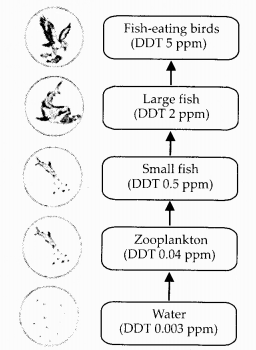
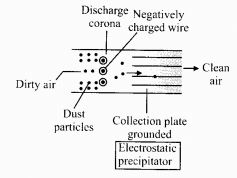
We hope the NCERT Exemplar Solutions for Class 12 Biology chapter 16 Environmental Issues help you. If you have any query regarding .NCERT Exemplar Solutions for Class 12 Biology chapter 16 Environmental Issues, drop a comment below and we will get back to you at the earliest.
These Solutions are part of NCERT Exemplar Solutions for Class 12 Biology. Here we have given NCERT Exemplar Solutions for Class 12 Biology chapter 12 Biotechnology and Its Applications
Multiple Choice Questions
Question 1.
Bt cotton is not
(a) a GM plant
(b) insect resistant
(c) a bacterial gene expressing system
(d) resistant to all pesticides.
Answer:
(d) : Several transgenic plants have been developed. One such plant is Bt cotton in which the Bt toxin from the bacterium Bacillus thuringiensis has been used as a biological insecticide. The choice of genes depends upon the crop and targeted pest. Bt cotton is resistant to insects but is not pesticide resistant.
Question 2.
C-peptide of human insulin is
(a) a part of mature insulin molecule
(b) responsible for formation of disulphide bridges
(c) removed during maturation of pro-insulin to insulin
(d) responsible for its biological activity.
Answer:
(c) : In mammals, including humans, insulin is synthesized as a pro-hormone which needs to be processed before it becomes a fully mature and functional hormone. It contains an extra, stretch called the C peptide which is removed during maturation into insulin.
Question 3.
GEAC stands for
(a) Genome Engineering Action Committee
(b) Ground Environment Action Committee
(c) Genetic Engineering Approval Committee
(d) Genetic and Environment Approval Committee.
Answer:
(c) : Genetic modification of organisms can have unpredictable results when such organisms are introduced into the ecosystem. Therefore, the Indian Government has set up organizations such as GEAC (Genetic Engineering Approval Committee), which makes decisions regarding the validity of GM research and the safety of introducing GM- organisms for public services.
Question 4.
a-1 antitrypsin is
(a) an antacid
(b) an enzyme
(c) used to treat arthritis
(d) used to treat emphysema.
Answer:
(d) : Disorders of a-l-antitrypsin protein include a-l-antitrypsin deficiency, an autosomal, codominant hereditary disorder in which deficiency of a-l-antitrypsin leads to a chronic uninhibited tissue breakdown. This causes the degradation of lung tissue, and eventually leads to characteristic manifestations of pulmonary emphysema.
Question 5.
A probe which is a molecule used to locate specific sequences in a mixture of DNA or RNA molecules could be
(a) a single stranded RNA
(b) a single stranded DNA
(c) either RNA or DNA
(d) can be ss DNA but not ss RNA.
Answer:
(a, b) : The molecular probes are usually single stranded pieces of DNAs (sometimes RNAs) labelled with radio isotopes such phosphorus-32. Molecular probes are available for many genetic disorders such as Duchenne muscular dystrophy, cystic fibrosis, Tay-Sachs disease.
Question 6.
Choose the correct option regarding retrovirus.
(a) An RNA virus that can synthesise DNA during infection.
(b) A DNA virus that can synthesise RNA during infection.
(c) A ssDNA virus.
(d) A dsRNA virus.
Answer:
(a) : A retrovirus is a ssRNA virus that stores its nucleic acid in the form of an mRNA genome and targets a host cell as an obligate parasite. Once inside the host cell cytoplasm, the virus uses its own reverse transcriptase enzyme to produce DNA from its RNA genome (the reverse of usual pattern, thus retro).
Question 7.
The site of production of ADA in the body is
(a) erythrocytes
(b) lymphocytes
(c) blood plasma
(d) osteocytes.
Answer:
(b) : Lymphocytes are a kind of white blood cells present in bone marrow. ADA (adenosine deaminase) is an enzyme that is present in lymphocytes and is very important for the immune system to function.
Question 8.
A protoxin is
(a) a primitive toxin
(b) a denatured toxin
(c) toxin produced by protozoa
(d) inactive toxin.
Answer:
(d)
Question 9.
Pathophysiology is the
(a) study of physiology of pathogen
(b) study of normal physiology of host
(c) study of altered physiology of host
(d) none of the above.
Answer:
(c) : Pathophysiology means the functional changes in the affected person associated with or resulting from a disease or injury or a syndrome.
Question 10.
The trigger for activation of toxin of Bacillus thuringiensis is
(a) acidic pH of stomach
(b) high temperature
(c) alkaline pH of gut
(d) mechanical action in the insect gut.
Answer:
(c) : The Bt toxin proteins exist as inactive protoxins but once an insect ingests the inactive toxin it is converted into an active form of toxin due to the alkaline pH of the
alimentary canal that solubilises the crystals. The activated toxin binds to the surface of midgut epithelial cells and create pores which causes cell swelling and lysis and finally cause death of the insect.
Question 11.
Golden rice is
(a) a variety of rice grown along the yellow river in China
(b) long stored rice having yellow colour tint
(c) a transgenic rice having gene for (3-carotene)
(d) wild variety of rice with yellow coloured grains.
Answer:
(c) : Golden rice is a transgenic variety of rice (Oryza sativa) which contains good quantities of (3-carotene (provitamin A- inactive state of vitamin A). (3-carotene is a principle source of vitamin A. Since the grains (seeds) of the rice are yellow in colour due to (3-carotene, the rice is commonly called golden rice.
Question 12.
In RNAi, genes are silenced using
(a) ssDNA
(b) dsDNA
(c) dsRNA
(d) ssRNA.
Answer:
(c) : RNAi takes place in all eukaryotic organisms as a method of cellular defense. This method involves silencing of a specific mRNA due to a complementary dsRNA molecule that binds to and prevents translation of the mRN A (silencing). The source of this complementary RNA could be from an infection by viruses having RNA genomes or mobile genetic elements (transposons) that replicate via an RNA intermediate.
Question 13.
The first clinical gene therapy was done for the treatment of
(a) AIDS
(b) cancer
(c) cystic fibrosis
(d) SCID (Severe Combined Immuno Defici-ency resulting form deficiency of ADA).
Answer:
(d) : The first clinical gene therapy was given in 1990 to a 4-year old girl with adenosine deaminase (ADA) deficiency. This enzyme is very important for the immune system to function. ADA deficiency can lead to Severe Combined Immuno Deficiency (SCID).
Question 14.
ADA is an enzyme which is deficient in a genetic disorder SCID. What is the full form of ADA?
(a) Adenosine deoxyaminase
(b) Adenosine deaminase
(c) Aspartate deaminase
(d) Arginine deaminase
Answer:
(b) Refer answer 13.
Question 15.
Silencing of a gene could be achieved through the use of
(a) RNAi only
(b) antisense RNA only
(c) both RNAi and antisense RNA
(d) none of the above.
Answer:
(c) : For RNAi refer answer 12.
Antisense RNA is an RNA molecule whose base sequence is complementary to that of the sense RNA. It can undergo base pairing with its comlementary mRNA and block the gene expression either by preventing access for ribosomes to translate the mRNA or by triggering degradation of the dsRNA by ribonucleases. Flavr savr variety of tomato is produced using this antisense technology in which an artificial gene inserted for antisense RNA prevented expression of genes that cause ripening. It has been found that RNA interference is more effective than antisense RNA.
Very Short Answer Type Questions
Question 1.
In view of the current food crisis, it is said, that we need another Green Revolution. Highlight the major limitations of the earlier Green Revolution.
Answer:
BID Limitations of Green Revolution are:
Question 2.
Expand GMO. How is it different from a hybrid?
Answer:
GMO is Genetically Modified Organism.
Differences between GMO and hybrid are as follows:
| GMO | Hybrid |
| (1) GMO is obtained by inserting foreign gene into an organism. | Hybrid is produced by crossing two superior individuals |
| (2) Change in genotype is precisely controlled. | Change in genotype depends on chance segregation or aggregation during fertilisation. |
| (3) New traits are introduced | Existing traits of parents are reshuffled. |
Question 3.
Differentiate between diagnostics and therapeutics. Give one example and for each category.
Answer:
Diagnosis refers to the detection of disease and understanding its pathophysiology (symptoms, causes etc.) so that it can be cured. It involves ELISA, PCR, blood tests etc. Whereas, therapeutics is treatment of disease by providing proper medication or replacing defective genes by normal ones. E.g., Vaccines, production of humulin, antibiotics etc.
Question 4.
Give the full form of ELISA. Which disease can be detected using it? Discuss the principle underlying the test.
Answer:
HELISA is Enzyme Linked Immuno- sorbant Assay. ELISA is used for detecting HIV, Hepatitis-B virus etc. diseases. ELISA f is based on principle of antigen-antibody interaction. An antibody (Ab) reacts with the concerned antigen (Ag) in a highly specific manner and forms Ag-Ab complex. A second antibody conjugated with enzyme specific to a second site on the test protein is added. The enzyme causes colour change and this colour change is analysed to identify the condition.
Question 5.
Can a disease be detected before its symptoms appear? Explain the principle involved.
Answer:
Yes, a disease can be detected when symptoms are not yet visible due to very low
coqnt of pathogens, by the technique called Polymerase Chain Reaction (PCR). PCR multiplies pathogen nucleic acids and by analysing them, disease can be diagnosed. By PCR, even very low amounts of DNA can be detected and amplified. It is used to detect HIV and many other genetic disorders etc.
Question 6.
Write a short note on biopiracy highlighting the exploitation of developing countries by the developed countries.
Answer:
Biopiracy is exploitation of bioresources of a country by organisations and multi-nationals for commercial exploitation with or without patent but without any Access and Benefit Sharing Agreement (ABA). Bioresources or biological resources are all those organisms which can provide commercial benefits. They are abundant in developing countries which are poor in technology though the countries have traditional knowledge related to bioresources. On the other hand, developed countries are poor in bioresources but are rich in technology. Traditional knowledge helps in saving time, effort and expenditure in developing refined product for commercialisation. Therefore, based on traditional knowledge, institutions and companies of industrialised nations are collecting and exploiting bioresources of other nations by getting them patented.
Question 7.
Many proteins are secreted in their inactive form. This is also true of many toxic proteins produced by microorganisms. Explain how the mechanism is useful for the organism producing the toxin?
Answer:
Bacillus thuringiensis is one such organism which produces a toxic protein in its inactivated form (protoxin). The benefit of doing so is that the bacterium itself remains unaffected from the toxic effects but once an insect ingests it, the alkaline pH of insect’s gut changes it into active form. The activated toxin binds to the surface of midgut epithelial cells and creates pores which cause cell swelling and lysis and death of an insect, but the bacterium remains unaffected.
Question 8.
While creating genetically modified organisms, genetic barriers are not respected. How can this be dangerous in the long run?
Answer:
Genetically modified organisms can be dangerous in long run due to following reasons :
Question 9.
Why has the Indian Parliament cleared the second amendment of the country’s patents bill?
Answer:
The Indian Parliament has recently also cleared second amendment of the Indian Patents Bill because there has been growing realisation of injustice, inadequate compensation and benefit sharing between developed and developing countries. Such patent bills prevent unauthorised exploitation of bioresources and traditional knowledge of a country and consider emergency provisions and development initiative.
Question 10.
Give any two reasons why the patent on basmati should not have gone to an American Company.
Answer:
Patents on basmati should not have gone to an American Company because:
Question 11.
How was insulin obtained before the advent of rDNA technology? What were the problems encountered?
Answer:
Before the advent of rDNA technology, insulin was extracted from pancreas of slaughtered pigs and cattle, as insulin is secreted by (3-cells of islets of Langerhans of pancreas. Problem encountered was that this insulin was different from human insulin and caused some undiserable side effects such as allergy.
Question 12.
With respect to understanding diseases, discuss the importance of transgenic animal models.
Answer:
Animals having foreign gene inserted in their genome by rDNA technology are called transgenic animals. Many transgenic animals have been developed to increase our understanding of how genes contribute to the development of disease so that investigation of new treatments for diseases is made possible. Now transgenic models exist for many human diseases such as cancer, cystic fibrosis, rheumatoid arthritis, Alzheimer’s disease, haemophilia, thalessaemia, etc. Such transgenic animals have been created which code for particular products of therapeutic value such as human protein (a-l-antitrypsin) which is used to treat emphysema (sheep), tissue plasmogen activator (goat), blood clotting factors VIII and IX (sheep) and lactoferrin (cow).
Question 13.
Name the first transgenic cow. Which gene was introduced in this cow?
Answer:
First transgenic cow was ‘Rosie’. The gene introduced was the gene for human a lactalbumin. It resulted in production of a lactalbumin (human protein) rich milk which is for more nutritious than normal milk.
Question 14.
PCR is a useful tool for early diagnosis of an infectious disease. Elaborate.
Answer:
Early detection of disease refers to diagnosis before the symptoms are seen. In this case, pathogen (bacteria or virus) are present in very less number, i.e., not capable of producing visible symptoms. Here, PCR is used to multiply their genetic material to get enough quantities to be analysed. E.g., it is used to detect HIV virus in AIDS patient, gene mutations in suspected cancer patients, etc.
Question 15.
What is GEAC and what are its objectives?
Answer:
GEAC is Genetic Engineering Approval Committee, which has been set up by Indian government.
Objectives of GEAC are as follows:
Question 16.
For which variety of Indian rice, the patent was filed by USA company?
Answer:
USA company got patent rights on basmati rice of India. They claimed to develop “new” variety by crossing basmati rice with semi-dwarf varieties.
Question 17.
Discuss the advantages of GMO.
Answer:
USAdvantages of Genetically Modified Organisms (GMO) are:
Short Answer Type Questions
Question 1.
Gene expression can be controlled with the help of RNA. Explain the method with an example.
Answer:
Silencing of gene expression using a dsRNA is called RNA interference (RNAi). It involves silencing of specific mRNA due to complementary dsRNA molecule that binds to and prevent translation of n;RNA. Using Agrobacterium vectors, nematode specific genes have been introduced into the host plant (tobacco plant). The introduction of DNA was such that it produced both sense and anti¬sense RNA in the host cells. These two RNAs being complementary to each other formed a dsRNA (double stranded RNA) that initiated RNAi.
Different steps involved in making tobacco plant resistant to nematode are briefly described below:
Question 2.
Ignoring our traditional knowledge can prove costly in the area of biological patenting. Justify.
Answer:
Ignoring traditional knowledge is harmful for developing countries as developed nations take advantage of this. Developing nations are rich in traditional knowledge and biodiversity but are poor in finances and thus are not able to exploit modern applications for commercialisation of bioresources. E.g., basmati rice of India was patented by US company which was later challenged by Indian government.
Question 3.
Highlight any four areas where genetic modification of plants has been useful.
Answer:
Four areas where genetic modification of plants has been successful are :
Question 4.
What is a recombinant DNA vaccine? Give two examples.
Answer:
Recombinant DNA vaccines are vaccines that are produced by genetic modification technique. For production of such vaccines, microbes are programmed to produce desired antigenic fragment. E.g., vaccine against hepatitis B virus consists of a portion of the viral protein coat produced by genetically modified yeast.
Question 5.
Why is it that the line of treatment for a genetic disease is different from infectious diseases?
Answer:
Infectious diseases are due to infection with a pathogen. They are treated by killing or inhibiting the growth of pathogen by taking various drugs or by strengthening our immune system. Genetic disorders are due to defect in genes, and subsequent defective protein and enzyme formation and subsequent can be cured by gene therapy, which involves replacement of faulty genes by healthy genes.
Question 6.
Discuss briefly how a probe is used in molecular diagnostics.
Answer:
The molecular probes are usually pieces of ssDNA (or RNA) labelled with radio isotopes such as 32P. These are used for molecular diagnosis of various diseases such as Duchenne muscular dystrophy, cystic fibrosis, Tay-Sachs disease etc.
In molecular diagnosis, a single stranded DNA or RNA joined with a radioactive molecule (probe) is allowed to hybridise with its complementary strand followed by detection using autoradiography.
Question 7.
Who was the first patient who was given gene therapy? Why was the given treatment recurrent in nature?
Answer:
The first clinical gene therapy was given in 1990 to a 4 – year old girl named Ashanti de Silva with adenosine deaminase (ADA) deficiency. This enzyme is very important for the immune system to function as its deficiency causes SCID. In some children, ADA deficiency can be cured by bone marrow transplantation. However, in others it can be treated by enzyme replacement therapy, in which functional ADA is given to the patient by injection. But in both approaches the patients are not completely cured.
As a first step towards gene therapy, lymphocytes, a kind of white blood cells, are extracted from the bone marrow of the patient and are grown in a culture outside the body. A functional ADA cDNA (using a retroviral vector) is then introduced into these lymphocytes, which are reinjected to the patient’s bone marrow. But as these cells do not always remain alive, the patient requires periodic infusion of such genetically engineered lymphocytes. However, if the isolated gene from bone marrow cells producing ADA is introduced into cells at early embryonic stages, it can be a permanent cure.
Question 8.
Taking examples under each category, discuss upstream and downstream processing.
Answer:
A biotechnological manufacturing process can be separated into upstream processes and downstream processes. Upstream processing refers to the entire process of selecting and isolating cells to be used, their cultivation, cell banking and culture expansion of the cells until final harvest (termination of the culture and collection of the live cell batch) is achieved. For example, in production of humulin, upstream processing includes cell line preparation by obtaining human insulin gene, and inserting it into E. coli cells and media and equipment preparation.
Downstream processing is the part where the final harvest is purified and quality checked to make it suitable for commercial applications. Suitable preservatives may also be added. For example, in production of humulin, downstream processing includes lysis of the bacterial cells, separation of cell components from the products, synthesis of active insulin by joining A and B chains to produce mature insulin and its purification to obtain highly purified insulin, fit for medicinal use.
Question 9.
Answer:
Antigens (Ag) are substances which when introduced into the body, stimulate the production of antibodies. Antibodies (Ab) are immunoglobulins which are produced in the body in response to antigens or foreign bodies.
Two diagnostic kits based on Ag and Ab are :
Question 10.
ELISA technique is based on the principles of antigen-antibody interaction. Can this technique be used in the molecular diagnosis of a genetic disorder, such as phenylketonuria?
Answer:
Yes, ELISA can be used in diagnosis of a genetic disorder, such as phenylketonuria. In this process antibody against the enzyme which is responsible for the metabolism of phenylalanine i.e. phenylalanine hydroxylase, is used to develop the ELISA based diagnostic technique. The patient has deficiency of this enzyme, thus will test negative while a normal individual which has this enzyme in its body, will test positive.
Question 11.
How is a mature, functional insulin hormone different from its prohormone form?
Answer:
The mature insulin consists of two polypeptide chains – chain A and chain B. The pro-hormone insulin contains an extra C-peptide which is removed during maturation and is not present in mature insulin hormone.
Question 12.
Gene therapy is an attempt to correct a genetic defect by providing a normal gene into the individual. By this, the normal function can be restored. An alternate method would be to provide the gene product (protein/enzyme) known as enzyme replacement therapy, which would also restore the function. Which in your opinion is a better option? Give reason for your answer.
Answer:
Gene therapy is better to cure genetic defect than enzyme replacement therapy because in enzyme replacement therapy a functional ADA is given to the patient by injection and patients do not have functional T-lymphocytes to provide immune response against pathogens and thus patient is not completely cured. In gene therapy, the isolated gene from bone marrow cells producing ADA can be introduced into cells at early embryonic stages and therefore can provide permanent cure.
Question 13.
Transgenic animals are the animals in which a foreign gene is expressed. Such animals can be used to study the fundamental biological process, phenomenon as well as for producing products useful for mankind. Give one example for each type.
Answer:
Transgenic animals used to study fundamental biological processes include transgenic mice in which some specific genes are deleted or replaced with nonfunctional genes thought to be associated with fundamental processes like ageing. Then, the effect of this gene’s absence is studied.
A transgenic animal used to produce products useful for mankind may be exemplified by rosie, a transgenic cow that has gene for human lactalbumin inserted in its genome which is expressed in its milk making it more nutritious.
Question 14.
When a foreign DNA is introduced into an organism, how is it maintained in the host and how is it transferred to the progeny of the organism?
Answer:
The foreign genes are inserted into the genome of an organism using recombinant DNA technology to produce a transgenic organism. This foreign gene is maintained in the host organism because as its cells undergo division, rDNA also gets replicated alongwith the cell chromosomes and daughter cells receive copies of rDNA. Similarly, during reproduction, reproductive cells get the rDNA along ,with the other chromosomes and as a result, the transgenic trait is transferred to the progeny. Chances are 100%, if the organism reproduces asexually.
Question 15.
Bt cotton is resistant to pests, such as iepidopteran, dipterans and coleopterans. is Bt cotton also resistant to other pests as well?
Answer:
Bt cotton is made resistant against specific pests only. Soil bacterium Bacillus thuringiensis produces proteins that kills certain insects like lepidopterans (tobacco budworm), coleopterans (beetles) and dipterans (flies) etc. It does not have gene which is effective against all type of insect pests. Therefore, other pests may attack cotton plant.
Long Answer Type Questions
Question 1.
A patient is suffering from ADA deficiency. Can he be cured? How?
Answer:
Gene therapy is the technique of genetic engineering used to replace a faulty gene by a normal healthy functional gene. The first clinical gene therapy was given in 1990 to a 4 years old girl with adenosine deaminase deficiency (ADA deficiency). This enzyme is very important for the immune system to function. Severe combined immunodeficiency (SCID) is caused due to defect in the gene for the enzyme adenosine deaminase. SCID patient lacks functional T-lymphocytes and, therefore, fails to fight the infecting pathogens.
To perform gene therapy, lymphocytes are extracted from the patient’s bone marrow and a normal functional copy of human gene coding for ADA is introduced into these lymphocytes with the help of retroviral vector. The cells so treated are reintroduced into the patient’s bone marrow. The lymphocytes produced by these cells contain functional ADA gene which reactivates the victim’s immune system.
But, as these lymphocytes do not divide and are short lived, so periodic infusion of genetically engineered lymphocytes is required. This problem can be overcome, if stem cells are modified at early embryonic stage.
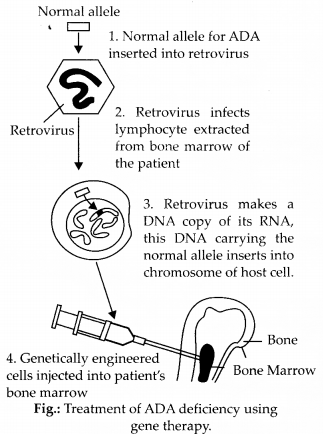
Question 2.
Define transgenic animals. Explain in detail any four areas where they can be utilised.
Answer:
The organisms which have their DNA manipulated to possess and express a foreign or extra gene are known as transgenic animals. Various areas where transgenic animals can be used are as follows:
Question 3.
You have identified a useful gene in bacteria. Make a flow chart of the steps that you would follow to transfer this gene to a plant.
Answer:
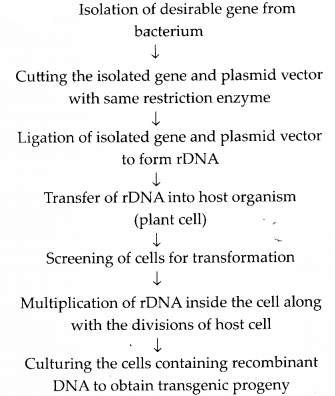
Question 4.
Highlight five areas where biotechnology has influenced our lives.
Answer:
Various areas where biotechnology has influenced our lives are :
Question 5.
What are the various advantages of using genetically modified plants to increase the overall yield of the crop?
Answer:
Advantages of genetically modified plants are as follows :
Question 6.
Explain with the help of one example how genetically modified plants can
(a) reduce usage of chemical pesticides.
(b) enhance nutritional value of food crops.
Answer:
(a) GM crops are pest resistant crops. E.g., a nematode Meloidogyne incognita infects the roots of tobacco plant and causes lots of damage by reducing the yield. Using Agrobacterium vectors nematode specific genes are introduced into the host plant, as a result they produce both sense and antisense RNA. This initiates RNAi i.e. a specific segment of RNA is made silent and is unable to produce the protein required by the nematode. The nematode dies in such a transgenic host. By this way, using biotechnological technique the transgenic plant gets protected by itself without using chemical pesticides,
(b) GM plants have increased nutritional vdlue of food. E.g., golden rice is a transgenic variety of rice, which contains good quantities of (3 carotene (provitamin A). Since the contents of vitamin A are very low in rice, so genetically engineered rice have been produced by introducing three genes associated with synthesis of carotene. The grains of transgenic rice are rich in provitamin and reduce the occurrence of vitamin A deficiency diseases.
Question 7.
List the disadvantages of insulin obtained from the pancreas of slaughtered cows and pigs.
Answer:
Disadvantages of insulin obtained from slaughtered cows and pigs are as follows :
Question 8.
List the advantages of recombinant insulin.
Answer:
Advantages of recombinant insulin are as follows:
Question 9.
What is meant by the term biopesticide? Name and explain the mode of action of a popular biopesticide.
Answer:
A biopesticide is a living organism and not a chemical substance. Its product or gene can kill the pest, thus it is used for pest control and is thus named so. It is highly specific and safe for the environment. It does not cause any pollution in the environment. Bt toxin is a biopesticide produced from Bacillus thuringiensis.
Bt toxins are proteins that kill certain insects like lepidopterans, coleopterans and dipterans. This protein exists in inactive form in bacteria and does not cause any harm to it. Once an insect ingests the inactive toxin, it gets converted into active form of toxin due to alkaline pH of alimentary canal of the insect, that solubilises the crystals.
The activated toxin binds to the surface of the midgut epi thelial cells of the insect and create pores which cause swelling and lysis and finally the death of insect. Bt toxin crystals are used as pesticide in agriculture. The protein crystals are available commercially as liquids which are sprayed on the leaves. When a insect pest ingests them, the toxins get inactivated inside the insect and kill it. With advances in the field of biotechnology, genetic engineering techniques have been used to incorporate pest resistance in crop plants. The Bt toxin genes are isolated from Bacillus thuringiensis and incorporated into several crop plants like cotton. Bt cotton farming has shown good results in various parts of the country.
Question 10.
Name the five key tools for accomplishing the tasks of recombinant DNA technology. Also mention the functions of each tool.
Answer:
Five key tools for recombinant DNA technology are :
We hope the NCERT Exemplar Solutions for Class 12 Biology chapter 12 Biotechnology and Its Applications help you. If you have any query regarding .NCERT Exemplar Solutions for Class 12 Biology chapter 12 Biotechnology and Its Applications, drop a comment below and we will get back to you at the earliest.
These Solutions are part of NCERT Exemplar Solutions for Class 12 Biology. Here we have given NCERT Exemplar Solutions for Class 12 Biology chapter 15 Biodiversity and Conservation
Multiple Choice Questions
Question 1.
Which of the following countries has the hiqhest biodiversity?
(a) Brazil
(b) South Africa
(c) Russia
(d) India
Answer:
(a) : The environment of Brazil is characterised by high biodiversity. Brazil’s large area comprises different ecosystems, which together sustain some of the world’s greatest biodiversity. It has the most known species of plants (55,000), freshwater fish (3,000) and mammals (700). Birds and reptiles are also found in abundance.
Question 2.
Which of the following is not a cause for loss of biodiversity?
(a) Destruction of habitat
(b) Invasion by alien species
(c) Keeping animals in zoological parks
(d) Over-exploitation of natural resources
Answer:
(c) : Keeping animals in zoological parks is not a cause for loss of biodiversity rather it is a method of conservation of biodiversity.
Question 3.
Which of the following is not an invasive alien species in the Indian context?
(a) Lantana
(b) Cynodon
(c) Parthenium
(d) Eichhornia
Answer:
(b) : Lantana, Eichhornia and Parthenium are all exotic species, which had been introduced in India. Lantana camara has replaced many species in forests of Uttar Pradesh and Madhya Pradesh. Eichhornia (water hyacinth) has clogged water bodies including wetlands resulting in death of several aquatic plants and animals. Parthenium has pushed out several herbs and shrubs from open places in the plains.
Question 4.
Where among the following will you find pitcher plant?
(a) Rain forest of North-East India
(b) Sunderbans
(c) Thar Desert
(d) Western Ghats
Answer:
(a) : Pitcher plant is mainly found in rain forest of North-East India. This plant grows in the soil which has low nitrate. Hence, they obtain their nitrogen nutrition by trapping insects.
Question 5.
Which one of the following is not a feature of biodiversity hotspots?
(a) Large number of species
(b) Abundance of endemic species
(c) Mostly located in the polar regions
(d) Mostly located in the tropics
Answer:
(c) : Hotspots are areas of high endemism and high species richness. All over the world, some 34 such spots have been identified, including 3 in India (Western Ghats, Indo- Burma and Himalayas). The environmental conditions in polar regions do not favour large number of species or species richness.
Question 6.
Match the animals given in Column A with their location in Column B.
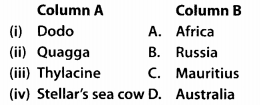
Choose the correct match from the following.
(a) i-A, ii-C, iii-B, iv-D
(b) i-D, ii-C, iii-A, iv-B
(c) i-C, ii-A, iii-B, iv-D
(d) i-C, ii-A, iii-D, iv-B
Answer:
(d)
Question 7.
What is common to the following plants: Nepenthes, Psilotum, Rauwolfa and Aconitum?
(a) All are ornamental plants.
(b) All are phylogenic link species.
(c) All are prone to over exploitation.
(d) All are exclusively present in the Eastern Himalayas.
Answer:
(c) : Nepenthes, Psilotum, Rauwolfia and Aconitum have either medicinal or ornamental importance. Hence, they are prone to over exploitation.
Question 8.
The one-horned rhinoceros is specific to which of the following National Parks?
(a) BhitarKanika
(b) Bandipur
(c) Kaziranga
(d) Corbett park
Answer:
(c)
Question 9.
Amongst the animal groups given below, which one has the highest percentage of endangered species?
(a) Insects
(b) Mammals
(c) Amphibians
(d) Reptiles
Answer:
(c) : The percentage number of endangered species in the list of threatened ones is 19% mammals, 17%birds, 21% reptiles, 22% amphibians.
Question 10.
Which one of the following is an endangered plant species of India?
(a) Rauwolfia serpentina
(b) Santalum album (Sandal wood)
(c) Cycas beddqmei
(d) All of the above
Answer:
(d)
Question 11.
What is common to Lantana, Eichhornia and African catfish?
(a) All are endangered species of India.
(b) All are key stone species.
(c) All are mammals found in India.
(d) All the species are neither threatened nor indigenous species of India.
Answer:
(d) : Lantana, Eichhornia and African catfish are exotic species or non-native species. Exotic species are often introduced for their economic and other uses. They often become invasive .and drive away the local species. These species are considered to be second major cause of extinction of species. Exotic species have proved harmful to both aquatic and terrestrial ecosystems.
Question 12.
The extinction of passenger pigeon was due to
(a) increased number of predatory birds
(b) over exploitation by humans
(c) non-availability of the food
(d) bird flu virus infection.
Answer:
(b) : Passenger pigeons (Ectopistes migratorious) were once one of the most abundant birds on our planet, living in North
AmeVica. But hunting on a very massive scale as well as deforestation, lead to their extinction. Many cruel ways were used for their hunting. The last individual of this species died in 1914 in Cincinnati Zoo.
Question 13.
Which of the following statements is correct?
(a) Parthenium is an endemic species of our country.
(b) African catfish is not a threat to indigenous catfishes.
(c) Steller’s sea cow is an extinct animal.
(d) Lantana is popularly known as carrot grass.
Answer:
(c) : Steller’s sea cow became extinct due to over exploitation by humans.
Question 14.
Among the ecosystem mentioned below, where can one find maximum biodiversity?
(a) Mangroves
(b) Desert
(c) Coral reefs
(d) Alpine meadows
Answer:
(c) : Coral reefs have the highest biodiversity with its macrobiota representing about 4-5% of the described global biota.
Question 15.
Which of the following forests is known as the ‘lungs of the planet Earth’?
(a) Taiga forest
(b) Tundra forest
(c) Amazon rainforest
(d) Rain forests of North East India
Answer:
(c) : Amazon rainforests are also called as the lungs of the planet earth. This rainforest in South America is the largest and most diverse tropical rain forest on our planet. It contributes around 20% of the total oxygen in our planet.
Question 16.
The active chemical drug reserpine is obtained from
(a) Datura
(b) Rauwolfia
(c) Atropa
(d) Papaver.
Answer:
(b) : Reserpine is an alkaloid that has been used as an anti hypertensive drug i.e., drug to lower blood pressure. It is obtained from the dried roots of Raiavolfia serpentina (Sarpagandha).
Question 17.
Which of the following groups exhibits more species diversity?
(a) Gymnosperms
(b) Algae
(c) Bryophytes
(d) Fungi
Answer:
(d)
Question 18.
Which of the below mentioned regions exhibit less seasonal variations?
(a) Tropics
(b) Temperates
(c) Alpines
(d) Both (a) & (b)
Answer:
(a) : There are no unfavourable seasons in tropics. Continued favourable environment has helped tropical organisms to gain more niche specialisation and increased diversity. Hence, tropics exhibit lesser seasonal variations.
Question 19.
The historic convention on Biological Diversity held in Rio de Janeiro in 1992 is known as
(a) CITES Convention
(b) The Earth Summit
(c) G-16 Summit
(d) MAB Programme.
Answer:
(b) : Earth Summit at Rio de Janeiro (1992), Brazil, promoted Convention on Biological Diversity (CBD) which was signed by 152 nations. Its recommendations came into effect on 29th December 1993. India became a party to this Convention on Biological Diversity in May, 1994.
Question 20.
What is common to the techniques (1) in vitro fertilisation, (2) Cryo preservation and (3) tissue culture?
(a) All are in situ conservation methods.
(b) All are ex situ conservation methods.
(c) All require ultra modern equipment and large space.
(d) All are methods of conservation of extinct organisms.
Answer:
(b) : Conservation of biodiversity can be broadly classified into two types : in situ (on-site) and ex situ (off site). Examples of in situ strategies include National parks, sanctuaries, Biosphere reserves etc. It is the preferred method to maintain species of wild animals in their natural habitats. This approach helps in conservation of total ecosystem. Ex situ approaches include conservation of those organisms, whose species may become extinct or decline heavily in number (due to a variety of reasons) in their natural habitat. This includes seed banks, cryopreservation, tissue culture, in vitro fertilisation etc.
Very Short Answer Type Questions
Question 1.
What characteristics make a community stable?
Answer:
Characteristics which make community stable are :
Question 2.
What could have triggered mass extinctions of species in the past?
Answer:
The exact reason for mass extinctions of species in the past is not known. Scientists however assume that drastic environmental changes that followed events such as asteroid or meteorite impact or volcanic eruptions lead to mass extinctions.
These environmental changes include fall in temperature causing global cooling that trapped sea water in polar ice caps leading to lowering of sea level; or rise in temperature leading to disrupted ocean circulation patterns, green house effect and depletion of ozone layer etc.
Question 3.
What accounts for the greater ecological diversity of India?
Answer:
Greater ecological biodiversity in India is due to greater geographical and topographical diversity in the form of rainforest, deciduous forests, temperate forests, deserts, mangroves, wet lands alpine meadows etc.
Question 4.
According to David Tilman, greater the diversity, greater is the primary productivity. Can you think of a very low diversity man-made ecosystem that has high productivity?
Answer:
Man made ecosystems like agricultural cropfields of wheat, maize, sorghum, paddy etc., show high productivity but low diversity.
Question 5.
What does ‘Red’ indicate in the IUCN Red list (2004)?
Answer:
Red’ being the sign of danger, in IUCN Red list (2004) indicates threatened species. These species are under various degrees of extinction risk.
Question 6.
Explain as to how protection of biodiversity hotspots alone can reduce up to 30% of the current rate of species extinction.
Answer:
Hotspots are the areas that are rich in species, have high endemism, and are under constant threat. Although it bears only 2.4% of land area of the world, but by protecting hotspots the current rate of extinction of species can be reduced upto 30%.
Question 7.
What is the difference between endemic and exotic species?
Answer:
Endemic species refers to plant or animal species that is restricted to one or a few localities in its distribution. Endemic species are usually confined to islands and are vulnerable to extinction whereas exotic species is a species of organism that is not native to a locality having been moved there from its natural range by humans or other agents. Some alien species, such as rats, are introduced mainly by accident in cargoes or transport vessels, while others are transferred intentionally, often for their ornamental or economic value.
Question 8.
How does species diversity differ from ecological diversity?
Answer:
Species diversity is the variety in the number and richness of the species of a region. Species diversity is product of both species richness or evenness or equitability, i.e., species richness weighed by species evenness. For example, big cats, like tiger (Panthera tigris), and lion (Panthera leo) belong to the same genus Panthera but they all differ at the species level.
Ecosystem diversity explains the diverse number of niches, trophic levels and various ecological processes that sustain energy flow, food webs and recycling of nutrients. Within the geographical area, there may be variable number of ecosystems/habitats.
Question 9.
Why is genetic variation important in the plant Rauwolfia vomitoria
Answer:
Rnumnifin vomitoria grows in different ranges of Himalaya. This plant is a source of an alkaloid ‘reserpine’ which has medicinal value. Genetic variation is important for potency and concentration of active chemical reserpine present in it.
Question 10.
What is Red Data Book?
Answer:
International Union of Conservation of Nature and Natural Resources which which is now called World Conservation Union (WCU) maintains a red data book or red list which is a catalogue of taxa facing risk of extinction.
Red list has eight categories of species:
Question 11.
Define gene pool.
Answer:
The sum total of all the genes found in an inbreeding population is known as gene pool.
Question 12.
What does the term ‘frugivorous’ mean?
Answer:
The term frugivorous is used for fruit eating animals.
Question 13.
What is the expanded form of IUCN?
Answer:
IUCN stands for ‘International Union of Conservation of Nature and Natural Resources’.
Question 14.
Define the terms (1) Bioprospecting (2) Endemism
Answer:
Question 15.
What is common to the species shown in figures A and B?
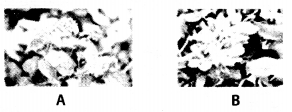
Answer:
Both are invasive weed species.
Question 16.
What is common to the species shown in figure A and B?

Answer:
Both are keystone species.
Short Answer Type Questions
Question 1.
How is the presently occurring species extinction different from the earlier mass extinctions?
Answer:
In earlier time, extinction of species occurred mainly due to natural causes or calamities like volcanic eruption, asteroid impact which lead to drastic environmental changes, etc., while at present human activities like deforestation, over-exploitation, pollution, intensive agriculture, introduction of alien species, etc., are the major causes of species extinction.
Question 2.
Of the four major causes for the loss of biodiversity alien species invasion, habitat loss and fragmentation, over-exploitation and co-extinctions which according to you is the major cause for the loss of biodiversity? Give reasons in support.
Answer:
Out of thy four causes for the loss of biodiversity, habitat loss and fragmentation seems to be the major cause of biodiversity losses. Loss of habitats result in annihilation of plants, microorganisms and forcing out of animals which in alien lands die out after some time. Fragmentation of habitats results in disruption of complex interactions amongst species, destruction of species in the cleared regions, annihilation of species restricted to deeper undisturbed parts of forests and decreased biodiversity in the habitat fragments. Animals requiring large territories (e.g., mammals, birds) are badly affected. Migrating animals would go astray and get killed.
Question 3.
Discuss one example, based on your day-to-day observations, showing how loss of one species may lead to the extinction of another.
Answer:
It has been observed that certain mutualistic relationships exist in nature. Extinction of one will automatically cause extinction of other. E.g., if the host fish becomes extinct, all the parasites exclusively found on it will also become extinct.
Question 4.
A species-area curve is drawn by plotting the number of species against the area. How is it that when a very large area is considered the slope is steeper than that for smaller areas?
Answer:
species-area relationship graph, Z is slope of line or regression coefficient which generally is 0.1-0.2 regardless of taxonomic group or region. When species area relationship is considered for a large area the slope of line becomes steeper having a value of 0.6-1.2. This is because the larger area has more food availability and other resources, so obviously more species can thrive there.
Question 5.
It is possible that productivity and diversity of a natural community remain constant over a time period of, say one hundred years?
Answer:
Although a typical community maintains itself, more or less in equilibrium with the prevailing conditions of the environment, in nature, communities are never stable; rather, they are dynamic, changing more or less regularly over time and space. They are never found permanently in complete balance with their component species, or with the physical environment. Environment is always changing over a period of time due to
Question 6.
There is greater biodiversity in tropical/ subtropical regions than in temperate region. Explain.
KPlffl
Higher diversity in tropical areas is because of the following reasons:
Question 7.
Why are the conventional methods not suitable for the assessment of biodiversity of bacteria?
Answer:
All forms of bacteria cannot be cultured in normal laboratory conditions which creates a problem in studying their morphological and biochemical characteristics. Biodiversity can be studied by examining morphological and biochemical characters. Such conventional methods cannot be applied for assessment of biodiversity of bacteria.
Question 8.
What criteria should one use in categorising a species as threatened?
Answer:
A threatened species is one which is unable to realise its full biotic potential and is, therefore, liable to become extinct. The inability of realising full biotic potential is due to depletion of food, habitat deterioration, over-exploitation, alien species, etc.
Question 9.
What could be the possible explanation for greater vulnerability of amphibians to extinction as compared to other animal groups?
Answer:
Amphibians are the group of animals which can live both on land and in water. They do not have scales and their skin is permeable to gases. A vast majority of amphibian species have to maintain moist skin surfaces because a significant amount of breathing occurs through skin. They easily get affected by the fluctuations in the surrounding environment.
Their eggs lack shell and hence are prone to dessication in an unprotective environment. Variations in environmental patterns can affect their physiological and reproductive features thereby affecting the survival and continuation of their race which accounts for their greater vulnerability to extinctions as compared to other animal groups.
Moreover, as amphibians need both aquatic and terrestrial habitats to survive, threats to either habitat can affect their population. Hence, amphibians are more vulnerable to habitat modification than the organisms which require only one habitat type.
Question 10.
Howido scientists extrapolate the total number of species on Earth?
Answer:
Scientists make a statistical comparison of the temperate-tropical species richness of an exhaustively studied group of insects and extrapolate this ratio to other groups of animals and plants to come up with a gross estimate of the total number of species on earth.
Question 11.
Humans benefit from diversity of life. Give two examples.
Answer:
Humans derive numerous benefits from diversity of living organisms. These are discussed as follows:
(1) Useful products : Plant species provide a variety of useful products such as timber, crops, fruits and vegetables, gums, resins, dyes, fragrance, perfumes, waxes, lubricants, hydrocarbons, rubber, latex, tannins, paper, tea, coffee, dry-fruits etc. Animals like goat, hen etc., serve as good source of food to humans. Milk, flesh, honey, egg, etc. are all useful animal products. Similarly, animal species provide, wool, fur, skin, leather, lac, silk, waxes, lubricants, pearls, ivory, horns, antlers etc. Large number of substances with therapeutic properties are obtained from variety of plant species. For example, quinine is obtained from the bark of plant Cinchona to combat malaria; taxol from the bark of trees Taxus brevifolia, Taxus baccata for treating cancer; reserpine from Rauwolfia serpentina for treating blood pressure and schizophrenia.
(2) Indirect benefits : Oxygen which made the earth hospitable and is indispensable for survival of almost all living organisms comes from plants which release it in the earth’s atmosphere by the process of photosynthesis. Plants also help in maintaining water cycle, replenishment of water table, bringing rains, preventing soil erosion and flood etc.
Aesthetic values of various natural ecosystems provide the opportunity of ecotourism and hence means of earning to humans.
Question 12.
List any two major causes other than anthropogenic causes for the loss of biodiversity.
Answer:
Loss of biodiversity may be due to:
(1) Natural extinction – Species with small population are always in danger of extinction due to natural causes like inbreeding depression, increased number of predators, development of more competitive species and environmental fluctuations like severe drought, severe winter, harsh summer, excess rain, floods, etc.
(2) Mass extinction – Many species dis-appeared due to catastrophes like glaciation, volcanoes, meteoriteimpact etc. Mass extinction has occurred many times in geological history. E.g., disappearance of dinosaurs coupled with loss of more than 50% of the existing species at the end of cretaceous period.
Question 13.
What is an endangered species? Give an example of an endangered plant and animal species each?
Answer:
Endangered species are those species which are facing high risk of extinction in the near future due to decrease in their habitat and excessive predation or poaching. Example of endangered animal is red panda (Ailurus fulgens). Example of endangered plant is Lycopodium nutans.
Question 14.
What are sacred groves and their role in biodiversity conservation?
Answer:
Sacred groves are forest patches around places of worship which are held in high esteem by tribal communities. They are the most undisturbed forest patches (island of pristine forests) which are often surrounded by highly degraded landscapes.
Some examples of sacred groves are-
Role , of sacred groves in biodiversity conservation are as follows:
Sacred groves are serving as refugia for a number of rare, endangered and endemic species. Not a single branch is allowed to be cut from these forests. As a result many endemic species which are rare or have become extinct ‘ elsewhere can be seen to flourish here.
Question 15.
Suggest a place where one can go to study coral reefs, mangrove vegetation and estuaries.
Answer:
Place suggested for studying coral reefs is Andaman and Nicobar island. Mangrove vegetation can be well studied in West Bengal sunderbans and estuaries can be studied in coastal areas of Kerala.
Question 16.
1s it true that there is more solar energy available in the tropics? Explain briefly.
Answer:
Tropics lie on either side of equator between 30° south latitudes. It is limited in latitude by the tropic of cancer in the northern hemisphere and the tropic of capricorn in the southern hemisphere. The tropics include the areas on earth surrounding the equator where the sun reaches a subsolar point (a point directly overhead). These regions receive the most direct sunlight and heat energy from the sun and are the hottest.
Question 17.
What is co-extinction? Explain with a suitable example?
Answer:
When a species becomes extinct, the plant or animal species associated with it in an obligatory way also becomes extinct. This is called co-extinction. E.g., if the host fish becomes extinct, all the parasites exclusively found on it will also become extinct.
Long Answer Type Questions
Question 1.
Elaborate how invasion by an alien species reduces the species diversity of an area.
Answer:
Non-native or alien species are often introduced inadvertently for their economic and other uses. They often become invasive and drive away the local species. These species are considered to be second major cause of extinction of species. Exotic species have proved harmful to both aquatic and terrestrial ecosystems. This can be explained as follows:
Water hyacinth (Eichhornia crassipes) was introduced in Indian waters to reduce pollution. It has clogged water bodies including wetlands at many places resulting in death of several aquatic plants and animals. Nile Perch (a predator fish) was introduced in lake Victoria of South Africa. It killed and eliminated ecologically unique assemblage of over 200 native species of small cliched fish.
Question 2.
How can you, as an individual, prevent the loss of biodiversity?
Answer:
Biodiversity has great importance to mankind. But certain human activities are leading to biodiversity losses. In order to maintain biodiversity we all need to put an effort to save our ecosystem. Following measures can be undertaken to prevent biodiversity losses:
Question 3.
Can you think of a scientific explanation, besides analogy used by Paul Ehrlich, for the direct relationship Answer:
Species diversity is formally measured as an index combining numbers and proportion of each species present in an ecosystem. A species diversity index reflects the number of links in a food web. The relationship between species diversity and ecosystem stability has been the most studied and debated topic since 1950.
Paul Ehrlich in his rivet popper hypothesis tried to prove the dependence of ecosystem stability on species diversity. Another scientific explanation to his theory is as follows :
If we imagine that only one food chain is operating in an ecosystem where only one species is occupying each trophic level then this type of food chain is most susceptible to destruction as loss or extinction of any species can lead to destruction of other species dependent on it for food. On the other hand, if many alternatives are available at each trophic level in the food sequence a food web will be formed decreasing the dependence of a species on a particular species for food. Then even extinction of one species will not affect any other species due to availability of alternative food. That is why, in nature food chains never operate singly rather many food chains are interconnected to form food web which gives stability to the ecosystem.
Question 4.
Though the conflict between humans and wildlife started with the evolution of man, the intensity of conflict has increased due to the activities of modern man. Justify your answer with suitable examples.
Answer:
Since the humans evolved on earth, they have been exploiting wildlife for their survival and continuity. Initially the degree of exploitation of wildlife was very less but with increasing civilisation and modernisation, the humans are becoming more demanding. Their ever increasing population is inventing new ways for better survival and existence which at times are interferring with the ways of nature leading to extinction of wildlife species. Hence, the conflict between humans and wildlife continues and has been worsened.
This can be explained as follows:
(1) Destruction of habitat and fragmentation : Over-population, urbanisation and industrialisation require additional land every year. It can come through destruction or fragmentation of natural habitats of wild animals through filling wetlands, ploughing grasslands, cutting down trees, burning a forest and clearing some area of vegetation. Loss of habitat results in annihilation of plants, microorganisms and forcing out of animals Which in alien lands die out after some time. Fragmentation of habitats results in disruption of complex interactions amongst species, destruction of species in the cleared regions, annihilation of species restricted to deeper undisturbed parts of forests and decreased biodiversity in the habitat fragments.
(2) Indiscriminate hunting : Hunting of animals for food, hide, tusks, horn, at excessive levels may lead to species extinction. Dodo bird and passenger pigeon have already become extinct. Many species of fish, molluscs, sea turtle and whales are facing the risk of extinction.
(3) Introduction of alien species:
Question 5.
What is an ecosystem service? List any four important ecosystem services provided by the natural ecosystems. Are you in favour or against levying a charge on the service provided by the ecosystem?
Answer:
A wide range of economic, environmental and aesthetic benefits provided by ecolpgical process of an ecosystem are called ecosystem services. Services of healthy forest ecosystem are –
Question 6.
Describe the consumptive use value of biodiversity as food, drugs and medicines, fuel and fibre with suitable examples.
Answer:
The consumptive use value of biodiversity as food, drugs and medicines, fuel and fibre has been described as follows :
(1) Source of food : Several thousand species of edible plants and animals are known. However, 85% of the world’s food production is met by cultivating less than 20 plant species. Three carbohydrate-rich crops namely, wheat, corn (maize) and rice alone yield nearly two-third of the food production. To meet the demands of increasing human population, man is not only exploring new varieties of plants but also animal food. Biodiversity is also used as a source material for breeding improved varieties. To improve the desired traits, commercial/domesticated. species are crossbred with their wild relatives.
In this way, disease resistant and high yielding varieties of crops (e.g.,wheat, rice, maize, sugarcane) and fruits have been developed. For example, cross breeding of wild rice species has helped ! in developing new varieties which are resistant to four main rice diseases. Similarly, potato has been made resistant to late blight disease, potato mosaic virus, five races of cyst nematodes etc., through crossbreeding experiments. Also, hybrid animals varieties have been produced to increase the production of milk, meat, eggs etc. This indicates the need for protecting biodiversity for breeding programmes in agriculture, horticulture, floriculture, animal husbandry, apiculture, sericulture, lac culture, piggery, poultry and fishery.
(2) Fibers : A variety of plant species such as cotton, flax, hemp, jut, Agave, etc., are the major sources of fibers. More and more variety of plants are being explored for obtaining superior fibers.
(3) Useful products : Plant species provide a variety of useful products such as gums, resins, dyes, fragrance, perfumes, waxes, lubricants, hydrocarbons, rubber, latex, tannins, paper, tea, coffee, dry-fruits etc. Similarly, animal species provide, wool, fur, skin, leather, honey, lac, silk, waxes, lubricants, pearls, ivory, horns, antlers etc.
(4) Drugs and medicines : Large number of substances with therapeutic properties are obtained from variety of plant species. For example, quinine is obtained from the bark of plant Cinchona to combat
malaria ; taxol from the bark of Taxus for treating cancer; morphine from Papaver somniferum for pains; reserpine from Rauwolfia serpentina for treating blood pressure and schizophrenia. Ayurvedic medicines available in the market for treating innumerous diseases in man are based on plant product.
(5) As fuel wood : 80% of forest wood (most trees) are used as fuel wood. E.g., Acacia nilotica, Albizzia sp. Mangifera indica etc.
Question 7.
Species diversity decreases as we move away from the equator towards the poles. What could be the possible reasons?
Answer:
Species diversity decreases as we move away from the equator towards the poles, because of the following reasons :
Question 8.
Explain briefly the ‘rivet popper hypothesis’ of Paul Ehrlich.
Answer:
According to this hypothesis proposed by Paul Ehrlich (1981), the relationship between species richness and ecosystem functioning is non-linear, and may follow a variety of possible trajectories. The loss of a few species (or rivets holding together an aeroplane) will create no problem in the beginning, but beyond a certain point losses will cause catastrophic effect. Loss of rivets or key species that drive major ecosystem functions is a more serious threat for the ecosystem. Besides, the rich biodiversity is not only essential for ecosystem health, but imperative for the very survival of the human beings.
Question 9.
The relation between species richness and area for a wide variety of taxa turns out to be a rectangular hyperbola. Give a brief explanation.
Answer:
German naturalist and geographer Alexander von Humboldt while exploring the wilderness of South American jungles found that within a region the species richness increased with increasing area but upto a certain limit. The relationship between species richness and area turned out to be rectangular hyperbola for a wide variety of taxa Whether they are birds, bats, freshwater fishes or flowering plants. On a logarithmic scale it is a straight line and is represented by equation: log S = log C + Z log A

Here S is species richness, Z is slope of line or regression coefficient, C is Y intercept while A is area. The relationship between area and species richness in most cases is represented by a rectangular hyperbola which indicates that if we take a larger area under consideration then the number of species increases because more individuals get included in the sample and large areas are environmentally more heterogenous than small areas. But this increase in number is neither uniform nor unlimited. Ecologists have proposed wide range of factors determining the slope and elevation of species area curve. These factors include relative balance between immigration and extinction, rate and magnitude of disturbance predator-prey dynamics, etc.
We hope the NCERT Exemplar Solutions for Class 12 Biology chapter 15 Biodiversity and Conservation help you. If you have any query regarding .NCERT Exemplar Solutions for Class 12 Biology chapter 15 Biodiversity and Conservation, drop a comment below and we will get back to you at the earliest.
These Solutions are part of NCERT Exemplar Solutions for Class 12 Biology. Here we have given NCERT Exemplar Solutions for Class 12 Biology chapter 11 Biotechnology: Principles and Processes
Multiple Choice Questions
Question 1.
Rising of dough is due to
(a) multiplication of yeast
(b) production of CO2
(c) emulsification
(d) hydrolysis of wheat flour starch into sugars.
Answer:
(b)
Question 2.
An enzyme catalysing the removal of nucleotides from the ends of DNA is
(a) endonuclease
(b) exonuclease
(c) DNA ligase
(d) HindII
Answer:
(b) : Exonucleases remove nucleotides from the terminal ends (either 5′ or 3′) of DNA of one strand of duplex. Endonucleases make cut at specific position within the DNA. DNA ligases are known as joining or sealing enzymes. Ligases form phosphodiester bonds between adjacent nucleosides and covalently link two individual fragments of DNA. Hindll is restriction endonuclease, it cuts the DNA and produces blunt end.
Question 3.
The transfer of genetic material from one bacterium to another through the mediation of a vector like virus is termed as
(a) transduction
(b) conjugation
(c) transformation
(d) translation.
Answer:
(a)
Question 4.
Which of the given statements is correct in the context of observing DNA separated by agarose gel electrophoresis?
(a) DNA can be seen in visible light.
(b) DNA can be seen without staining in visible light.
(c) Ethidium bromide stained DNA can be seen in visible light.
(d) Ethidium bromide stained DNA can be seen under exposure to UV light.
Answer:
(d) : Electrophoresis is a technique of separation of molecules such as DNA, RNA or protein, under the influence of an electric field, so that they migrate in the direction of electrode bearing the opposite charge, viz, positively charged molecules move towards cathode (-ve electrode) and negatively charged molecules travel towards anode (+ve electrode) through a medium/ matrix. Since DNA fragments are negatively charged molecules, they can be separated by allowing them to move towards the anode (+ve electrode) under an electric field through a matrix of agarose gel.
The DNA fragments separate’according to their size through the agarose gel, with smaller fragments moving farther away as compared to larger ones. The DNA fragments can be visualised by staining them with ethidium bromide followed by exposure to UV radiations. Bright orange coloured bands of DNA can be observed. The separated DNA bands are then cut out from the agarose gel and extracted from the gel piece, this step is known as elution.
Question 5.
‘Restriction’ in restriction enzyme refers to
(a) cleaving of phosphodiester bond in DNA by the enzyme.
(b) cutting of DNA at specific position only.
(c) prevention of the multiplication of bacteriophage in bacteria.
(d) all of the above.
Answer:
(c) : A restriction enzyme is an enzyme that cuts DNA by hydrolysing phosphodiester bonds at or near a specific recognition nucleotide sequences known as restriction sites. The term ‘restriction’ refers to the function of an enzyme restricting the propagation of foreign DNA of bacteriophage in the host bacterium. These enzymes are found in bacteria and provide a defense mechanism against invading virus. The host DNA is protected by a modification enzyme that modifies the prokaryotic DNA and blocks cleavage. Together, these processes form restriction modification system.
Question 6.
Which of the following is not required in the preparation of a recombinant DNA molecule?
(a) Restriction endonuclease
(b) DNA ligase
(c) DNA fragments
(d) E.coli
Answer:
(d) : To produce a recombinant DNA following procedure is followed :
Question 7.
In agarose gel electrophoresis, DNA molecules are separated on the basis of their
(a) charge only
(b) size only
(c) charge to size ratio
(d) all of the above.
Answer:
(b) : Electrophoresis is a technique of separation of molecules, such as DNA, RNA or proteins on the basis of their size, under the influence of an electric field. So they migrate towards electrode of opposite charge. DNA fragments separate according to the size through pores of agarose gel.
Question 8.
The most important feature in a plasmid to be used as a vector is
(a) origin of replication (or/)
(b) presence of a selectable marker
(c) presence of sites for restriction endonuclease
(d) its size.
Answer:
(a,b,c & d) : Origin of replication (On), a selectable marker, sites for restriction 1 endonuclease and its size, all are importantfeatures required to facilitate cloning into a vector. A good DNA vector should be able to replicate autonomously in the host cell, for which it needs to have an origin of replication site (Ori). This is important for the replication of inserted gene. A prokaryotic DNA has a single Ori while eukaryotic DNA may have more than one Ori. Selectable marker helps in identifying and eliminating non-transformants and selectively permitting the growth of transformants. Cloning sites (recognition sites) are the sites where the DNA is cut by a restriction endonuclease. A vector should be ideally less than 10 kb in size because large DNA molecules can break down during purification procedure.
Question 9.
While isolating DNA from bacteria, which of the following enzymes is not used?
(a) Lysozyme
(b) Ribonuclease
(c) Deoxyribonuclease
(d) Protease
Answer:
(c) : In order to cut the DNA with restriction enzymes, it needs to be in pure form, free from other macromolecules. Since the DNA is enclosed by the membranes,we haive to break the cell open to release DNA and other macromolecules like RNA, proteins, polysaccharides and lipids. It is obtained by treating the bacterial cells/ plant or animal tissue with enzymes such as lysozyme (bacteria), cellulase (plant cells) and chitinase (fungus). DNA is interwined with proteins like histones. RNA can be removed by treatment with ribonuclease while proteins can be removed by treatment with protease. Other molecules are removed by appropriate treatments and purified DNA ultimately precipitates out after the addition of chilled ethanol.
Question 10.
Which of the following has popularised the PCR (polymerase chain reaction)?
(a) Easy availability of DNA template.
(b) Availability of synthetic primers.
(c) Availability of cheap deoxyribonudeo- tides.
(d) Availability of ‘thermostable’ DNA poly-merase.
Answer:
(d) : The final step of PCR is extension, wherein Taq DNA polymerase (isolated from a thermophilic bacterium Thermits aquaticus) synthesises the DNA region between the primers, using dNTPs (deoxynucleoside triphosphates) and Mg2+. The primers are extended towards each other so that the DNA segment lying between the two primers is copied. The optimum temperature for this polymerisation step is 72CC. Taq polymerase remains active during high temperature induced denaturation of double stranded DNA.
Question 11.
An antibiotic resistance gene in a vector usually helps in the selection of
(a) competent cells
(b) transformed cells
(c) recombinant cells
(d) none of the above.
Answer:
(b) :The ligation of alien DNA is carried out at a restriction site present in one of the two antibiotic resistance genes. For example, you can ligate a foreign DNA at the BamHl site of tetracycline resistance gene in the vector pBR322. The recombinant plasmids will lose tetracycline resistance other macromolecules like RNA, proteins, polysaccharides and lipids. It is obtained by treating the bacterial cells/ plant or animal tissue with enzymes such as lysozyme (bacteria), cellulase (plant cells) and chitinase (fungus). DNA is interwined with proteins like histones. RNA can be removed by treatment with ribonuclease while proteins can be removed by treatment with protease. Other molecules are removed by appropriate treatments and purified DNA ultimately precipitates out after the addition of chilled ethanol.
Question 12.
Significance of ‘heat shock’ method in bacterial transformation is to facilitate
(a) binding of DNA to the cell wall
(b) uptake of DNA through membrane transport proteins
(c) uptake of DNA through transient pores in the bacterial cell wall
(d) expression of antibiotic resistance gene.
Answer:
(c) : Transformation is a process by which a cell takes up naked DNA fragment from the environment, incorporates it into its own chromosomal DNA and finally expresses the trait controlled by the incoming DNA. Since DNA is a hydrophilic molecule, it cannot pass through membranes, so the bacterial cells must be made competent to take up DNA. This is done by treating them with a specific concentration of a divalent cation, such as calcium (Ca2+) which increases the efficiency with which DNA enters the bacterium through pores in its cell wall. Recombinant DNA (rDNA) can then be forced into such cells by incubating the cell with recombinant DNA on ice, followed by placing them briefly at 42°C (heat shock), and then putting them back on ice. This enables the bacteria to take up the recombinant DNA.
Question 13.
The role of DNA ligase in the construction of a recombinant DNA molecule is
(a) formation of phosphodiester bond between two DNA fragments
(b) formation of hydrogen bonds between sticky ends of DNA fragments
(c) ligation of all purine and pyrimidine bases
(d) none of the above.
Answer:
(a) : DNA ligases (joining or sealing enzymes) are also called genetic gum. They join two individual fragments of double straqded DNA by forming phosphodiester bonds between them. Thus, they help in sealing gaps in DNA fragments. Therefore, they act as a molecular glue.
Question 14.
Which of the following is not a source of restriction endonuclease?
(a) Haemophilus influenzae
(b) Escherichia coli
(c) Entamoeba coli
(d) Bacillus amyloliquifaciens
Answer:
(c)
| Source | Restriction endonuclease |
| (1) Haemophilus influenzae | Hindll and HmdIII |
| (2) Escherichia coli | EcoRI and EcoRII |
| (3)Bacillus amyloliquefaciens | Bam HI |
Question 15.
Which of the following steps are catalysed by Taq polymerase in a PCR reaction?
(a) Denaturation of template DNA.
(b) Annealing of primers to template DNA.
(c) Extension of primer end on the template DNA.
(d) All of the above.
Answer:
(c) : Refer answer 10.
Question 16.
A bacterial cell was transformed with a recombinant DNA that was generated using a human gene. However, the transformed cells did not produce the desired protein. Reasons could be
(a) human gene may have intron which bacteria cannot process
(b) amino acid codonsfor humans and bacteria are different
(c) human protein is formed but degraded by bacteria
(d) all of the above.
Answer:
(a) : Eukaryotic genes do not function properly when transferred into bacterial cell because introns are present in eukaryotic cells but are absent in prokaryotic cells. Hence, when bacterial cell is transformed with recombinant DNA which is generated using human gene, it could not process it. As a result, no desired protein will be produced.
Question 17.
Which of the following should be chosen for best yield if one were to produce a recombinant protein in large amounts?
(a) Laboratory flask of largest capacity
(b) A stirred-tank bioreactor without in-lets and out-lets
(c) A continuous culture system
(d) Any of the above
Answer:
(c) : The cells having cloned genes of interest can be grown on a small scale in the laboratory. The cultures may be used tor extracting and purifying the desired protein. The cells can also be multiplied in a continuous culture system where the used medium is passed out from one side and fresh medium is added from the other side to maintain the cells in their physiologically most active log/ exponential phase – rapid multiplication of the cells. This type of culturing method produces a larger biomass to get higher yields of desired protein.
Question 18.
Who among the following was awarded the Nobel Prize for the development of PCR technique?
(a) Herbert Boyer
(b) Hargovind Khurana
(c) KaryMullis
(d) Arthur Kornberg
Answer:
(c)
Question 20.
Which of the following statements does not hold true for restriction enzyme?
(a) It recognises a palindromic nucleotide sequence.
(b) It is an endonuclease.
(c) It is isolated from viruses.
(d) It produces the same kind of sticky ends in , different DNA molecules.
Answer:
(c) : More than 900 restriction enzymes have been isolated from over 230 strains of bacteria each of which recognise different recognition sequences. No restriction enzyme has been isolated from viruses.
Very Short Answer Type Questions
Question 1.
How is copy number of the plasmid vector related to yield of recombinant protein?
Answer:
The copy number is the number of copies of plasmids compared with the amount of chromosomal DNA found in single bacterial cell. The copy number influences the stability of plasmid. The rDNA can multiply as many times as the copy number of vector plasmid. So, higher the copy number of plasmid, higher would be the copy number of gene and protein yield would be high.
Question 2.
Would you choose an exonuclease while producing a recombinant DNA molecule?
Answer:
For producing recombinant DNA, exonuclease is not added because it removes nucleotides from terminal ends (either 5′ or 3′) and it acts on single strand of DNA. It does not recognise any specific sequence.
Question 3.
What does ‘H’, ‘in’, ‘d’ and ‘III’ refer to in the enzyme Hindlll?
Answer:
ln naming of restriction endonuclease, the first letter of enzyme is the first letter of bacterium’s, generic name, “H”-Haemophilus, “in” represents two letters of species name- influenzae, “d” is for strain “Rd”, and “HI” indicates the order in which enzyme is synthesised.
Question 4.
Restriction enzymes should not have more than one site of action in the cloning site of a vector. Comment.
Answer:
Restriction enzymes should preferably have single recognition site because presence of more than one recognition sites within the vector will generate several fragments, which will complicate the gene cloning.
Question 5.
What does ‘competent’ refer to in competent cells used in transformation experiments?
Answer:
Competent cells are the cells that have altered cell wall so that they can take up foreign DNA easily. Competent cell is the one that is able to undergo genetic transformation.
Question 6.
What is the significance of adding proteases at the time of isolation of genetic material (DNA)?
Answer:
Genes located on the DNA are interwined with proteins such as histones, which are removed by proteases. It is important to add protease during DNA isolation because DNA has to be free from any other .macromolecule such as RNA, proteins to get cut with restriction endonuclease.
Question 7.
While doing a PCR/denaturation’step is missed. What will be its effect on the process?
Answer:
Denaturation is the first step in PCR reaction. If denaturation does not take place, annealing and extension will also not take place. Therefore, there will be no amplification.
Question 8.
Name a recombinant vaccine that is currently being used in vaccination program.
Answer:
HepaH tis-R surface antigen (HBsAg) is currently used as vaccine in vaccination programme against hepatitis virus.
Question 9.
Do biomolecules (DNA, protein) exhibit biological activity in anhydrous conditions?
Answer:
DNA and protein do not show biological activity in anhydrous conditions because in non-aqueous conditions rigidity of biomolecules increases due to weakening of hydrogen bond strength.
Question 10.
What modification is done on the Ti plasmid Agrobacterium tumefaciens to convert it into a cloning vector?
Answer:
Agrobacterium tumefaciens, a pathogen of several dicot plants is able to deliver T-DNA to transform normal cell into tumour and direct tumour cells to produce chemicals required by pathogen. The Ti (tumor inducing) plasmid has been modified (disarmed) by removing gene responsible for causing tumour and inserting gene to be used as selectable marker. Modified plasmid is non-pathogenic to plants and delivers the gene of interest.
Short Answer Type Questions
Question 1.
What is meant by gene cloning?
Answer:
Gene cloning is formation of multiple identical copies of any template DNA. For cloning, an alien DNA is linked with origin of replication of a vector, so that it can replicate and multiply itself in the host organism.
Question 2.
Both a wine maker and a molecular biologist who had developed a recombinant vaccine claim to be biotechnologists. Who in your opinion is correct?
Answer:
Biotechnology is technological employment of biological entities and processes to generate products and services useful to man. In this case a wine maker has utilised a strain of yeast, which is commonly used for making wine by fermentation. The molecular biologist has used cloned gene for an antigen and antigen is used as vaccine. Thus, both can be considered as biotechnologists.
Question 3.
A recombinant DNA molecule was created by ligating a gene to a plasmid vector. By mistake, an exonuclease was added to the tube containing the recombinant DNA. How does this affect the next step in the experiment i.e. bacterial transformation?
Answer:
Recombinant DNA is formed by ligating an alien DNA with plasmid DNA, a circular, self-replicating, extra-chromosomal, dsDNA. Therefore, rDNA is also circular DNA and exonucleases cleave DNA at terminal ends (either 5′ or 3′) in a linear DNA segment. Thus, addition of exonuclease to a tube containing rDNA would not affect bacterial transformation.
Question 4.
Restriction enzymes that are used in the construction of recombinant DNA are endonucleases which cut the DNA at ‘specific- recognition sequence’. What would be the disadvantage if they do not cut the DNA at specific recognition sequence?
Answer:
If endonucleases used in the recombinant DNA technology do not cut DNA at specific locations, they may cut the DNA at random location. The sticky ends will not be generated to ligate the DNA segments and recombinant DNA would not be formed.
Question 5.
A plasmid DNA and a linear DNA (both are of the same size) have one site for a restriction endonuclease. When cut and separated on agarose gel electrophoresis, plasmid shows one DNA band while linear DNA shows two fragments. Explain.
Answer:
A plasmid DNA is a circular DNA. When this circular DNA having one site for restriction endonuclease is cleaved with an enzyme, it would form a strand of linear DN? and would be visible as single band on agarose gel. On the other hand, when linear DNA with one restriction site is cleaved, it would produce two fragments and thus two bands would be seen.
Question 6.
How does one visualise DNA on an agarose gel?
Answer:
The separated DNA fragments on an agarose gel can be visualised only after staining the DNA with ethidium bromide followed by exposure to UV radiations as bright orange coloured bands.
Question 7.
A plasmid without a selectable marker was chosen as vector for cloning a gene. How does this affect the experiment?
Answer:
If a cloning vector does not have a selectable marker, then it would not be possible to distinguish between transformants (host bacterium having rDNA) and non-transformants. Therefore, an ideal cloning vector should have selectable markers for the selection of transformants.
Question 8.
A mixture of fragmented DNA was electrophoresed in an agarose gel. After staining the gef with ethidium bromide, no DNA bands were observed. What could be the reason?
Answer:
There could be various reasons for DNA bands not visible after electrophoresis, such as:
Question 9.
Describe the role of CaCI2 in the preparation of competent cells.
Answer:
Competent cell is one which can take up naked DNA fragment and incorporate it into its own chromosomal DNA. DNA is a hydrophilic molecule and. cannot pass through membranes, so bacterial cell can be made competent by CaCH method. In this method, bacterial cell is treated with divalent cation Ca2+ which increases the efficiency with which DNA enters the bacterium through pores in its cell wall.
Question 10.
What would happen when one grows a recombinant bacterium in a bioreactor but forgets to add antibiotic to the medium in which the recombinant is growing?
Answer:
Antibiotics do not allow other bacteria to grow in the medium. In the absence of antibiotics, the desirable bacteria may not be able to grow to its optimum level. The plasmids may also be lost, since maintaining a high copy number of plasmids is a metabolic burden on the bacteria.
Question 11.
Identify and explain steps A, B and C in the PCR diagram given below.
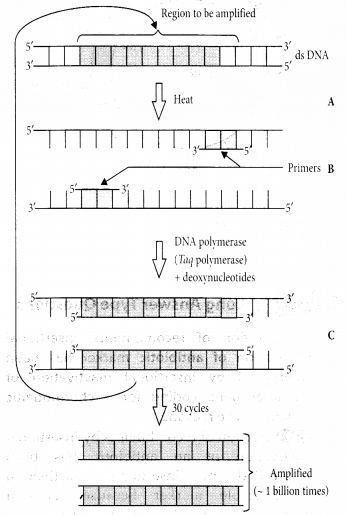
Answer:
Polymerase Chain Reaction (PCR) involves amplification of gene of interest.
A single PCR amplification cycle involves three basic steps:
Question 12.
Name the regions marked A, B and C.
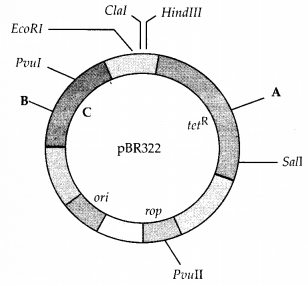
Answer:
A – BarnHI
B – PtI
C – ampR
Long Answer Type Questions
Question 1.
For selection of recombinants, insertional inactivation of antibiotic marker has been superceded by insertional inactivation of a marker gene coding for a chormogenic substrate. Give reasons.
Answer:
Selection of recombinants by insertional inactivation of an antibiotic has been superceded by insertional inactivation of selectable marker because selection of recombinants due to inactivation of antibiotics is a cumbersome procedure, because it requires simultaneous plating on two plates having different antibiotics (ampicillin and tetracyiine). Therefore, alternative selectable markers have been developed which differentiate recombinants from non-recombinants on the basis of their ability to produce colour in the presence of chromogenic substrate. In this, a recombinant DNA is inserted within the coding sequence of an enzyme p-galactosidase.
This results in the inactivation of the enzyme (insertional inactivation). The presence of chromogenic substrate gives blue coloured colonies if the plasmid in the bacteria does not have an insert. Presence of insert results into insertional inactivation of the (1-galactosidase and the colonies do not produce any colour, and these are identified as recombinant colonies.
Question 2.
Describe the role of Agiobacterium tumefaciens in transforming a plant cell.
Answer:
Aemhactprium tumefaciens is a bacterium that causes tumours in plants. It has ability to transform plant cells. For this reason it has become an important tool in plant improvement by genetic engineering.
The plasmid is disarmed by deletion of the tumour inducing gene. These modified bacteria can still transform plant cells. The part of Ti plasmid transferred into plant cell DNA, is called T-DNA. This T-DNA with desired DNA spliced into it, is inserted into the chromosomes of the host plant where it produces copies of itself. But it no longer produces tumours. Such plant cells are then cultured, induced to multiply and differentiate to form plantlets. Thus the ability of Agrobactcrium to transfer genes to the plants has been exploited in genetic engineering for plant improvement programme.
Question 3.
Illustrate the design of a bioreactor. Highlight the difference between a flask in your laboratory and a bioreactor which allows cells to grow in a continuous culture system.
Answer:
Bioreactors are vessels in which raw materials are biologically converted into specific products by microbes, plant and anirhal cells and their enzymes. They are allowed to synthesise the desired proteins which are finally extracted and purified from cultures.
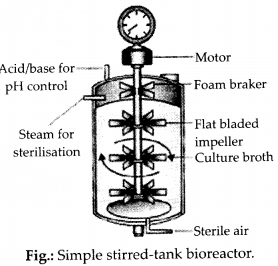
Small volume of cultures are usually employed in laboratories for research and production of less quantities of products. Large scale production of products is carried out in bioreactors. The most commonly used bioreactors are of stirring type, that have provision for batch culture or continuous culture. In continuous culture, the culture medium is added and the product is taken out continuously.
Flask is used in laboratory for testing and provides batch type of culture. With flask no gadget can be connected. Bioreactors are used commercially and provide continuous culture. With a bioreactor, gadgets can be attached to give better functioning. A bioreactor provides optimal conditions for optimal growth (temperature pH, substrate, salts, vitamins, oxygen).
We hope the NCERT Exemplar Solutions for Class 12 Biology chapter 11Biotechnology: Principles and Processes help you. If you have any query regarding .NCERT Exemplar Solutions for Class 12 Biology chapter 11Biotechnology: Principles and Processes, drop a comment below and we will get back to you at the earliest.
These Solutions are part of NCERT Exemplar Solutions for Class 12 Biology. Here we have given NCERT Exemplar Solutions for Class 12 Biology chapter 7 Evolution
Multiple Choice Questions
Question 1.
The vitamin whose content increases following the conversion of milk into curd by lactic acid bacteria is
(a) vitamin C
(b) vitamin D
(c) vitamin B12
(d) vitamin E.
Answer:
(c) : Curd is more nutritious than milk as it contains a number of organic acids and vitamins including B12 .
Question 2.
Wastewater treatment generates a large quantity of sludge, which can be treated by
(a) anaerobic digesters
(b) floe
(c) chemicals
(d) oxidation pond.
Answer:
(a) : The sediment of settling tank is r called activated sludge. A part of it is used as inoculum in aeration tanks. The remaining is passed into a large tank called anaerobic sludge digesters.
Question 3.
Methanogenic bacteria are not found in
(a) rumen of cattle
(b) gobar gas plant
(c) bottom of water-logged paddy fields
(d) activated sludge.
Answer:
(d) : Methanogens are strict anaerobes. Nutritionally they are “autotrophs” which obtain both energy and carbon from decomposition products. They occur in marshy areas where they convert formic acid and carbon dioxide into methane with the help of hydrogen. This capability is commercially exploited in the production of methane and fuel gas inside gobar gas plants c.g., Methanobacterium, Methanococcus. Some of the methanogen archaebacteria live as symbionts (e.g., Methanobacterium) inside rumen or first chamber in the stomach of herbivorous animals that chew their cud (ruminants, e.g., cow, buffalo).
These archaebacteria are helpful to the ruminants in fermentation of cellulose. The warm, water logged soil of paddy fields provide ideal condition for methanogenesis and though some of the methane produced is usually oxidised by methanotrophs in the shallow overlying area, vast majority is released into atmosphere. Methanogenic bacteria are not found in activated sludge instead activated sludge contains aerobic microorganisms.
Question 4.
Match the following list of bacteria and their commercially important products.
Bacterium Product

Choose the correct match.
(a) i-(B), ii-(C), iii-(D), iv-(A)
(b) f-(B), ii-(D), iii-(C), iv-(A)
(c) i-(D), ii-(C), iii-(B), iv-(A)
(d) i-(D), ii-(A), iii-(C), iv-(B)
Answer:
(c)
Question 5.
Match the following list of bioactive substances and their roles. Role
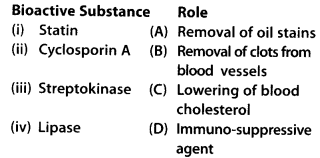
Choose the correct match
(a) i-(B), ii-(C), iii-(A), iv-(D)
(b) i-(D), ii-(B), iii-(A), iv-(C)
(c) i-(D), ii-(A), iii-(B), iv-(C)
(d) i-(C), ii-(D), iii-(B), iv-(A)
Answer:
(d)
Question 6.
The primary treatment of waste water involves the removal of
(a) dissolved impurities
(b) stable particles
(c) toxic substances
(d) harmful bacteria.
Answer:
(b) : Primary or physical treatment is the process of removal of small and large, floating and suspended solids from sewage through two processes of filtration and sedimentation. First floating and suspended matter is removed through sequential filtration with progressively smaller pore filters. The filtrate is then kept in large open settling tanks where grit (sand, silt, small pebbles) settles down. Aluminium or iron sulphate is added in certain places for flocculation and settling down of solids. The sediment is called primary sludge, while the supernatant v is called effluent.
Question 7.
BOD of waste water is estimated by measuring the amount of
(a) total organic matter
(b) biodegradable organic matter
(c) oxygen evolution
(d) oxygen consumption.
Answer:
(d) : Degree of impurity of water due to organic matter is measured in terms of BOD. It is the oxygen in milligrams required for five days in one liter of water at 20°C for the microorganisms to metabolise organic waste.
Question 8.
Which one of the following alcoholic drinks is produced without distillation?
(a) Wine
(b) Whisky
(c) Rum
(d) Brandy
Answer:
(a) : Wine and beer are produced without distillation whereas whisky, brandy and rum are produced by distillation of the fermented broth.
Question 9.
The technology of bio gas production from cow dung was developed in India largely due to the efforts of
(a) Gas Authority of India
(b) Oil and Natural Gas Commission
(c) Indian Agricultural Research Institute and Khadi & Village Industries Commission
(d) Indian Oil Corporation.
Answer:
(c)
Question 10.
The free-living fungus Trichoderma can be used for
(a) killing insects
(b) biological control of plant diseases
(c) controlling butterfly caterpillars
(d) producing antibiotics.
Answer:
(b) : Abiological control being developed for use in the treatment of plant disease is the fungus Trichoderma. Trichoderma species are free-living fungi that are very common in the root ecosystems. They are effective biocontrol agents of several plant pathogens.
Question 11.
What would happen if oxygen availability to activated sludge floes is reduced?
(a) It will slow down the rate of degradation of organic matter.
(b) The center of floes will become anoxic, which would cause death of bacteria and eventually breakage of floes.
(c) Floes would increase in size as anaerobic bacteria would grow around floes.
(d) Protozoa would grow in large numbers.
Answer:
(a,b) : Floes are masses of bacteria associated with fungal filaments to form mesh like structures. If oxygen availability to activated sludge floes is reduced, their rate of decomposition of organic matter will decrease. And as the center of floes will become anoxic, the bacterial cells will die, thus causing breakage of floes.
Question 12.
Mycorrhiza does not help the host plant in
(a) enhancing its phosphorus uptake capacity
(b) increasing its tolerance to drought
(c) enhancing its resistance to root pathogens
(d) increasing its resistance to insects.
Answer:
(d) : Fungi are also known to form symbiotic associations with plants (mycorrhiza). Many members of the genus Glomus form mycorrhiza. The fungal symbionts in these associations absorb phosphorus from soil and passes it to the plant. Plants having such associations show other benefits also, such as resistance to root- 1 borne pathogens, tolerance to salinity and drought, and an overall increase in plant growth and development.
Question 13.
Which one of the following is not a nitrogen fixing organism?
(a) Anabaena
(b) Nostoc
(c) Azotobacter
(d) Pseudomonas
Answer:
(d) : Pseudomonas is not a nitrogen fixing bacteria. Pseudomonas are used in antibiotic formation and biodegradation of organic pollutant like petroleum spillage. Azotobacter is a free living nitrogen fixing bacteria. Anabaena and Nostoc are free living nitrogen fixing cyanobacteria.
Question 14.
Big holes in Swiss cheese are made by a
(a) a machine
(b) a bacterium that produces methane gas
(c) a bacterium producing a large amount of carbon dioxide
(d)a fungus that releases a lot of gases during its metabolic activities.
Answer:
(c) : Ripened cheese is prepared from unripened cheese by first dipping in brine, wiping and then maturation with different strain of bacteria and fungi. It takes 1-16 months for ripening. Large holed Swiss cheese is ripened with the help of CO2 producing (causing holes) bacterium called Propionibacterium sharmanii.
Question 15.
The residue left after methane production from cattle dung is
(a) burnt
(b) burried in landfills
(c) Used as manure
(d) used in civil construction.
Answer:
(c) : Biogas is a methane rich fuel gas produced by anaerobic breakdown or digestion of biomass with the help of methanogenic bacteria. Biogas is made up of methane (50-70%), carbon dioxide (30-40%) with traces of nitrogen, hydrogen sulphide and hydrogen. The effluent and residue left after the fermentative generation of biogas is rich in minerals, lignin and a part of cellulose. It is an ideal manure.
Question 16.
Methanogens do not produce
(a) oxygen
(b) methane
(c) hydrogen sulphide
(d) carbon dioxide.
Answer:
(a) : Refer answer 15.
Question 17.
Activated sludge should have the ability to settle quickly so that it can
(a) be rapidly pumped back from sedimentation tank to aeration tank
(b) absorb pathogenic bacteria present in waste water while sinking to the bottom of the settling tank
(c) be discarded and anaerobically digested
(d) absorb colloidal organic matter.
Answer:
(a) : Bacterial floes are allowed to sediment into the settling tank, this sediment is called activated sludge. A small part of activated sludge is pumped back into aeration tank to serve as inoculum. So, it must have ability to settle quickly.
Question 18.
Match the items in Column ‘A’ and Column ‘B’ and choose correct answer.

The correct answer is
(a) (i)-Q, (ii)-S, (iii)-R, (iv)-P
(b) (i)-p, (ii)-S, (iii)-Q, (iv)-P
(c) (i)-S, (ii)-P, (iii)-Q, (iv)-R
(d) (i)-R, (ii)-Q, (iii)-P, (iv)-S
Answer:
(b)
Very Short Answer Type Questions
Question 1.
Why does ‘Swiss cheese’ have big holes?
Answer:
cheese is prepared by bacteria Propionibncterium shanmnii. It produces large quantity of CO, which causes large holes in cheese.
Question 2.
What are fermentors?
Answer:
Fermentors are the containers where fermentation is carried out, also known as bioreactors.
Question 3.
Name a microbe used for statin production. How do statins lower blood cholesterol level?
Answer:
Statin is produced by yeast Monascus purpureus. It is used as blood cholesterol lowering agent by acting as a competitive inhibitor of enzyme for cholesterol synthesis.
Question 4.
Why do we prefer to call secondary waste water treatment as biological treatment?
Answer:
Secondary waste water treatment is also called biological treatment because in this step microbes digest organic matter and convert it into microbial biomass and release minerals.
Question 5.
What for nucleo poly hedroviruses are being used now a days?
Answer:
Nucleo poly hedroviruses are baculo- virus. These are biological control agents that attack insects and other arthropods. TheY are species-specific, narrow spectrum insecticides and do not harm plants, mammals, birds and fish.
Question 6.
How has the discovery of antibiotics helped mankind in the field of medicine?
Answer:
Antibiotics are the chemical substances produced by microorganisms which are used for treatment of pathogenic or infectious diseases. Antibiotics have greatly improved our capacity to treat deadly diseases such as plague, whooping cough (kali khansi), diphtheria (gal ghotu).
Question 7.
Why is distillation required for producing certain alcoholic drinks?
Answer:
Production of hard liquors require distillation of fermented broth to increase the alcoholic content. Beer and wine are formed without distillation and have 3-6% alcoholic content while rum, brandy and gin are formed by distillation and have 40% alcohol content.
Question 8.
Write the most important characteristic that Aspergillus niger, Clostridium butylicum, and Lactobacillus share.
Answer:
the three microbes, Aspergillus niger, Clostridium butylicum and Lactobacillus are used for commercial and industrial production of organic acids through fermentation. Organic acids produced are citric acid, butyric acid and lactic acid respectively.
Question 9.
What would happen if our intestine harbours microbial flora exactly similar to that found in the rumen of cattle?
Answer:
If humans also had microbes in their intestine like ruminants, then they would also have been capable of digesting cellulose presentin food itemsbecause microbes present in the rumen of cattle, called methanogens are capable of digesting cellulose as they have cellulase enzyme.
Question 10.
Give any two microbes that are useful in biotechnology.
Answer:
Two microbes that are used in bio-technology are:-
Question 11.
What is the source organism for EcoRI, restriction endonuclease?
Answer:
Bacterium Escherichia coil of strain RY13.
Question 12.
Name any genetically modified crop.
Answer:
cotton is a genetically modified crop that has been modified to resist attack by insect pests.
Question 13.
Why are blue-green algae not popular as biofertilisers?
Answer:
Blue -green algae add organic matter to the soil and increase its fertility but still these are not popular as biofertilisers. This is due to several constraints that limit the application or implementation of the biofertiliser technology. The constraints may be environmental, technological, infrastructural, financial, unawareness, quality, marketing etc.
Question 14.
Which species of Penicillium produces Roquefort cheese?
Answer:
Penicillium roqueforti
Question 15.
Name the states involved in Ganga action plan.
Answer:
Uttaranchal, Uttar Pradesh, Jharkhand, West Bengal, Bihar etc.
Question 16.
Name any two industrially important enzymes.
Answer:
Question 17.
Name an immune immunosuppressive agent.
Answer:
Cyclosporin-A is used as immuno-suppressive agent in organ transplantation.
Question 18.
Give an example of a rod shaped virus.
Answer:
Tobacco mosaic virus (TMV).
Question 19.
What is the group of bacteria found in both the rumen of cattle and sludge of sewage treatment?
Answer:
Methanogens or Methanobacterium are found in the rumen of cattle and anaerobic sludge of sewage treatment.
Question 20.
Name a microbe used for the production of Swiss cheese.
Answer:
Propionibacterium sharmanii
Short Answer Type Questions
Question 1.
Why are floes important in biological treatment of waste water?
Answer:
Floes are masses of bacteria held together by fungal filament in mesh like structure in aeration tank for secondary sewage treatment. They digest organic matter and convert it into microbial biomass.
Question 2.
How has the bacterium Bacillus thuringiensis helped us in controlling caterpillars of insect pests?
Answer:
Bacteria Bacillus thuringiensis is used to control butterfly caterpillars. These are available in sachets as dried spores which are mixed with water and sprayed onto vulnerable plants such as brassicas and fruit trees, where they are eaten by the insect larvae. In the gut of larvae, the toxin is released and the larvae get killed.
Question 3.
How. do mycorrhizal fungi help the plants harbouring them?
Answer:
Mycorrhiza is a mutually beneficial or symbiotic association of a fungus with the roots of a higher plant. Mycorrhizal roots show a sparse or dense wooly growth of fungal hyphae on their surface.
Mycorrhiza perform several functions for the plant:
Question 4.
Why are cyanobacteria considered useful in paddy fields?
Answer:
Cyanobacteria are used as biofertilisers. They fix atmospheric nitrogen in specialised cells called heterocysts. These organism form symbiotic association with plant, add organic matter and extra nitrogen to the soil and do not interfere with plant growth, e.g., Azolla- Anabaena association is of great importance to paddy fields. Anabaena azollae resides in the leaf cavities of the fern. It fixes nitrogen. A part of the fixed nitrogen is excreted in the cavities and becomes available to the fern. The decaying fern plants release the same for the utilisation of rice plants.
Question 5.
How was penicillin discovered?
Answer:
Discovery of an antibiotic penicillin was serendipitous. It was discovered by Alexander Fleming, he found that petri dish containing culture of Staphylococcus got contaminated by mould. Mould inhibited the bacterial growth. Fleming isolated the mould and proved that filtrate of broth culture Penicillium notatum has antibacterial properties and discovered penicillin.
Question 6.
Name the scientists who were credited for showing the role of penicillin as an antibiotic.
Answer:
Penicillin was discovered by Alexander Fleming, while working on staphylococci bacteria. However its full potential as an effective antibiotic were established much later by Ernest Chain and Howard Florey and used it for treating wounded soldiers in World War II. Fleming, Chain and Florey were awarded the Noble prize, in 1945 for this discovery.
Question 7.
How do bioactive molecules of fungal origin help in restoring good health of humans?
Answer:
Bioactive molecules of fungal origin which help in restoring good health are :
Question 8.
What roles do enzymes play in detergents that we use for washing clothes? Are these enzymes produced from some unique microorganisms?
Answer:
ipases are lipid dissolving enzymes that are added in detergents for removing oily stains from laundry. They are obtained from Candida lipoh/tica and Gcotrichum candiduiu.
Question 9.
What is the chemical nature of biogas? Name an organism which is involved in biogas production.
Answer:
Biogas is a methane rich fuel gas produced by anaerobic breakdown or digestion of biomass with the help of methanogenic bacteria. Biogas is made up of methane (50-70%), carbon dioxide (30-40%) with traces of nitrogen, hydrogen sulphide and hydrogen. Mcthanobactcrium is a common methanogenic bacteria involved in biogas production.
Question 10.
How do microbes reduce the environmental degradation caused by chemicals?
Answer:
Chemicals from fertilisers and pesticides are highly toxic to human beings and animals alike, and have been polluting our environment. To reduce the environmental degradation caused by chemicals, microbes can be used both as fertilisers and pesticides and are called biofertiliser and biopesticides, respectively. E.g., Rhizobium acts asbiofertiliser, as it can fix atmospheric nitrogen and Bacillus thuringiensis acts as biopesticide to control growth of insect pest.
Question 11.
What is a broad spectrum antibiotic? Name one such antibiotic.
Answer:
Broad spectrum antibiotic is an antibiotic which can kill or destroy a number of pathogens that belong to different groups with different structure and wall composition. e.g., Streptomycin.
Question 12.
What are viruses parasitising bacteria called? Draw a well labelled diagram of the same.
Answer:
Viruses parasitising bacteria are called bacteriophages. These viruses do not eat bacteria, but they infect and replicate within the bacteria.
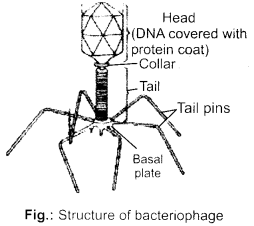
Question 13.
Which bacterium has been used as clot buster? What is its mode of action?
Answer:
BacteriumBacterium Streptococcus has been modified genetically to function as clot buster. It produces enzvme streptokinase and has fibrinolytic effect. It helps in clearing blood dots inside blood vessels through dissolution of intravascular fibrin.
Question 14.
What are biofertilisers? Give two examples.
Answer:
Biofertilisers are microorganisms which bring about nutrient enrichment of the soil by enhancing the availability7 of nutrients like nitrogen and phosphorus to the crops. e.g.,
Long Answer Type Questions
Question 1.
Why is aerobic degradation more important than anaerobic degradation for the treatment of large volumes of waste waters rich in organic matter. Discuss.
Answer:
During aerobic conditions bacteria gets associated with fungal hyphae and form floes,
They multiply very, rapidly and decompose large amount of organic waste matter present in waste water in the presence of oxygen. But in absence of oxygen i.e. anaerobic conditions, some toxic gases are also produced which kill many bacteria and fungi. That is why aerobic degradation of waste water treatment is more important than anaerobic degradation.
Question 2.
(a) Discuss about the major programs that
the Ministry of Environment and Forests, Government of India, has initiated for saving major Indian rivers from pollution.
(b) Ganga has recently been declared the National river. Discuss the implication with respect to pollution of this river.
Answer:
(a) Before 1985, very few cities and towns had sewage treatment plants. The municipal wastewater was discharged directly into rivers resulting in their pollution and high incidence of water borne diseases. The Ministry of Environment and Forests has initiated Yamuna Action Plan and Ganga Action Plan, to save these major rivers of our country from pollution. Under these plans it is proposed to build large number of sewage treatment plants so that only treated sewage is discharged into the rivers.
(b) Ganga Action Plan – Ganga, along with its tributaries, is the largest and very important I river of the country. It has been a symbol of purity, but today it is highly polluted with solid, biological and chemical pollutants. Major causes of pollution in Ganga are:
Question 3.
Draw a diagrammatic sketch of biogas plant, and label its various components given below: Gas holder. Sludge chamber, Digester, Dung + Water chamber.
Answer:
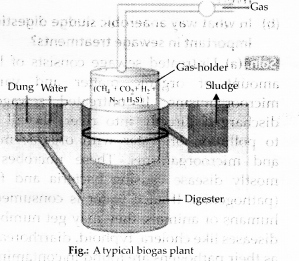
Question 4.
Describe the main ideas behind the biological control of pests and diseases.
Answer:
The natural method of pest and pathogen control involving the use of viruses, bacteria and other insects is called biocontrol or biological control. Main ideas behind biological control of pests and diseases were to replace or supplement the use of chemical pesticides in order to reduce their ill effects. The bio-control agents are non-toxic, non persistent and biodegradable.
A few examples are as follows:
Question 5.
(a) What would happen if a large volume of untreated sewage is discharged into a river?
(b) In what way anaerobic sludge digestion is important in sewage treatments?
Answer:
(a) Untreated sewage consists of large amount of organic matter and various microorganisms. If untreated sewage is discharged directly into river, it will lead to pollution of water with organic matter and microorganisms. These microbes are mostly disease causing bacteria and fungi (pathogenic). If such water is consumed by humans or animals, they may get number of diseases like cholera, typhoid, diarrhorea, etc. as their pathogens are found in contaminated water. At the same time high amount of organic waste increases biological oxygen demand and decrease the amount of dissolved oxygen in water which become toxic for animals and plants living in water and causes death of aquatic organisms like fish etc.
(b) In anaerobic sludge digestion, major part of activated sludge is pumped into anaerobic sludge digester. These anaerobic bacteria digest the bacteria and fungi and produce a mixture of gases like methane, carbon dioxide and H2S, which are used as biogas. It also produces manure at same time.
Question 6.
Which type of food would have lactic acid bacteria? Discuss their useful application.
Answer:
Dairy products such as curd, butter milk, cheese etc. have lactic acid bacteria (LAB).
We hope the NCERT Exemplar Solutions for Class 12 Biology chapter 10 Microbes in Human Welfare help you. If you have any query regarding . NCERT Exemplar Solutions for Class 12 Biology chapter 10 Microbes in Human Welfare, drop a comment below and we will get back to you at the earliest.
These Solutions are part of NCERT Exemplar Solutions for Class 12 Biology. Here we have given NCERT Exemplar Solutions for Class 12 Biology chapter 14 Ecosystem
Multiple Choice Questions
Question 1.
Decomposers like fungi and bacteria are
(i) autotrophs
(ii) heterotrophs
(iii) saprotrophs
(iv) chemoautotrophs.
Choose the correct answer.
(a) (i) and (iii)
(b) (i) and (iv)
(c) (ii) and (iii)
(d) (i) and (ii)
Answer:
(c) : Decomposers like bacteria and fungi are heterotrophs because they are dependent on others for their food as they cannot make their own food. They are also called saprotrophs because they feed on dead and decaying organic matter.
Question 2.
The process of mineralisation by micro organisms helps in the release of
(a) inorganic nutrients from humus
(b) both organic and inorganic nutrients from detritus
(c) organic nutrients from humus
(d) inorganic nutrients from detritus and formation of humus.
Answer:
(a) : Mineralisation is the release of inorganic substances, both non-mineral (e.g., CO2, H2O) and minerals (e.g., Ca2+, Mg2+, K+, NH4+) from organic matter. The process is slow because of trapping of these nutrients in humus and their immobilisation in decomposers/detritivores. It prevents their washing out or leaching. Nutrients get immobilised in decomposer microbes and detritivores are again exposed to humification and mineralisation after the death of these organisms. its productivity. It is measured as weight (e.g., g/m2/yr) or energy (e.g., kcal/m2/yr). Hence, only unit (iv) is correct.
Question 3.
Productivity is the rate of production of biomass expressed in terms of
(i) (kcal m-3)yr-1
(ii) gyr-1
(iii) g-1 yr-1
(iv) (kcal m-2) yr-1
(a) (ii)
(b) (iii)
(c) (ii) and (iv)
(d) (i) and (iii)
Answer:
(None of the options is correct):
The rate of synthesis of energy containing organic matter or biomass by any trophic level per unit area in unit time is described as
Question 4.
An inverted pyramid of biomass can be found in which ecosystem?
(a) Forest
(b) Marine
(c) Grassland
(d) Tundra
Answer:
(b) : Biomass basically depends upon reproductive potential and age of individuals. In an aquatic ecosystem, producers have least biomass and this value gradually shows an increase towards the apex of the pyramid, thus making the pyramid inverted in shape.
Question 5.
Which of the following is not a producer?
(a) Spirogyra
(b) Agaricus
(c) Volvox
(d) Nostoc
Answer:
(b) : Spirogyra, Volvox and Nostoc are chlorophyll containing organisms and thus prepare their own food. Agaricus is a fungus (Basidiomycetes), it is a chlorophyllous and not a producer. It possesses saprotrophic mode of nutrition.
Question 6.
Which of the following ecosystems is most productive in terms of net primary production?
(a) Deserts
(b) Tropical rainforests
(c) Oceans
(d) Estuaries
Answer:
(b) : Tropical rainforests have an average net primary productivity (NPP) of 1,500 g/m2/ yr. Open oceans and deserts have average NPP of 125 and 90g/m2/yr respectively. Algal beds and reefs ecosystem have average NPP of 2,500 g/m2/yr.
Question 7.
Pyramid of numbers is
(a) always upright
(b) always inverted
(c) either upright or inverted
(d) neither upright nor inverted.
Answer:
(c) : Ecological pyramids are pictorial representation of relationship between organisms at different trophic levels, regarding energy, biomass or number. Pyramid of numbers can be either upright or inverted. For example in a grassland ecosystem, number of primary consumers are less than primary producers and that of secondary consumers are less than primary consumers and so on. On the other hand, if a single big tree ecosystem is taken into consideration, pyramid of number will be inverted.

Question 8.
Approximately how much of the solar energy that falls on the leaves of a plant is converted to chemical energy by photosynthesis?
(a) Less than 1%
(b) 2-10%
(c) 30%
(d) 50%
Answer:
(b) : 50% of the solar energy incident over earth is present in PAR (photosynthetically active radiation). About 1-5% of total incident solar energy or 2-10% of PAR is captured by the photosynthetic organisms for photosynthesis.
Question 9.
Among the following, where do you think the process of decomposition would be the fastest?
(a) Tropical rainforest
(b) Antarctic
(c) Dry arid region
(d) Alpine region
Answer:
(a) : Tropical rainforests are the richest and most productive ecosystem in the world. Consequently, the rate of decomposition is also high, as the conditions of moisture and temperature are optimum.
Question 10.
How much of the net primary productivity of a terrestrial ecosystem is eaten and digested by herbivores?
(a) 1%
(b) 10%
(c) 40%
(d) 90%
Answer:
(b) : Energy flow in the ecosystem follows the ten percent law (put forth by Lindemann in 1942).
From the level of primary producers onwards, only 10% of energy is stored at the higher trophic level and 90% is lost (as heat or in respiration etc). This energy transfer forms the basis of life.
![]()
Question 11.
During the process of ecological succession the changes that take place in communities are
(a) orderly and sequential
(b) random
(c) very quick
(d) not influenced by the physical environment.
Answer:
(a) : Biotic or ecological succession is the natural development of a series of biotic communities at the same site, one after the other till a climax community develops which does not change further because it is in perfect harmony with the environment of the area. The change is orderly and sequential. The first biotic community which develops in a bare area is called pioneer community. It has very little diversity. Climax community is a stable, self perpetuating and final biotic community that develops at the end of biotic succession.
Question 12.
Climax community is in a state of
(a) non-equilibrium
(b) equilibrium
(c) disorder
(d) constant change.
Answer:
(b) : The process of sequential establishment of various plant communities in any habitat is called plant succession. Finally that community is established which is in complete equilibrium with the prevailing environment. This stage is called climax stage and its establishment is called stabilisation.
Question 13.
Among the following biogeochemical cycles which one does not have losses due to respiration?
(a) Phosphorus
(b) Nitrogen
(c) Sulphur
(d) All of the above
Answer:
(d) : Phosphorus, nitrogen and sulphur do not have losses due to respiration because they are not particularly involved in gaseous exchange.
Question 14.
The sequence of communities of primary succession in water is
(a) phytoplankton, sedges, free-floating hydrophytes, rooted hydrophytes, grasses and trees
(b) phytoplankton, free-floating hydrophytes, rooted hydrophytes, sedges, grasses and trees
(c) free-floating hydrophytes, sedges, phyto-plankton, rooted hydrophytes, grasses and trees
(d) phytoplankton, rooted submerged hydro-phytes, floating hydrophytes, reed swamp, sedges, meadow and trees.
Answer:
(d) : Primary succession in water is also called as hydrarch, which will lead from hydric to mesic conditions. Phytoplanktons (autotrophic) are generally the first to appear. Later zooplanktons feeding on phytoplanktons also appear. Next stage is characterised by the soft mud on the bottom having organic matter favouring the growth of rooted submerged plants. They are then replaced by free floating hydrophytes (Lenina, Woljfia etc). Rapid growth of these plants build up bottom so that water becomes shallow on periphery. In this shallow water, comes the reed swamp stage (e.g. Typha). They produce abundant organic matter. Next stages are sedge and meadow stage which transpire rapidly and build up soil, on which the next stage, trees can grow.
Question 15.
The reservoir for the gaseous type of biogeo-chemical cycle exists in
(a) stratosphere
(b) atmosphere
(c) ionosphere
(d) lithosphere.
Answer:
(b) : Biogeochemical cycles can be grouped into 3 types:
Question 16.
If the carbon atoms fixed by producers already have passed through three species, the trophic level of the last species would be
(a) scavenger
(b) tertiary producer
(c) tertiary consumer
(d) secondary consumer.
Answer:
(c) : Length of a food chain i.e. number of trophic levels is limited by the efficiency of energy transfer i.e. 10% law.
Producers —> 1° consumers —> 2°consumers —> 3° consumers
If the carbon atoms fixed by producers already have passed through three species then the trophic level of the last species (i.e. third species) would be tertiary consumer. Scavengers (e.g. vultures) can be tertiary consumers, but they can be at other trophic levels too.
Question 17.
Which of the following type of ecosystem is expected in an area where evaporation exceeds precipitation, and mean annual rainfall is below 100mm?
(a) Grassland
(b) Shrubby forest
(c) Desert
(d) Mangrove
Answer:
(c) : Deserts have been variously classified as true deserts, having less than 120 mm annual rainfall, or extreme deserts showing less than 70 mm annual rainfall. In desert biomes, evaporation from soil always exceeds rainfall by 7 to 50 times.
Question 18.
The zone at the edge of a lake or ocean which is alternatively exposed to air and immersed in water is called
(a) Pelagic zone
(b) Benthic zone
(c) Lentic zone
(d) Littoral zone.
Answer:
(d) : Littoral zone is the shallow coastal zone. Light is available upto bottom in this zone. Therefore, producers are found throughout from surface to bottom in this zone. Rooted vegetation occurs along shores. Consumers are also available throughout i.e., from surface to the bottom in this zone.
Question 19.
Edaphic factor refers to
(a) water
(b) soil
(c) relative humidity
(d) altitude.
Answer:
(b) : Edaphic factors are classified under the abiotic factors affecting an ecosystem. Edaphic factors include factors of soil e.g. soil texture, substratum, topography, mineral composition, pH etc. These factors can influence the distribution and interrelationships of organisms, as well as rate of decomposition.
Question 20.
Which of the following is an ecosystem service provided by a natural ecosystem?
(a) Cycling of nutrients
(b) Prevention of soil erosion
(c) Pollutant absorption and reduction of the threat of global warming
(d) All of the above
Answer:
(d) : The products of ecosystem processes which have environmental, aesthetic and indirect economic value are named as ecosystem services. Soil formation and soil protection are the major ecosystem services accounting for nearly 50% of their total worth. Plant cover protects the soil from drastic changes in temperature. There is little wind or water erosion as soil particles are not exposed to them. The soil remains spongy and fertile. There are no landslides and no floods. Plant cover of natural ecosystem absorbs polluting gases, causes settling of suspended particulate matter, removes C02 and releases 0:. Purified air becomes available. There is no overall depletion of nutrients as the same are repeatedly circulated and recirculated. This keeps the fertility of soil intact.
Very Short Answer Type Questions
Question 1.
Name an organism found as secondary carnivore in an aquatic ecosystem.
Answer:
Large fish, catfish, water snake.
Question 2.
What does the base tier of the ecological pyramid represent?
Answer:
If Producers represent the base tier of the ecological pyramid.
Question 3.
Under what conditions would a particular stage in the process of succession revert back to an earlier stage?
Answer:
If At any time during primary or secondary succession, natural or human induced disturbances like fire, deforestation etc. can convert a particular seral stage of succession to an earlier stage.
Question 4.
Arrange the following as observed in vertical stratification of a forest: Grass, Shrubby plants, Teak, Amaranthus.
Answer:
Vertical stratification of forest are grass, Amaranthus, shrubby plants, teak.
Question 5.
Name an omnivore which occurs in both grazing food chain and the decomposer food chain.
Answer:
Crow is omnivore and occur in both grazing food chain and decomposer food chain.
Question 6.
Justify the pitcher plant as a producer.
Answer:
Leaf lamina in pitcher plant is modified into pitcher and consists of chlorophyll. It also undergoes photosynthesis, therefore pitcher plant is a producer.
Question 7.
Name any two organisms which can occupy more than one trophic level in an ecosystem.
Answer:
If Man and sparrow occupy more than one trophic level in an ecosystem.
Question 8.
In the North East region of India, during the process of Jhum cultivation, forests are cleared by burning and left for regrowth after a year of cultivation. How would you explain the regrowth of forest in ecological term?
Answer:
In Jhum cultivation, farmers cut down the trees of the forest and burn the plant remains. The ash is used as a fertiliser and land is used for farming or cattle grazing. After cultivation the area is left for several years so as to allow its recovery. This regrowth of forest is called secondary succession.
Question 9.
Climax stage is achieved quickly in secondary succession as compared to primary succession. Why?
Answer:
If Secondary succession occurs on a fertile land where living matter is already existing, whereas primary succession begins on a barren sterile area with no living matter present in it.
Question 10.
Among bryophytes, lichens and ferns which one is a pioneer species in a xeric succession?
Answer:
Crustose lichens are the pioneer species in xeric succession.
Question 11.
What is the ultimate source of energy for the ecosystems?
Answer:
Sun is the ultimate source of energy for the ecosystem.
Question 12.
Is the common edible mushroom an autotroph or a heterotroph?
Answer:
Edible mushroom is a heterotroph, as it is without chlorophyll and does not perform photosynthesis.
Question 13.
Why are oceans least productive?
Answer:
Question 14.
Why is the rate of assimilation of energy at the herbivore level called secondary productivity?
Answer:
Herbivores are primary consumers and depend on plants to obtain biomass. Plants are producers and herbivores gain biomass from them by primary productivity. Rate of assimilation of primary productivity at the herbivore level is therefore, called secondary productivity.
Question 15.
Why are nutrient cycles in nature called biogeochemical cycles?
Answer:
The nutrients move from living organisms to environment in a cyclic manner and similarly back to the organism. Therefore, nutrient cycles in nature are called biogeochemical cycles.
Question 16.
Give any two examples of xerach succession.
Answer:
Question 17.
Define self sustainability.
Answer:
Self sustainability is the utilisation of natural resources in a way that their rate of consumption is equal to the rate of regeneration, so that same amount becomes available to the next generation. It is possible by judicious utilisation and avoiding wastage.
Question 18.
Given below is a figure of an ecosystem. Answer the following questions.
(1) What type of ecosystem is shown in figure.
(2) Name any plant that is characteristic of such ecosystem.

Answer:
Question 19.
What is common to earthworm, mushroom, soil mites and dung beetle in an ecosystem.
Answer:
All are decomposers involved in decomposition of organic remains.
Short Answer Type Questions
Question 1.
Organisms at a higher trophic level have less energy available. Comment.
Answer:
This is because of 10% (ten percent) law which was proposed by Lindemann 1942. According to this law, during transfer of energy from lower trophic level to higher trophic level 90% of energy is lost, and only 10% of energy is transferred to next trophic level. As the trophic level increases, the available energy goes on decreasing.
Question 2.
The number of trophic levels in an ecosystem are limited. Comment.
Answer:
The amount of energy made available in a trophic level goes on decreasing from lower level to higher level. The transfer of energy follows 10% law. According to this a stage comes when energy available is too less to sustain the trophic level. Therefore number of trophic levels in an ecosystem remain limited.
Question 3.
Is an aquarium a complete ecosystem?
Answer:
Yes, a balanced aquarium is a artificial ecosystem consisting of both biotic and abiotic components. Water, oxygen supply source, light source are abiotic factors, whereas aquatic plants, small animals and decomposers serve as biotic components.
Question 4.
What could be the reason for the faster rate of decomposition in the tropics?
Answer:
Tropics mostly have temperature above 25°C, along with humid conditions, which is suitable environment for growth and multiplication of decomposers. That is why rate of decomposition is faster in tropics.
Question 5.
Human activities interfere with carbon cycle. List any two such activities.
Answer:
Human activities that are adding CO2 to the atmosphere are
Question 6.
Flow of energy through various trophic levels in an ecosystem is unidirectional and non- cyclic. Explain.
Answer:
Ultimate source of energy is sun. Green plants (producers) produce food by using solar energy. This food is consumed by herbivores (Primary consumers) to get energy. The energy is further transferred to next levels of consumers i.e., secondary consumers and tertiary consumers. During transfer of energy about 90% of it is wasted or consumed up in respiration and only 10% becomes part of the higher trophic level. The energy cannot be transferred from consumers to producers and even to the sun. Therefore, energy transfer is always unidirectional and non-cyclic accompanied by decrease in usable energy.
Question 7.
Apart from plants and animals, microbes form a permanent biotic component in an ecosystem. While plants have been referred to as autotrophs and animals as heterotrophs, what are microbes referred to as? How do the microbes fulfil their energy requirements?
Answer:
Microorganisms like bacteria and fungi are heterotrophs and are known as decomposers. They fulfil their energy needs by decomposition, which involves break down of complex organic matter into simple compounds. They absorb these simplified compounds and use them during their metabolism.
Question 8.
Poaching of tiger is a burning issue in today’s world. What implication would this activity have on the functioning of the ecosystem of which the tigers are integral part?
Answer:
Tigers and lions are top carnivores and play an important role in maintaining the stability of an ecosystem. Excessive poaching of tigers will lead to increase in population size of herbivores which in turn will damage the crops in abundance. This will create an imbalance in the ecosystem and will make it unstable.
Question 9.
In relation to energy transfer in ecosystem, explain the statement “10 kg of deer’s meat is equivalent to 1 kg of lion’s flesh”.
Answer:
The statement is very true, because lion is a predator which eats deer. According to 10% energy transfer law only 10% of energy will be made available to the lion from deer, and 90% of the energy will be lost in the atmosphere during transfer.
Question 10.
Primary productivity varies from ecosystem to ecosystem. Explain?
Answer:
Primary productivity is the amount of energy accumulation in green plants as biomass or organic matter per unit area over a time period through the process of photosynthesis. Primary productivity in an ecosystem depends on number of factors like photosynthetic capacities of producers, environmental factors like temperature, sunlight intensity, rainfall and availability of nutrients. These factors are different in different ecosystems, therefore productivity varies from ecosystem to ecosystem. In tropical rainforest primary productivity is high 20 tones/hectare/year whereas in desert it is low 0.7 tones /hectare/year.
Question 11.
Sometimes due to biotic/abiotic factor the climax remain in a particular seral stage (pre climax) without reaching climax. Do you agree with this statement. If yes give a suitable example.
Answer:
Yes, this statement is right. Sometimes certain biotic or abiotic factors do not let a seral stage to reach climax, and process of succession may get arrested at pre-climax stage. This may be due to certain reasons like forest fires, land slide, change in soil characteristic, increase in herbivore population and overgrazing etc.
Question 12.
What is an incomplete ecosystem? Explain with the help of suitable example.
Answer:
lf any essential component of an ecosystem is absent in an ecosystem, it is said to be an incomplete ecosystem. E.g., an ecosystem at the bottom of fish tank or deep aphotic zone of the ocean. In both cases producers are absent, therefore both are the examples of incomplete ecosystem.
Question 13.
What are the shortcomings of ecological pyramids in the study of ecosystem?
Answer:
Shortcoming of ecological pyramids are:
Question 14.
How do you distinguish between humification and mineralisation?
Answer:
Humification – The process by which detritus is changed into dark-coloured amorphous substance called humus, which acts as a reservoir of nutrients.
Mineralisation – The process by which inorganic substances (water, CO2) and minerals (Ca, Mg’1″, KT NH4+) are released in the soil.
Question 15.
Fill in the trophic levels (1, 2, 3 and 4) in the boxes provided in the figure.
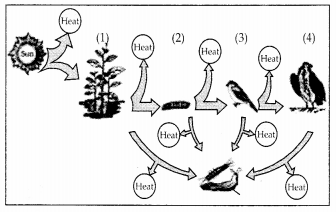
Answer:
(1) is T1 first trophic level i.e., producers
(2) is T2 – Second Trophic level i.e., herbivore (Primary consumer)
(3) is T3 – Third trophic level i.e., small carnivorous bird (Secondary consumers)
(4) is T4– Fourth Trophic level i.e., large carni-vorous bird (tertiary consumers)
Question 16.
The rate of decomposition of detritus is affected by the abiotic factors like availability of oxygen, pH of the soil substratum, temperature etc. Discuss.
Answer:
Breakdown of complex organic compounds of dead bodies of plants and animals and wastes of animals by microbial action into simple substances is known as decomposition.
It depends on various factors like –
Long Answer Type Questions
Question 1.
A farmer harvests his crop and expresses his harvest in three different ways.
(a) I have harvested 10 quintals of wheat.
(b) I have harvested 10 quintals of wheat today in one acre of land.
(c) I have harvested 10 quintals of wheat in one acre of land, 6 months after sowing.
Do the above statements mean one and the same thing. If your answer is yes, give reasons. And if your answer is ‘no’ explain the meaning of each expression.
Answer:
NO, the above three statements do not mean one and the same thing because –
Question 2.
Justify the following statement in terms of ecosystem dynamics.”Nature tends to increase the gross primary productivity, while man tends to increase the net primary productivity”.
Answer:
Gross primary productivity of an ecosystem is the rate of production of organic matter during photosynthesis. Nature always tend to increase gross primary productivity. Ecological succession is the natural development of a series of biotic communities at the same site, one after the other till a climax community develops which does not change further because it is in perfect harmony with the environment of the area.
In ecological succession there is tendency to increase species diversity, complexity of organisms, and gross primary productivity as higher serai communities have higher photosynthetic efficiency.
Net primary productivity is the available biomass for the consumption to heterotrophs. It is equal to the rate of organic matter created by photosynthesis minus the rate of respiration and other losses.
NPP = GPP – R
Human always tries to increase net primary productivity by cultivating food and crops, which are important for our survival.
Question 3.
Which of the following ecosystems will be more productive in terms of primary productivity? Justify your
A young forest, a natural old forest, a shallow polluted lake, alpine meadow.
Answer:
Primary productivity is the rate of biomass or organic matter produced per unit area over a time period by green plants during photosynthesis. Primary productivity depends upon the type of ecosystem. The ecosystem which has more producers, will be more productive in terms of primary productivity. A young forest will be more productive than an old forest. It is because the rate of total photosynthesis will be highest in it, due to fully grown vegetation, more number and large surface area of the leaves and higher quantum number. On the other hand, a shallow polluted lake will have low oxygen content and an alpine area is at high altitude where low temperature inhibits productivity.
Question 4.
What are the three types of ecological pyramids. What information is conveyed by each pyramid with regard to structure, function and energy in the ecosystem.
Answer:
An ecological pyramid is a graphic representation of an ecological parameter like number of individuals present in various trophic levels of a food chain with producers forming the base and top carnivores the tip. Each trophic level represents a functional level.
There are three types of ecological pyramids.
(1) Pyramid of numbers
(2) Pyramid of biomass
(3) Pyramid of energy
(1) Pyramid of numbers : It is a graphic representation of the number of individuals per unit area of various trophic levels stepwise with producers being kept at the base and top carnivores kept at the tip. In most cases the pyramid of number is upright with members of successive higher trophic level being fewer than the previous one.
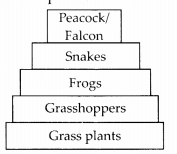
In a grassland, a larger number of grass plants or herbs support a fewer number of grasshoppers that support a still smaller number of frogs, the latter still smaller number of snakes and the snakes very few peacocks or falcons. This is, however, not applicable in all the cases.
A single large sized producer like tree can, however, provide nourishment to several herbivores (e.g., birds). The birds may support a still larger population of ectoparasites. Such a pyramid shall be inverted.
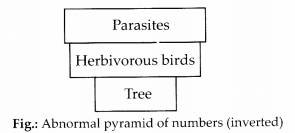
(2) Pyramid of biomass : The amount of living organic matter is called biomass. It is measured both as fresh and dry- weight. Pyramid of biomass is a graphic representation of biomass present sequence-wise per unit area of different trophic levels with producers at the base and top carnivores kept at the tip.
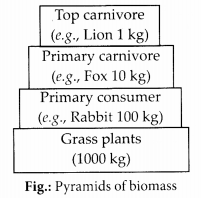
Maximum biomass occurs in producers. There is a progressive reduction of biomass found in herbivores, primary carnivores, secondary carnivores, etc. It is found that about 10-20% of the biomass is transferred from lower trophic level to higher trophic level.

Pyramid of biomass is upright for terrestrial habitats. Inverted or spindle¬shaped pyramids are obtained in aquatic habitats where the biomass of a trophic level depends upon reproductive potential and longevity of its members,
(3) Pyramid of energy – It is graphic representation of amount of energy trapped per unit time and area in different trophic levels of food chain. It is always upright as the amount of energy always decreases from lower to higher trophic level of food chain and follows 10% energy transfer law.
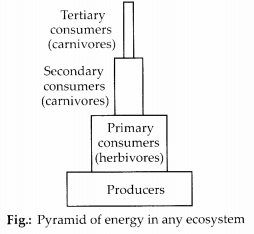
Question 5.
Write a short note on pyramid of numbers and pyramid of biomass.
Answer:
Re/er answer 4.
Question 6.
Given below is a list of autotrophs and heterotrophs. With your knowledge about food chain, establish various linkages between the organisms on the principle of’eating and being eaten’. What is the this inter-linkage established known as?
Algae, Hydrilla, grasshopper, rat, squirrel, crow, maize plant, deer, rabbit, lizard, wolf, snake, peacock, phytoplankton, crustaceans, whale, tiger, lion, sparrow, duck, crane, cockroach, spider, toad, fish, leopard, elephant, goat, Nymphaea, Spirogyra.
Answer:
A straight line sequence of ‘who eats whom’ or eating and being eaten in an ecosystem is called a food chain. A network of cross connecting food chains involving producers, consumers and decomposers are termed as a food web.
Lion, tiger, leopard, whale – Top carnivore (Top trophic level)
Spider, cockroach, lizard, wolf, snake, toad, fish, crow, sparrow, crane, duck, peacock – Secondary consumers (IIIrd trophic level).
Crustaceans, grasshopper, deer, rat, squirrel, rabbit, elephant, goat – Primary consumer (IInd trophic level). Phytoplankton, algae, Hydrilla, maize plant, Nymphaea, Spirogyra – Producers (Ist trophic level).
Question 7.
“The energy flow in the ecosystem follows the second law of thermodynamics”. Explain.
Answer:
Second law of thermodynamics, also called law of entropy, states that energy transfer or energy transformation is never cent percent. It involves degradation or dissipation of energy from a concentrated to a dispersed form as is used to maintain the metabolism. So only a part of energy is stored in the biomass. When a producer (plant) traps radiant energy for photosynthesis, only 2-10% of PAR (only 1-5% of incident solar radiations) is used for photosynthesis called GPP. About 0.2 to 1% of incident radiations is used by plants for respiration and 0.8 to 4% of incident radiations is used to produce biomass called NPP.
When a herbivore eats a producer about 90% of energy will be dissipated and only 10% of energy is available for producing biomass. It will be repeated when herbivore will be eaten by a carnivore. It is called 10% (ten percent) law which was proposed by Lindemann, 1942.
Question 8.
What will happen to an ecosystem if:
(a) All producers are removed;
(b) All organisms of herbivore level are eliminated; and
(c) All top carnivore population is removed.
Answer:
(a) In food chain plants occupy the place of producers. They are the source of food or energy for every organism. If plants producers are removed there will be reduction in primary productivity. No biomass will be available for consumption to higher levels of organisms and they all will die.
(b) If all herbivores are eliminated, there will be increase in primary productivity because of lack of consumers. Carnivores population will starve to death due to unavailability of food.
(c) ‘If all top carnivores are removed, the population of herbivores will increase. They will consume more producers, which can lead to desertification.
Question 9.
Give two examples of artificial or man made ecosystems. List the salient features by which they differ from natural ecosystems.
Answer:
Artificial or man-made ecosystem is created and maintained by human beings. Agriculture, garden, aquarium are artificial
ecosystems.
In artificial ecosystem, biotic and abiotic components are maintained artificially e.g., feeding, cleaning and supply of oxygen to fishes in aquarium.
A natural ecosystem is one which develops in nature without human support or interference i.e., forest, marine ecosystem.
In natural ecosystem, biotic and abiotic components are maintained naturally like light, nutrient cycle, self-sustainability, etc.
Question 10.
The biodiversity increases when one moves from the pioneer to the climax stage. What could be the explanation?
Answer:
The biodiversity increases in an ecological succession when one moves from pioneer community to climax stage due to following reasons –
Question 11.
What is a biogeochemical cycle. What is the role of the reservoir in a biogeochemical cycle. Give an example of a sedimentary cycle with resefvoir located in earth’s crust.
Answer:
Biogeochemical cycles are cyclic pathways through which chemical elements move from environment to organism and back to the environment. Biogeochemicals are essential elements required by the organism for their body building and metabolism, which are provided by earth and return to earth after their death and decay.
Reservoir pool is the reservoir of biogenetic nutrients from which the latter are slowly transferred to cycling pool e.g., phosphates in rocks. The function of reservoir is to meet deficient of nutrient which occurs due to differences in rate of influx and efflux. Atmosphere acts as reservoir pool for carbon and nitrogen cycles.
Phosphorus cycle is an example of sedi-mentary cycle.Phosphate present in the soil may occur in the insoluble form, which is dissolved by chemicals secreted by microbes and plant roots. The dissolved phosphate when absorbed by the plant as orthophosphate ions change to organic form and is then transferred to consumers and decomposer through food chain. Animal excretion and dead bodies when acted upon by decomposer, releases phosphorus, which is recycled/reutilised again. Leaching, erosion and mining also releases phosphate and make it available to plants. In aquatic environment, phosphate is taken from water by phytoplankton, consumed by zooplankton, which in turn excrete it into water.
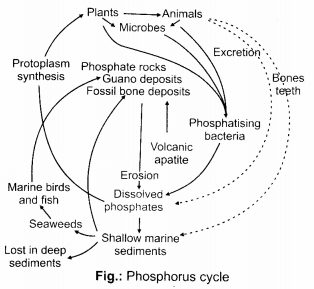
Question 12.
What will be the P/R ratio of a climax community and a pioneer community. What explanation could you offer for the changes seen in P/R ratio of a pioneer community and the climax community.
Answer:
The species that invade a bare area are called pioneer species. These are generally lichens. A pioneer community has maximum number of producers. The rate of production P is higher than rate of respiration R. Therefore P/R ratio of pioneer community is more than 1. This increases the biomass. But with the progress in succession i.e., advancement towards climax community biomass of organisms increases and P/R ratio becomes equal to 1. This shows stability of the ecosystem.
When number of organisms increases by reaching climax community, rate of respiration increases greater than rate of production and community is dominated by heterotroph, where P/R ratio become less than 1.
We hope the NCERT Exemplar Solutions for Class 12 Biology chapter 14 Ecosystem help you. If you have any query regarding .NCERT Exemplar Solutions for Class 12 Biology chapter 14 Ecosystem, drop a comment below and we will get back to you at the earliest.
These Solutions are part of NCERT Exemplar Solutions for Class 12 Biology. Here we have given NCERT Exemplar Solutions for Class 12 Biology chapter 2 Sexual Reproduction,in Flowering Plants
Multiple Choice Questions
Question 1.
Among the terms listed below, those that are not technically correct names for a floral whorl are
(a) androecium
(b) corolla|
(c) (i) and (iv)
(d) (ii) and (iv)
Answer:
(c) : The technically correct terms for the floral whorls are (from outermost to innermost) calyx, corolla, androecium and gynoecium. They are made up of sepals, petals, stamens and carpels, respectively.
Question 2.
Embryo sac is to ovule as________ is to an anther.
(a) stamen
(b) filament
(c) pollen grain
(d) androecium
Answer:
(c) : A typical carpel consist of ovary which can have many ovules. Each ovule has an embryo sac, which in turn has a single egg cell. Similarly, in majority of angiosperms each stamen consists of a bilobed anther, which in turn has two pollen sacs in each lobe, consisting of pollen grains.
Question 3.
In a typical complete, bisexual and hypogynous flower the arrangement of floral whorls on the thalamus from the outermost to the innermost is
(a) calyx, corolla, androecium and gynoecium
(b) calyx, corolla, gynoecium and androecium|
(c) gynoecium, androecium, corolla and calyx
(d) androecium, gynoecium, corolla and calyx.
Answer:
(a)
Question 4.
A dicotyledonous plant bears flowers but never produces fruits and seeds. The most probable cause for the above situation is
(a) plant is dioecious and bears only pistillate flowers
(b) plant is dioecious and bears both pistillate and staminate flowers
(c) plant is monoecious
(d) plant is dioecious and bears only staminate flowers.
Answer:
(d) : Fruits can develop from a single ovary of a single flower (simple fruit) or from several free carpels of a single flower (aggregate) or from whole inflorescence (multiple). In total, fruits develop from ovaries. This is why, a dioecious plant (unisexual) bearing only staminate (male) flowers will not produce fruits, whereas monoecious plants (bisexual) or dioecious plants bearing only pistillate (female) flowers or pistillate and staminate both can bear fruits (pollination).
Question 5.
The outermost and innermost wall layers of microsporangium in an anther are respectively
(a) endothecium and tapetum
(b) epidermis and endodermis
(c) epidermis and middle layer
(d) epidermis and tapetum.
Answer:
(d) : The wall layers of a microsporangium from outermost to innermost are : epidermis, endothecium, middle layers and tapetum. The first three layers generally provide protection and help in dehiscence of anther. Tapetum performs nutritive function for pollen grains.
Question 6.
During microsporogenesis, meiosis occurs in
(a) endothecium
(b) microspore mother cells
(c) microspore tetrads
(d) pollen grains.
Answer:
(b) : Microsporogenesis is the formation of microspores in the form of tetrads, which later separate and are called pollen grains. Microspore mother cell (2n) undergoes meiosis for the formation of haploid pollen grains formed first in the form of spore tetrads.
Question 7.
From among the sets of terms given below, identify those that are associated with the gynoecium.
(a) Stigma, ovule, embryo sac, placenta
(b) Thalamus, pistil, style, ovule
(c) Ovule, ovary, embryo sac, tapetum
(d) Ovule, stamen, ovary, embryo sac
Answer:
(a) : Stigma,is a part of pistil on which pollen grain lands. Each ovary may have many ovules, which have embryo sacs in them. Placenta is a tissue inside ovary to which ovules are attached. Thalamus is the terminal part of the axis of flower which bears all floral appendages. Tapetum is the innermost layer of microsporangium while stamen is component of androecium.
Question 8.
Starting from the innermost part, the correct sequence of parts in an ovule are
(a) egg, nucellus, embryo sac, integument
(b) egg, embryo sac, nucellus, integument
(c) embryo sac, nucellus, integument, egg
(d) egg, integument, embryo sac, rtucellus.
Answer:
(b) : Egg cell is inside the embryo sac in the ovule. The embryo sac is further enclosed by the parenchymatous tissue, nucellus, which later provides nutrition to developing embryo. Nucellus is ultimately surrounded by integuments.
Question 9.
From the statements given below choose the option that are true for a typical female gametophyte of a flowering plant.
(1) It is 8-nudeate and 7-celled at maturity.
(2) It is free-nuclear during the development.
(3) It is situated inside the integument but outside the nucellus.
(4) It has an egg apparatus situated at the chalazal end.
(a) (i) and (iv)
(b) (ii) and (iii)
(c) (i) and (ii)
(d) (ii) and (iv)
Answer:
(c) : Female gametophyte or embryo ‘* sac is present in the nucellus of an ovule. It is formed by free nuclear mitotic divisions of megaspore which forms 8 nucleate structure (4 nuclei each at micropylar and chalazal end). One nucleus from each side moves to the middle to form polar nuclei which later on fuse to form secondary nucleus. The remaining three nuclei at each end get surrounded by wall to form cells. Hence, female gametophyte is 8-nucleate and 7-celled at maturity because of presence of secondary nucleus. Egg apparatus is situated at the micropylar end whereas 3 antipodal s are situated at chalazal end.
Question 10.
Autogamy can occur in a chasmogamous flower if
(a) pollen matures before maturity of ovule
(b) ovules mature before maturity of pollen
(c) both pollen and ovules mature simultaneously
(d) both anther and stigma are of equal lengths.
Answer:
(c) : Autogamy is pollination within a flower, chasmogamous flowers are those in which anthers and stigma are exposed. For autogamy, in such a flower to take place, pollen and ovule should mature simultaneously and anther and stigma should lie close to each other.
Question 11.
Choose the correct statement from the following.
(a) Cleistogamous flowers always exhibit autogamy.
(b) Chasmogamous flowers always exhibit geitonogamy.
(c) Cleistogamous flowers exhibit both autogamy and geitonogamy.
(d) Chasmogamous flowers never exhibit autogamy.
Answer:
(a) : Autogamy is pollination within the same flower. Geitonogamy is pollination between different flowers of same plant. Xenogamy is pollination between flowers of different plants of same species. Cleistogamous flowers (that do not open at all) always exhibit autogamy, where as chasmogamous flowers (with exposed anthers and stigma) can exhibit autogamy, geitonogamy or xenogamy.
Question 12.
A particular species of plant produces light, non-sticky pollen in large numbers and its stigmas are long and feathery. These modifications facilitate pollination by
(a) insects
(b) water
(c) wind
(d) animals
Answer:
(c) : Light, non-sticky pollens produced in large numbers are generally traits of wind pollinated (anemophilous) plants. Insect and animal pollinated plants have sticky pollens. Long and feathery stigma is also characteristic of anemophilous plants. Maize, Cannabis and many grasses are some of the examples of this category.
Question 13.
From among the situations given below, choose the one that prevents both autogamy and geitonogamy.
(a) Monoecious plant bearing unisexual flowers.
(b) Dioecious plant bearing only male or female flowers.
(c) Monoecious plant with bisexual flowers.
(d) Dioecious plant with bisexual flowers.
Answer:
(b) : Monoecious plant (bisexual) bearing either bisexual or unisexual flowers can exhibit both autogamy as well as geitonogamy. Dioecious (unisexual) plants bearing only male or female flowers will not show autogamy or geitonogamy hence, only xenogamy is possible.
Question 14.
In a fertilised embryo sac, the haploid, diploid and triploid structures are
(a) synergid, zygote and primary endosperm nucleus
(b) synergid, antipodal and polar nuclei
(c) antipodal, synergid and primary endosperm nucleus
(d) synergid, polar nuclei and zygote.
Answer:
(a) : Double fertilisation is the fusion of two male gametes brought by a pollen tube with two different cells of the same female gametophyte in order to produce two different structures. It is found only in angiosperms where it was first discovered by Nawaschin in 1898 in Fritillaria and Lilium. Out of the two male gametes one fuses with egg or oosphere to perform generative fertilisation. Generative fertilisation is also called syngamy or true fertilisation. It gives rise to a diploid zygote or oospore. The second male gamete fuses with two haploid polar nuclei or diploid secondary nucleus of the central cell to form a triploid primary endosperm nucleus (PEN). This is called as vegetative fertilisation (or triple fusion).
Question 15.
In an embryo sac, the cells that degenerate after fertilisation are
(a) synergids and primary endosperm cell
(b) synergids and antipodals
(c) antipodals and primary endosperm cell
(d) egg and antipodals.
Answer:
(b)
Question 16.
While planning for an artificial hybridisation programme involving dioecious plants, which of the following steps would not be relevant?
(a) Bagging of female flower
(b) Dusting of pollen on stigma
(c) Emasculation
(d) Collection of pollen
Answer:
(c) : Artificial hybridisation is human performed crossing of two different plants having complementary good traits in order to obtain an overall superior variety. Artificial hybridisation has been used by plant breeders for crop improvement programme. Two precautionary measures in artificial hybridisation are emasculation and bagging. Emasculation is removal of stamens from the floral buds of female parent so that chances of self pollination are eliminated. In case of dioecious (unisexual) plants, emasculation is not required.
Question 17.
In the embryos of a typical dicot and a grass, true homologous structures are
(a) coleorhiza and coleoptile
(b) coleoptile and scutellum
(c) cotyledons and scutellum
(d) hypocotyl and radicle.
Answer:
(c) : During the development of dicot embryo, initially the dicot embryo is globular and undifferentiated. Early embryo with radial symmetry is called proembryo. It is transformed into embryo with the development of radicle, plumule and cotyledons. Two cotyledons differentiate from the sides with a faint plumule in the centre. At this time the embryo becomes heart-shaped. Part of embryo axis between the plumule and cotyledonary node is epicotyl (above the level of cotyledons) while the part between radicle and cotyledonary node is called hypocotyl (below the level of cotyledons). The single cotyledon of monocotyledonous seed (e.g. maize grain) is called scutellum. It occupies the major portion of the embryo regions of grain.
Question 18.
The phenomenon observed in some plants wherein parts of the sexual apparatus is used for forming embryos without fertilisation is called
(a) parthenocarpy
(b) apomixis
(c) vegetative propagation
(d) sexual reproduction.
Answer:
(b) : Apomixis is the term given to any phenomenon that leads to formation of embryo wherein parts of the sexual apparatus are used, but without fertilisation. Fertilisation is also absent in vegetative propagation, but parts of sexual apparatus are not involved. An example of apomixis is Citrus.
Question 19.
In a flower, if the megaspore mother cell forms megaspores without undergoing meiosis and if one of the megaspores develops into an embryo sac, its nuclei would be
(a) haploid
(b) diploid
(c) a few haploid and a few diploid
(d) with varying ploidy.
Answer:
(b)
Question 20.
The phenomenon wherein, the ovary develops into a fruit without fertilisation is called
(a) parthenocarpy
(b) apomixis
(c) asexual reproduction
(d) sexual reproduction.
Answer:
(a) : Fertilised ovary is technically called fruit. But if ovary develops into fruit, without fertilisation, it is called parthenocarpic fruit. Such fruits are generally seedless. Some common examples found in nature are : Citrus, banana, etc. Parthenocarpy can also be artificially induced by the application of certain plant hormones, specially, auxin and gibberellins.
Very Short Answer Type Questions
Question 1.
Name the component cells of the ‘egg apparatus’ in an embryo sac.
Answer:
Egg apparatus consists of two synergids and one egg cell.
Question 2.
Name the part of gynoecium that determines the compatible nature of pollen grain.
Answer:
Stigma is that part of gynoecium which determines the compatible nature of pollen grain.
Question 3.
Name the common function that cotyledons and nucellus perform.
Answer:
Common function of nucellus and cotyledons is to provide nourishment.
Question 4.
Complete the following flow chart:

Answer:

Question 5.
Indicate the stages where meiosis and mitosis occur (1, 2 or 3) in the flow chart.
Megaspore mother cell ——-1—— > Megaspores –2— > Embryo sac —-3—- > Egg
Answer:
1 = Meiosis 2 = Mitosis 3 = Mitosis
In the diagram given below, show the path of a pollen tube from the pollen on the stigma into the embryo sac. Name the components of egg apparatus
Question 6.
In the diagram given below, show the path of a pollen tube from the pollen on the stigma into the embryo sac. Name the components of egg apparatus.
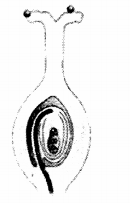
Answer:

Egg apparatus consists of two synergids and one egg cell.
Question 7.
Name the parts of pistil which develop into fruit and seeds.
Answer:
Fruit develops from ovary and seeds develop from ovules of a pistil.
Question 8.
In case of polyembryony, if an embryo develops from the synergid and another from the nucellus, which is haploid and which is diploid?
Answer:
In case of polyembryony, if an embryo develops from synergid, it will be haploid and if it develops from nucellus, it will be diploid.
Question 9.
Can an unfertilised, apomictic embryo sac give rise to a diploid embryo? If yes, then how?
Answer:
Apomictic embryo sac develops without the involvement of meiosis and syngamy. Here, a diploid embryo is formed from diploid egg cell or from some other diploid cell of embryo sac.
Question 10.
Which are the three cells found in a pollen grain when it is shed at the three celled stage?
Answer:
The three cells found in a pollen grain when it is shed at the three celled stage are two male gametes and one vegetative cell.
Question 11.
What is self-incompatibility?
Answer:
If a pistil carrying functional female gametes fails to set seeds following pollination with viable and fertile pollen, capable of bringing about fertilisation in another pistil, the two are said to be incompatible, and the phenomenon is known as sexual incompatibility. Sexual incompatibility may be interspecific (between individuals of different species) or intraspecific (between individuals of the same species). The latter is also called self-incompatibility.
Question 12.
Name the type of pollination in self incompatible plants.
Answer:
Self incompatible plants do not undergo self pollination. They can undergo only cross pollination.
Question 13.
Draw the diagram of a mature embryo sac and show its 8-nudeate, 7-celled nature. Show the following parts: antipodals, synergids, egg, central cell, polar nuclei.
Answer:
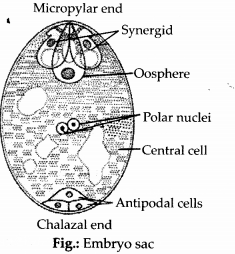
Question 14.
Which is the triploid tissue in a fertilised ovule? How is the triploid condition achieved?
Answer:
Endosperm is the triploid tissue in a fertilised ovule which is formed by the division of Primary Endosperm Nucleus (PEN). PEN is formed by the fusion of one male gamete (haploid) with secondary nucleus (diploid) hence, it is triploid.
Question 15.
Are pollination and fertilisation necessary in apomixis? Give reasons.
Answer:
In apomixis, there is no need of pollination and fertilisation. Embryo can develop directly from the nucellus or synergid or egg cell.
Question 16.
Identify the type of carpel with the help of diagrams given below:
Answer:
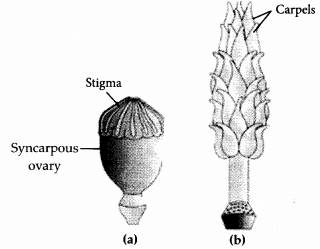
(a) Polycarpellary syncarpous
(b) Polycarpellary apocarpous
Question 17.
How is, pollination carried out in water plants?
Answer:
Plants which occur below the water level undergo epihydrophily or hypohydrophily,i.e pollination takes place by the agency of water. Aquatic plants which are emerged or present at the water surface can undergo entomophily, anemophily or epihydrophily.
Question 18.
What is the function of the two male gametes produced by each pollen grain in angiosperms?
Answer:
The function of the two male gametes produced by each pollen grain in angiosperms are as follows:
Short Answer Type Questions
Question 1.
List three strategies that a bisexual chasmogamous.flower can evolve to prevent self pollination (autogamy).
Answer:
Strategies that a bisexual chasmogamous flower can evolve to prevent self pollination are as follows:
Question 2.
Given below are the events that are observed in an artificial hybridisation programme. Arrange them in the correct sequential order in which they are followed in the hybridisation programme.
(a) Re-bagging
(b) Selection of parents
(c) Bagging
(d) Dusting the pollen on stigma
(e) Emasculation
(f) Collection of pollen from male parent.
Answer:
(b) —> (e) —> (c) —> (f) —> (d) —> (a)
Question 3.
Vivipary automatically limits the number of offsprings in a litter. How?
Answer:
Viviparity is a form of reproduction in animals in which the development of embryos takes place within the mother’s/ female parent’s body. The embryo obtains its nourishment directly from mother via placenta or by other means and subsequently mother gives birth to the full term young one. It is common in most mammals. Viviparity limits the number of offspring in a litter due to the following reasons:
Question 4.
Does self incompatibility impose any restrictions on autogamy? Give reasons and suggest the method of pollination in such plants.
Answer:
Self incompatibility is the phenomenon in which self pollens fail to germinate on stigma of pistil. It is a gene physiological process which is controlled by single gene S. If pollen and pistil will have the S alleles in common, pollens will not be functional on that pistil. As self pollens will have common S alleles with pistil (of the same flower), self pollination (autogamy) cannot take place in self incompatible plants. Cross pollens on the other hand, will not have common S alleles with pistil and hence, cross pollination can easily take place in such plants.
Question 5.
In the given diagram, write the names of parts shown with lines.
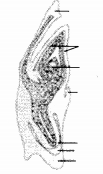
Answer:

Question 6.
What is polyembryony and how can it be commercially exploited?
Answer:
The phenomenon of having more than one embryo is called polyembryony, e.g., onion, groundnut.

Polyembryony is practically important because genetically uniform parental type seedlings are obtained from nucellar embryos. Nucellar embryos are superior to those obtained by vegetative propagation because nucellar embryo seedlings are disease free and maintain their superiority for long time.
Question 7.
Are parthenocarpy and apomixis different phenomena? Discuss their benefits.
Answer:
Parthenocarpy is production and development of seedless fruits. Apomixis is a type of sexual reproduction which does not involve meiosis and syngamy and produces seeds without fertilisation.
Benefits of parthenocarpy are as follows:
(1) It produces fruits which do not contain irritant seeds.
(2) Processing of fruits by food industry requires the removal of seeds which is quite difficult. Therefore, seedless fruits are preferred by food industry.
(3) Fruits can be developed inside green houses where pollinators are not available.
Benefits of apomixis are as follows:
Question 8.
Why does the zygote begin to divide only after the division of primary endosperm cell (PEC)?
Answer:
Endosperm development precedes embryo development. The primary endo¬sperm cell divides repeatedly and forms the triploid endosperm tissue. The cells of this tissue are filled with reserve food materials and are used for the nutrition of the developing embryo at the micropylar end of the embryo sac. This is an adaptation to provide assured nutrition to the developing embryo.
Question 9.
The generative cell of a two-celled pollen divides in the pollen tube but not in a three- celled pollen. Give reasons.
Answer:
In some plants pollen grains are shed at 2 celled stage whereas in others pollen grains are shed at 3 celled stage. The pollens which are shed at 2 celled stage contain vegetative cell and a generative cell. At the time of pollen germination, generative cell divides to form two male gametes in the pollen tube.
On the other hand, in case of pollens which are shed at 3 celled stage, the generative cell has already divided to form two male gametes before pollination or pollen germination, i.e., formation of pollen tube.
Question 10.
In the ,figure given below, label the following parts: .
Male gametes, egg cell, polar nuclei, synergid and pollen tube.
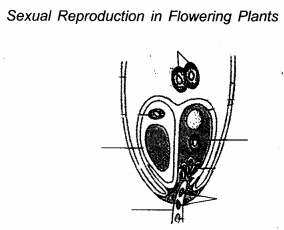
Answer:
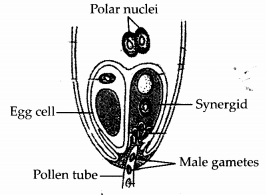
Long Answer Type Questions
Question 1.
Starting with the zygote, draw the diagrams of the different stages of embryo development in a dicot.
Answer:
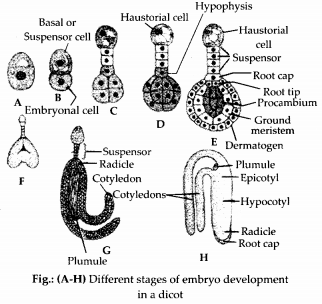
Question 2.
What are the possible types of pollinations in chasmogamous flowers. Give reasons.
Answer:
Chasmogamous flowers are the flowers with stamens and stigma exposed .They may undergo self pollination or cross pollination.
(1) Self pollination in chasmogamous flowers : Bisexual flowers where stigma and the stamens both mature almost at the same time can undergo autogamy or geitonogamy.
(2) Cross pollination in chasmogamous flowers : Transfer of pollen grains from anther of a flower to the stigma of different flower growing on different plant of same species. Cross pollination is carried by various abiotic agents like wind and water or by biotic agents like insects, birds and animals etc.
Question 3.
With a neat, labelled diagram, describe the parts of a mature angiosperm embryo sac. Mention the role of synergids.
Answer:
Neat and labelled diagram of mature angiospermic embryo sac is as follows :

Ovule is an integumented megasporangium that encloses an embryo sac. Common type of ovule is anatropous. Parts of mature angiospermic ovule are:
(1) Funicle : It is the stalk of the ovule. It is attached to placenta by funicle. In anatropous ovules the funicle is fused with the body of the ovule lengthwise to form raphe. Place of union of funicle and the body of ovule is called hilum.
(2) Integuments : They are one or two cuticularised coverings of the ovule. The place of origin of integuments is called chalaza. A pore’occurring on one side of ovule where integuments are absent is known as micropyle.
(3) Nucellus : It is parenchymatous tissue contained in the ovule.
(4) Embryo sac : It is female gametophyte which is covered by a thin membrane. Embryo sac has seven cells. Three cells form egg apparatus towards micropylar end. There are two synergids and one egg or oosphere in the egg apparatus. Three cells on the opposite side are called antipodal cells. The seventh cell of the embryo sac is the largest cell called central cell. Central cell has two polar nuclei which may fuse to form a diploid secondary nucleus. Synergids are shortlived (one of them degenerates long before fertilisation and second after entry of pollen tube into embryo sac).
These synergids help :
Filiform apparatus in the form of finger like projections from cell wall is present in upper part of each synergid. The filiform apparatus is useful for the absorption and transportation of
materials from the nucellus to the embryo sac. Hook like structures help in easy penetration of pollen tube and liberation of male gamete from the pollen tube.
Question 4.
Draw the diagram of a microsporangium and label its wall layers. Write briefly on the role of the endothecium.
Answer:
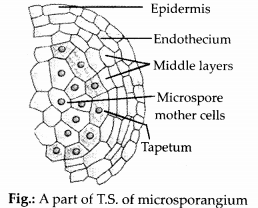
Question 5.
Endothecium protects the sporogenous tissue and helps in dehiscence of pollen grains.
Embryo sacs of some apomictic species appear normal but contain diploid cells. Suggest a suitable explanation for the condition.
Answer:
Embryo sacs of some apomictic species appear normal but contain diploid cells, because embryo sacs either develop from diploid nucellar cells or from diploid megaspore mother cells without undergoing meiosis. It leads to formation of apomictic diploid embryos.
We hope the NCERT Exemplar Solutions for Class 12 Biology chapter 2 Sexual Reproduction,in Flowering Plants help you. If you have any query regarding NCERT Exemplar Solutions for Class 12 Biology chapter 2 Sexual Reproduction,in Flowering Plants, drop a comment below and we will get back to you at the earliest.
These Solutions are part of NCERT Exemplar Solutions for Class 12 Biology. Here we have given NCERT Exemplar Solutions for Class 12 Biology chapter 9 Strategies for Enhancement in Food Production
Multiple Choice Questions
Question 1.
The chances of contracting bird flu from a properly cooked (above 100°C) chicken and egg are
(a) very high
(b) high
(c) moderate
(d) none.
Answer:
(d)
Question 2.
A group of animals which are related by descentand share many similarities are referred to as
(a) breed
(b) race
(c) variety
(d) species.
Answer:
(a)
Question 3.
Inbreeding is carried out in animal husbandry because it
(a) increases vigour
(b) improves the breed
(c) increases heterozygosity
(d) increases homozygosity.
Answer:
(d) : Breeding of animals of the same breed for 4-6 generations is called inbreeding. Thus, inbreeding is necessary if we want to develop a pureline. Inbreeding, as a rule, increases homozygosity.
Question 4.
Sonalika and Kalyan Sona are varieties of
(a) wheat
(b) rice
(c) millet
(d) tobacco.
Answer:
(a) Sonalika and Kalyan Sona are high yielding and disease resistant varieties of wheat.
Question 5.
Which one of the following is not a fungal disease?
(a) Rust of wheat
(b) Smutofbajra
(c) Black rot of crucifers
(d) Red rot of sugarcane
Answer:
(c) : The pathogen responsible for black rot of crucifer is a bacterium Xanthomonas campestris. It lives on the plant residue in the soil or in the seed. The bacterium enters leaves through the hydathodes. Bacteria may also enter leaves through wounds including those made by insects. First sign of the disease appears near the leaf margin, characterised by chlorosis, which progresses towards the center of leaf blade. In the affected portions, the vein and veinlets turn brown and finally black.
Question 6.
In virus-infected plants the meristematic tissues in both apical and axillary buds are free of virus because
(a) the dividing cells are virus resistant
(b) meristems have anti viral compounds
(c) the cell division of meristems are faster than the rate of viral multiplication
(d) viruses cannot multiply within meristem cell(s).
Answer:
(c)
Question 7.
Several South Indian states raise 2-3 crops of rice annually. The agronomic feature that makes this possible is because of
(a) shorter rice plant
(b) better irrigation facilities
(c) early yielding rice variety
(d) disease resistant rice variety.
Answer:
(c)
Question 8.
Which one of the following combination would a sugarcane farmer look for in the sugarcane crop?
(a) Thick stem, long internodes, high sugar content and disease resistant.
(b) Thick stem, high sugar content and profuse flowering.
(c) Thick stem, short internodes, high sugar content, disease resistant.
(d) Thick stem, low sugar content, disease resistant.
Answer:
(a)
Question 9.
Fungicides and antibiotics are chemicals that
(a) enhance yield and disease resistance
(b) kill pathogenic fungi and bacteria, respectively
(c) kill all pathogenic microbes
(d) kill pathogenic bacteria and fungi respectively.
Answer:
(b)
Question 10.
Use of certain chemicals and radiation to change the base sequences of genes of crop plants is termed
(a) recombinant DNA technology
(b) transgenic mechanism
(c) mutation breeding
(d) gene therapy.
Answer:
(c) : Mutation is the process by which genetic variations are created through changes in the base sequence within genes resulting in the creation of a new character or trait not found in the parental type. It is possible to induce mutations artificially
through use of chemicals or radiations (like gamma radiations), and selecting and using the plants that have desirable characters as a source in breeding. This process is called mutation breeding.
Question 11.
The scientific process by which crop plants are enriched with certain desirable nutrients is called
(a) crop protection
(b) breeding
(c) biofortification
(d) bioremediation.
Answer:
(c) : Breeding of crops with higher levels of vitamins and minerals or higher protein and healthier fats is called biofortification. This is the most practical aspect to improve nutritional value of food.
Question 12.
The term ‘totipotency’ refers to the capacity of a
(a) cell to generate whole plant
(b) bud to generate whole plant
(c) seed to germinate
(d) cell to enlarge in size.
Answer:
(a) : The capacity to generate a whole plant from any cell/explant is called cellular totipotency. Infact, a whole plant can be regenerated from any plant part (referred to as explant) or cell.
Question 13.
Given below are a few statements regarding somatic hybridisation. Choose the correct statements.
(i) Protoplasts of different cells of the same plant are fused.
(ii) Protoplasts from cells of different species can be fused.
(iii) Treatment of cells with cellulase and pectinase is mandatory.
(iv) The hybrid protoplast contains characters of only one parental protoplast.
(a) (i) and (iii)
(b) (i)and(ii)
(c) (i)and(iv)
(d) (ii) and (iii)
Answer:
(d) :When a hybrid is produced by fusion of somatic cells of two varieties or species, it is known as somatic hybrid. The process of producing somatic hybrids is called somatic hybridisation. First, the cell wall of the plant cells are removed by digestion with a combination of pectinase and cellulase. The plant cells without cell wall are called protoplasts. The fusion of protoplasts not only involves the fusion of their cytoplasm. but also their nuclei. The fused protoplasts are allowed to grow on culture medium. Soon they develop their own walls and are called somatic hybrid cells. The hybrid cells give rise to callus. Callus later differentiates into new plant with characters of two plants in one.
Question 14.
An explant is
(a) dead plant
(b) part of the plant
(c) part of the plant used in tissue culture
(d) part of the plant that expresses a specific gene.
Answer:
(c) : An explant is the plant part taken out to be grown in test-tube in special nutrient medium. It has the ability to produce whole new plant.
Question 15.
The biggest constraint of plant breeding is
(a) availability of desirable gene in the crop and its wild relatives
(b) infrastructure
(c) trained manpower
(d) transfer of genes from unrelated sources.
Answer:
(a ) : Conventional plant breeding results in hybrid varieties which had a tremendous impact on agricultural productivity over the last decades. Conventional plant breeding also has its limitations. First, breeding can only be done between two plants that are sexually compatible with each other. This limits the new traits that can be added to those that already exist in a particular species. Second, when plants are crossed, many traits that have undesirable effects on yield potential are transferred along with the trait of interest.
Question 16.
Lysine and tryptophan are
(a) proteins
(b) non-essential amino acids
(c) essential amino acids
(d) aromatic amino acids.
Answer:
(c)
Question 17.
Micropropagation is
(a) propagation of microbes in vitro
(b) propagation of plants in vitro
(c) propagation of cells in vitro
(d) growing plants on smaller scale.
Answer:
(b) : Micropropagation is the in vitro propagation of plants by rapidly multiplying stock plant material to produce a large number of progeny plants (clone), using modern plant tissue culture methods.
Question 18.
Protoplast is
(a) another name for protoplasm
(b) an animal cell
(c) a plant cell without a cell wall
(d) a plant cell.
Answer:
(c) : Refer Answer 13.
Question 19.
To isolate protoplast, one needs
(a) pectinase
(b) cellulase
(c) both pectinase and cellulase
(d) chitinase.
Answer:
(c) : Refer Answer 13.
Question 20.
Which one of the following is a marine fish?
(a) Rohu
(b) Hilsa
(c) Catla
(d) Common carp.
Answer:
(b) : Rohu, Catla and common carp are freshwater fish.
Question 21.
Which one of the following products of apiculture is used in cosmetics and polishes?
(a) Honey
(b) Oil
(c) Wax
(d) Royal jelly
Answer:
(c) : Abdominal glands of worker bees produce a secretion from which bee wax is made. It is used in the manufacture of many items like cosmetics, shaving cream, face cream, plaster, pencils, electric goods, toothpaste, lotions, furniture-polishes, boot- polishes, protective coating, ink paints and candles.
Question 22.
More than 70 per cent of livestock population is in
(a) Denmark
(b) India
(c) China
(d) India and China
Answer:
(d)
Question 23.
The agriculture sector of India employs about
(a) 50 per cent of the population
(b) 70 per cent of the population
(c) 30 per cent of the population
(d) 60 per cent of the population.
Answer:
(d) : India is an agricultural country. Agriculture accounts for approximately 33% of India’s GDP and employs nearly 62% of the population.
Question 24.
33 percent of India’s (Gross Domestic Product) comes from
(a) industry
(b) agriculture
(c) export
(d) small-scale cottage industries.
Answer:
(b) : Refer answer 23.
Question 25.
A collection of all the alleles of all the genes of a crop plant is called
(a) germplasm collection
(b) protoplasm collection
(c) herbarium
(d) somaclonal collection.
Answer:
(a) : The entire collection of plants/ seeds having all the diverse alleles for all the genes in a given crop is called germplasm collection.
Very Short Answer Type Questions
Question 1.
Millions of chicken were killed in West Bengal, Assam, Orissa and Maharashtra recently. What was the reason?
Answer:
Reason for killing of millions of chickens in West Bengal, Assam, Orissa and Maharashtra was spreading of bird flu caused by H5N1 strain of bird flu virus. This bird flu was spreading like an epidemic. Evidences showed that disease could affect many animals like cats, dogs, pigs, white tigers and also human beings.
Question 2.
Can gamma rays used for crop improvement programmes prove to be harmful for health? Discuss.
Answer:
Gamma rays are physical mutagens used to induce changes in DNA and chromosomes. ^ These are frequently employed in mutation breeding. Plants obtained by mutation breeding are high yielding and disease resistant. Useful plants with desirable mutations are selected for further breeding programmes. It has been found that such plants do not produce any harmful effect on health.
Question 3.
In animal husbandry, if two closely related animals are mated for a few generations, it results in loss of fertility and vigour. Why is this so?
Answer:
Inbreeding is the crossing of closely related animals of the same breed for 4-6 generations. Continuous inbreeding leads to
homozygosity. The recessive alleles tend to get together and express harmful effects in the progeny. Resulting in reduced survival and fertility of offspring known as inbreeding depression.
Question 4.
In the area of plant breeding, it is important not only to preserve the seeds of the variety being cultivated, but also to preserve all its wild relatives. Explain with a suitable example.
Answer:
Collection and preservation of all the different wild varieties, species and relatives of the cultivated species in plant breeding is essential for effective exploitation of natural genes a vai lable in the population. For example, in sugarcane (Saccharum officinarum) the character for disease resistance has been incorporated by breeding it with wild variety (Saccharum spontaneum).
Question 5.
Name a man-made cereal. Trace how it was developed and where is it used?
Answer:
Triticalc (6n) is a man-made cereal. It is a hexaploid variety developed by crossing wheat and rye followed by doubling of chromosomes. Triticale is the first man made crop.
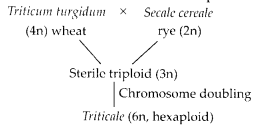
Question 6.
Fill in the blanks.
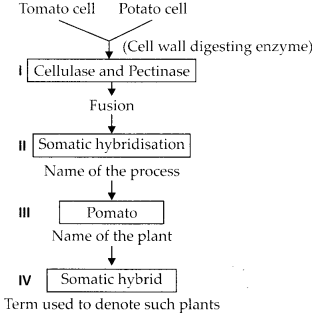
Answer:
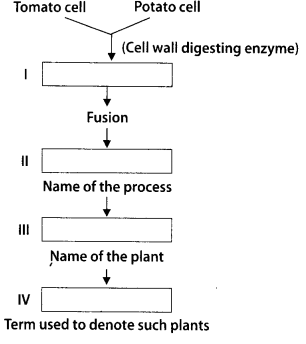
Question 7.
A few statements are given below followed by a set of terms in a box. Pick the correct term and write it against the appropriate statement.
(a) Mating of closely related individuals within the same breed.
(b) Mating of animals of same breed but having no common ancestors on either side for 4-6 generations.
(c) Mating of animals of two different species.
(d) Breeding of animals belonging to different breeds.
(i) Cross breeding,
(ii) Inter-specific hybridisation,
(iii) Outbreeding,
(iv) Outcrossing,
(v) Inbreeding.
Answer:
(a) – (v), (b) – (iv), (c) – (ii), (d) – (i)
Question 8.
What is meant by ‘hidden hunger’?
Answer:
Hidden hunger is consumption of food deficient in nutrients, particularly, in micronutrients, proteins and vitamins.
Question 9.
Why are plants obtained by protoplast culture called somatic hybrids?
Answer:
In protoplast culture, plants are obtained by fusion of somatic cells of two varieties, therefore, they are called somatic hybrids.
Question 10.
What is protoplast fusion?
Answer:
The plant cells without cell wall are called protoplasts. Protoplast fusion is the fusion of protoplasts of two plant cells by means of electro fusion or chemicals.
Question 11.
Why is it easier to culture meristems compared to permanent tissues?
Answer:
It is easier to culture meristems compared to permanent tissues because meristem is group of actively dividing and undifferentiated cells while cells of permanent tissues lose their ability to divide and have to dedifferentiate to resume their ability to divide.
Question 12.
Why are proteins synthesised from Spirulina called single cell proteins?
Answer:
Proteins synthesised from Spirulina are called single cell proteins (SCPs) because they are obtained from unicellular microorganism. The term is a misnomer as in SCP production, the biomass is produced from both unicellular and multicellular microorganisms, viz. bacteria, algae, fungi, etc.
Question 13.
A person who is allergic to pulses was advised to take a capsule of Spirulina daily? Give the reasons for the advice.
Answer:
Both Spirulina and pulses are rich sources of proteins. But if an individual is allergic to pulses, then he can take Spirulina capsule to fulfill the daily requirement of protein intake.
Question 14.
What is aquaculture? Give example of an animal that can be multiplied by aquaculture.
Answer:
Aquaculture is rearing and management of useful aquatic organisms such as aquatic plants and animals like fish, prawns, oysters etc., in both freshwater and saltwater under controlled conditions.
Question 15.
What are the duties of a veterinary doctor in management of a poultry farm?
Answer:
Duties of a veterinary doctor in management of poultry farm includes :
Question 16.
Would it be wrong to call plants obtained through micropropagation as ‘clones’? Comment.
Answer:
No, it is not wrong to call plants obtained by micropropagation as clones because these plants will be genetically similar to each other and to the original plant.
Question 17.
How is a somatic hybrid different from a hybrid?
Answer:
A normal sexual hybrid is produced by fusion of ordinary gametes. The major limitation in creating a sexual hybrid is the sexual compatibility of two species. However, success in some cases can be achieved by hybrid-specific modifications used to achieve fusion of gametes, and to rescue, isolate and culture the developing embryo in vitro. Sexual hybrids are diploid and cytoplasmic contribution of fusing cells is unequal. Somatic hybrids result from the fusion of somatic cells instead of ordinary gametes. This technique requires specific handling of protoplasts and is totally dependent on tissue culture technique. Sexual compatibility is not at all, a barrier to this technique and it can be performed between sexually incompatible species. Somatic hybrids are generally tetraploid and cytoplasmic contribution of two fusing cells is equal to the hybrid.
Question 18.
What is emasculation? Why and when it is done?
Answer:
Emasculation is removal of anthers from a bisexual flower before its maturity. It is done during artificial hybridisation programme to avoid self-pollination.
Question 19.
Discuss the two main limitations of plant hybridisation programme.
R3JBW
The limitations of plant hybridisation programme are as follows:
Question 20.
Interspecific crosses are rare in nature and intergeneric crosses almost unknown. Why?
Answer:
In interspecific crosses, male and female animals of two different related species are mated. In some cases, the progeny may combine desirable features of both the parents, and may have considerable economic value, e.g., the mule. Intergeneric hybridisation is the crossing of two different animals/plants of different genera. Both interspecific and intergeneric crosses are rare in nature. Sexual incompatibility, reproductive isolation and sterility are the main barriers in crossing between non-related species. For example, plants belonging to different species do not flower at the same time and often do not use the same pollinators. Intergeneric hybrids more or less never form complete zygotes/embryos. These are sterile/ infertile.
Question 21.
Differentiate between pisciculture and aquaculture.
Answer:
Pisciculture is rearing and management of fish in water bodies. Aquaculture involves rearing and management of useful aquatic plants and animals, such as fish, prawns, crabs, molluscs etc.
Question 22.
Give two important contributions of Dr. M.S. Swaminathan.
Answer:
Dr. M. S. Swaminathan is called father of “Green revolution” in India. His contributions are as follows:
Question 23.
The term ‘desirable trait’ can mean different thingsfor different plants. Justify the statement with suitable examples.
Answer:
Different plants have different desirable traits. This can be explained with example of rice. Certain rice areas in tropical Asia and Africa are subject to prolonged and deep flooding. In such areas, farmers grow floating rice with internodes that elongate when the wafer rises. These are not very good yielding varieties. Yet they are ‘desirable’ because internode elongation prevents them from getting submerged and dying. But in Latin America, where fields flood no deeper than 40 to 100 cm, that too for shorter periods, farmers prefer hybrids obtained by crossing deep water varieties with improved dwarfs which are superior, as they contain high yield combined with dwarfism.
Short Answer Type Questions
Question 1.
You are planning to set up a Dairy Farm. Describe the various aspects you would consider before you start the venture.
Answer:
Various aspects to be considered while setting up a dairy farm include:
Question 2.
It is said, that diseases are spreading faster due to globalisation and increased movement of people. Justify the statement taking the example of H5N1 virus.
Answer:
bird flu virus affects the poultry birds and can turn into an epidemic. This disease can be transmitted to other animals like cats, dogs, white tigers or even human beings. It can also be transferred from one human being to another. Due to globalisation and increased movementof people, the disease spreads rapidly from one country to another. The spreading of disease also increases when affected products are imported from one country to another.
Question 3.
Explain the concept of the ‘Blue Revolution’.
Answer:
The term ‘Blue Revolution’ refers to the remarkable emergence of aquaculture as an important and highly productive activity. Aquaculture refers to all forms of active culturing of aquatic animals and plants occurring in fresh water, marine or brackish forms.
In India, it was started in 1970. ‘Blue Revolution’ has brought improvement in aquaculture by adopting new techniques of breeding, rearing, marketing and export of fish. It lead to tremendous increase in shrimp production.
Question 4.
A farmer was facing the problem of low yield from his farm. He was advised to keep a beehive in the vicinity. Why? How would the beehive help in enhancing yield?
Answer:
Bees are pollinators of many crop species such as sunflower, Brassica, apple and pear. Honey bees feed on pollen and nectar of flowers. Keeping beehive in crop fields during flowering period increases pollination efficiency and improves the yield (both crop and honey).
Question 5.
Lifestyle diseases are increasing alarmingly in India. We are also dealing with large scale malnutrition in the population, is there any method by which we can address both of these problems together?
Answer:
Increase in lifestyle diseases and malnutrition, both can be checked by biofortification. It is a technique to produce crops with high nutritional value with higher levels of vitamins, minerals, proteins and healthier fats.
A few examples of crop with improved food quality are :
Question 6.
How can we improve the success rate of fertilisation during artificial insemination in animal husbandry programmes?
Answer:
Multiple Ovulation Embryo Transfer Technology (MOET) is used to improve the
success rate of fertilisation during artificial insemination. In this method, hormones (with FSH-like activity) are given to the cow for inducing follicular maturation and super ovulation i.e., instead of one egg, which they usually give per cycle, they produce 6-8 eggs. The cow is either mated with a best bull or artificially inseminated. The embryos at 8-32 cell stages are recovered and transferred to surrogate mothers. The genetic mother is available for another super ovulation. MOET has been done in cattle, sheep, rabbits, buffaloes, mares etc. High milk giving breeds of females and high quality (lean meat with less lipid) meat giving bulls have been bred successfully to obtain better breed in a short time.
Question 7.
What is meant by germplasm collection? What are its benefits?
Answer:
Germplasm collection refers to collection of variability. It involves collection and preservation of all different wild varieties, species and relatives of the cultivated species. It is sum total of all the alleles of the genes present in a crop. Germplasm collection is essential for successful breeding programme as it offers, to the breeders, the entire of genes and alleles and their characteristics which a plant expresses. The breeder is exposed to the best options and he can select the most favourable traits of a particular gene.
Question 8.
Name the improved characteristics of wheat that helped India to achieve green revolution.
Answer:
The term ‘Green Revolution’ refers to increase in crop yield due to development of high yielding varieties of crop plants like wheat and rice through plant breeding technique. Sonalika and Kalyan Sona are improved wheat varieties introduced in India for ‘Green Revolution’.
They show following characteristics:
Question 9.
Suggest some of the features of plants that will prevent insect and pest infestation.
Answer:
Insect resistance in plants may be produced by morphological, biochemical or physiological features.
These are discussed as follows:
Question 10.
It is easier to culture plant cells in vitro as compared to animal cells. Why?
Answer:
Plant cells are easier to culture in vitro because they have the property of cellular totipotency, i.e., capacity to generate whole plant from any cell. But in case of animals, whole new organism cannot be produced from single cell.
Question 11.
The culture medium (nutrient medium) can be referred to as a highly enriched laboratory soil’. Justify the statement.
Answer:
The plant tissue culture medium is referred to as highly enriched laboratory soil as it consists of both micro- and macro¬elements, vitamins, carbon source, amino acids and growth regulators required for the growth of explants.
Question 12.
Is there any relationship between dedifferen-tiation and the higher degree of success achieved in plant tissue culture experiments?
Answer:
In plants, living, differentiated cells, those who have lost the capacity to divide can regain the capacity of division under certain conditions. This is called dedifferentiation. Dedifferentiated cells undergo callus formation and callus gets differentiated to form plantlets.
Question 13.
“Give me a living cell of any plant and I will give you a thousand plants of the same type” Is this only a slogan or is it scientifically possible? Write your comments and justify them.
Answer:
Living cells of plants have property of totipotency, i.e., ability to form whole new plant jfrom any cell. Large number of plants can be produced from single cell by technique called micropropagation. In this method of tissues culture, each plant produced is genetically similar to parent plant.
Question 14.
What is the difference between a breed and a species. Give an example for each category.
Answer:
A ‘breed’ is a specific group of animals which share many similarities such as homogenous appearance, behaviour etc., that distinguish it from other animals or plants of the same species. Sahiwal is an indigenous breed, Jersey, Brown Swiss are exotic breeds of cattle (Bos indica).
A ‘species’ is the largest group of individuals capable of freely interbreeding among themselves and producing fertile offspring, e.g., all cows of the whole world have only one scientific name Bos indica.
Question 15.
Plants raised through tissue cultures are clones of the ‘parent’ plant. Discuss the utility of these plants.
Answer:
The plants obtained through tissue culture are genetically identical to parent plants. This is of great use when desirable characters of the parent plant have to be maintained. Hence, plant raised through tissue culture technique are of great use.
Question 16.
Discuss the importance of testing of new plant varieties in a geographically vast country like India.
Answer:
India is a vast country with varying climatic conditions. Different hybrid varieties after growing in research fields are evaluated by growing in farmer’s field, at least for three growing seasons at several locations in the country representing all agroclimatic zones. The hybrid is evaluated for various characters like disease resistance, tolerance, yield in comparison to the best available local crop cultivar. Testing of new plant varieties before release is of great importance as it ensures that the plant varieties can grow in vivid environmental conditions present in different geographical regions of our country.
Question 17.
Define the term ‘stress’ for plants. Discuss briefly the two types of stress encountered by plants.
Answer:
External factors which reduce the growth and yield of plants are known as stress. These external factors may be abiotic or biotic. Two common types of stress encountered by plants are:
Question 18.
Discuss natural selection and artificial selection. What are the implications of the latter on the process of evolution?
Answer:
Selection is the process by which certain individuals with desired characters and considered to be fit are favoured. Natural selection involves selection of adapted individuals by nature. It is a continuous process and has resulted in evolution. Evolution that takes place in natural selection is a slow’ process.
In artificial selection, parent organism with desirable characters, such as high yield, disease resistance, increased tolerance etc., is selected by humans and is hybridised with superior variety to produce hybrid.
Artificial selection provides a model that helps us understand natural selection. It is a small step to envision natural conditions acting selectively on populations and causing natural changes. Artificial selection allows rapid changes in a species. This is because man has one power which nature does not have – man ensures breeding that preserves only beneficial traits of species. Hence, evolution through artificial selection is much faster as compared to evolution through natural selection.
Question 19.
Discuss briefly how purelines are created in animal husbandry.
Answer:
When breeding is between animals of the same breed, it is called inbreeding. In animal husbandry, purelines are produced by inbreeding of animals for 4-6 generations.
Question 20.
What are the physical barriers of a cell in the protoplast fusion experiment? How are the barriers overcome?
Answer:
Physical barriers in protoplast fusion involve presence of protective cell wall in plant cells and then fusion of protoplasm. Cell wall is digested by cellulase and pectinase and then protoplasts of two cells are fused in a solution of polyethylene glycol (PEG) or by high voltage pulse, known as electrofusion.
Question 21.
Give few examples of biofortified crops. What benefits do they offer to the society?
Answer:
SPinn Examples of biofortified crops are :
Long Answer Type Questions
Question 1.
You are a botanist working in the area of plant breeding. Describe the various steps that you will undertake to release a new variety.
Answer:
The steps required for developing new varieties are as follows:
(1) Collection of germplasm : Collection and preservation of all the different wild varieties, species and relatives of the cultivated species is a pre-requisite for effective exploitation of natural genes available in the population. Germplasm is the sum total of all the alleles of the genes present in a crop and its related species.
(2) Evaluation and selection of parents : The germplasm is evaluated to identify plants with desirable combination of characaters. Seeds of plants having desirable characters are selected for multiplication.
(3) Cross-hybridisation among selected parents : Hybridisation is the most common method of creating genetic variation. Hybridisation is crossing of two or more types of plants for bringing their traits together in the progeny. It brings about useful genetic/heritable variations of two or more lines together.
(4) Selection and testing of superior recom-binants : This step comprises selecting among the progeny of the hybrids, i.e., those plants that have the desired character combination. The selection process yields plants that are superior to both of the parents. These plants are self-pollinated for several generations till they come to a state of uniformity (homozygosity).
(5) Testing, release and commercialisation of new cultivars : The newly selected lines are evaluated in comparison to best available local crop cultivar for their yield and other agronomic traits of quality, disease resistance etc. and then are released for commercialisation.
Question 2.
(a) The shift from grain to meat diets creates more demands for cereals. Why?
(b) A 250 kg cow produces 200 g of protein per day but 250 g of Methylophillus methylotrophus can produce 25 tonnes of protein. Name this emerging area of research. Explain its benefits.
Answer:
(a) The shift from grain to meat diets creates more demands on cereals as it takes 3-10 kg of grain to produce 1 kg of meat by animal farming.
(b) The emerging research area discussed in the question refers to Commercial production of proteins from micro¬organisms, called single cell protein. Advantages of SCP are as follows:
Question 3.
What are the advantages of tissue culture methods over conventional method of plant breeding in crop improvement programmes?
Answer:
Advantages of tissue culture method over conventional methods of breeding are :
Question 4.
Modem methods of breeding animals and plants can alleviate the global food shortage’. Comment on the statement and give suitable examples.
Answer:
The population of the world is increasing day by day. To meet the food requirements of the ever increasing population, is the major concern of plant and animal breeders. Modern biological principles are applied to animal husbandry and plant breeding to enhance food production.
Modem methods in animal breeding include Multiple Ovulation Embryo Transfer Technology (MOET). In this method, hormones (with FSH-like activity) are given to the cow for inducing follicular maturation and super ovulation i.e., instead of one egg, which they usually give per cycle, they produce 6-8 eggs. The cow is either mated with a best bull or artificially inseminated. The embryos at 8-32 cell stage are recovered and transferred to surrogate mothers. The genetic mother is available for another super ovulation. MOET has been done in cattle, sheep, rabbits, buffaloes, mares, etc. High milk yielding breeds of females and high quality (lean meat with less lipid) meat-giving bulls have been bred successfully to obtain better breed in a short time.
Modern methods in plant breeding include the following:
Question 5.
Does apiculture offer multiple advantages to farmers? List its advantages if it is located near a place of commercial flower cultivation.
Answer:
Advantages of apiculture to farmers are:
Question 6.
(a) Mutations are beneficial for plant breeding.Taking an example, justify the statement,
(b) Discuss briefly the technology that made us self-sufficient in food production.
Answer:
(a) Mutation is the process by which genetic variations are created through changes in the base sequence within genes resulting in the creation of a new character or trait. It is possible to induce mutations artificially in plants through use of chemicals or radiations and then selecting and using those plants that have the desirable characters or traits as a source in breeding. This process is called mutation breeding.
Some important achievements of mutation breeding are:
(b) After independence, efforts to make country self sufficient for food were not successful for two decades. It was a major task for agricultural scientists in India to produce sufficient food for increasing population with little land available. The positive results appeared only in the form of ‘Green Revolution’. Basic aims of Green Revolution were:
Question 7.
Discuss how the property of plant cell totipotency has been utilised for plant propagation and improvement.
Answer:
Totipotency is the ability of single cell to grow into complete new plant. Plant * cell totipotency can be utilised for plant propagation and improvement. Any part of a plant (explant) is taken out and is grown in test tube under sterile conditions in special nutrient medium. Plant hormones present in the culture medium play an important role in growth and differentation of cultured cells and tissues.”
By meristem culture, virus-free plants can be generated from an infected plant. Anther cells can be cultured in vitro to produce haploid plants. These are useful for immediate expression of mutations and quick formation of purelines. Young embryos can be cultured in vitro. Embryo culture is useful in case of orchids as orchid seeds do not have any form of stored food. Moreover in certain species, inhibitors present in the endosperm or seed coat make the seed dormant. Such embryos can escape dormancy by culturing on suitable medium.
Question 8.
What are three options to increase food production? Discuss each giving the salient features, merits and demerits.
Answer:
Traditional farming can only yield a limited biomass as food for humans and animals. Better management practices and increase in agricultural land can increase yield, but only to a limited extent.
Following are the three options to increase food production:
(a) Single cell protein : The biomass obtained from microorganisms can be treated or processed in industry to be used as food and is called single cell protein.
Merits of single cell proteins:
Demerits of single cell proteins:
(b) Biofortification : It is the method for developing crops with higher levels of vitamins, minerals proteins and healthier fats to improve public health.
Merits of biofortification :
Demerits of biofortification :
(c) Tissue-culture :
It is an in vitro technique for regeneration of a whole plant from any part of a plant by growing it on culture medium under aseptic conditions.
Merits of tissue culture :
Demerits of tissue culture :
We hope the NCERT Exemplar Solutions for Class 12 Biology chapter 9 Strategies for Enhancement in Food Production help you. If you have any query regarding .NCERT Exemplar Solutions for Class 12 Biology chapter 9 Strategies for Enhancement in Food Production, drop a comment below and we will get back to you at the earliest.
These Solutions are part of NCERT Exemplar Solutions for Class 12 Biology. Here we have given NCERT Exemplar Solutions for Class 12 Biology chapter 1 Reproduction in Organisms
Multiple Choice Questions
Question 1.
A few statements describing certain features of reproduction are given below.
(i) Gametic fusion takes place.
(ii) Transfer of genetic material takes place.
(iii) Reduction division takes place.
(iv) Progeny have some resemblance with parents.
Select the options that are true for both asexual and sexual reproduction from the options given below.
(a) (i) and (ii)
(b) (ii) and (iii)
(c) (ii) and (iv)
(d) (i) and (iii)
Answer:
(c) : Reproduction is a biological process in which-an organism produces young ones (offspring) similar to itself. In reproduction, offsprings have some resemblance with parents. Both sexual and asexual reproduction involve transfer of genetic material.
Question 2.
The term ‘clone’ cannot be applied to offspring formed by sexual reproduction because
(a) offspring do not possess exact copies of parental DNA
(b) DNA of only one parent is copied and passed on to the offspring
(c) offspring are formed at different times
(d) DNA of parent and offspring are completely different.
Answer:
(a) : In sexual reproduction, there is fusion of male gametes and female gametes, the offspring produced are not identical to their parents. This genetic recombination leads to variations, which play an important role in evolution.
Question 3.
A sexual method of reproduction by binary fission is common to which of the following?
(i) Some eukaryotes
(ii) All eukaryotes
(iii) Some prokaryotes
(iv) All prokaryotes
(a) (i) and (ii)
(b) (ii) and (iii)
(c) (i) and (iii)
(d) (iii) and (iv)
Answer:
(c)
Question 4.
A few statements with regard to sexual reproduction are given below.
(i) Sexual reproduction does not always require two individuals.
(ii) Sexual reproduction generally involves gametic fusion.
(iii) Meiosis never occurs during sexual reproduction.
(iv) External fertilisation is a rule during sexual reproduction.
Choose the correct statements from the options below.
(a) (i) and (iii)
(b) (i) and (ii)
(c) (ii) and (iii)
(d) (i) and (iv)
Answer:
(b) : Meiosis is required for the production of haploid gametes during sexual reproduction. External fertilisation is not a rule during sexual reproduction, it can occur internally also.
Question 5.
A multicellular, filamentous alga exhibits a type of sexual life cycle in which the meiotic division occurs after the formation of zygote. The adult filament of this alga has
(a) haploid vegetative cells and diploid gametangia
(b) diploid vegetative cells and diploid gametangia
(c) diploid vegetative cells and haploid gametangia
(d) haploid vegetative cells and haploid gametangia.
Answer:
(d)
Question 6.
The male gametes of rice plant have 12 chromosomes in their nucleus. The chromosome number in the female gamete, zygote and the cells of the seedling will be, respectively
(a) 12,24,12
(b) 24,12,12
(c) 12,24,24
(d) 24,12,24.
Answer:
(c) : Chromosome number in male gamete of rice plant is n = 12 therefore chromosome number in female gamete would also be 12. Zygote is diploid as it is the product of fertilisation and the cells of the seedling would be meiocytes and other diploid cells. Hence, the chromosome number in both zygote and cells of seedling will be 2n = 24.
Question 7.
Given below are a few statements related to external fertilisation. Choose the correct statements.
(i) The male and female gametes are formed and released simultaneously.
(ii) Only a few gametes are released into the medium.
(iii) Water is the medium in a majority of organisms exhibiting external fertilisation.
(iv) Offspring formed as a result of external fertilisation have better chance of survival than those formed inside an organism.
(a) (iii) and (iv)
(b) (i) and (iii)
(c) (ii) and (iv)
(d) (i) and (iv)
Answer:
(b) : A large number of gametes are released into the medium to increase the chances of fertilisation. The chances of survival of offsprings from external fertilisation are lesser than those of internal fertilisation as they face more risk from predators.
Question 8.
The statements given below describe certain features that are observed in the pistil of flowers.
(i) Pistil may have many carpels.
(ii) Each carpel may have more than one ovule.
(iii) Each carpel has only one ovule.
(iv) Pistil have only one carpel.
Choose the statements that are true from the options below.
(a) (i) and (ii)
(b) (i) and (iii)
(c) (ii) and (iv)
(d) (iii) and (iv)
Answer:
(a) : Gynoecium is the female part of the flower, a unit of which is called pistil. A pistil may have one or more than one carpels (monocarpellary, bicarpellary etc). Each carpel may have more than one ovules.
Question 9.
Which of the following situations correctly describe the similarity between an angiosperm egg and a human egg?
(i) Eggs of both are formed only once in a lifetime.
(ii) Both the angiosperm egg and human egg are stationary.
(iii) Both the angiosperm egg and human egg are motile transported.
(iv) Syngamy in both results in the formation of zygote.
Choose the correct answer from the options given below.
(a) (ii) and (iv)
(b) (iv) only
(c) (iii) and (iv)
(d) (i) and (iv)
Answer:
(b) : Syngamy is the complete and permanent fusion of male and female gametes to form a zygote.
Question 10.
Appearance of vegetative propagules from the nodes of plants such as sugarcane and ginger is mainly because
(a) godes are shorter than internodes
(b) nodes have meristematic cells
(c) nodes are located near the soil
(d) nodes have non-photosynthetic cells.
Answer:
(b) : Vegetative propagation is asexual reproduction from ‘various parts in plants. In plants, such as, sugarcane and ginger, appearance of vegetative propagules from nodes is because of presence of meristematic cells in them. Meristematic cells have the ability to divide to form new cells which can differentiate and give rise to permanent tissues.
Question 11.
Which of the following statements, support the view that elaborate sexual reproductive process appeared much later in the organic evolution?
(i) Lower groups of organisms have simpler body design.
(ii) Asexual reproduction is common in lower groups.
(iii) Asexual reproduction is common in higher groups of organisms.
(iv) The high incidence of sexual reproduction in angiosperms and vertebrates.
Choose the correct answer from the options given below.
(a) (i), (ii) and (iii)
(b) (i), (iii) and (iv)
(c) (i), (ii) and (iv)
(d) (ii), (iii) and (iv)
Answer:
(c)
Question 12.
Offspring formed by sexual reproduction exhibit more variation than those formed by asexual reproduction because
(a) sexual reproduction is a lengthy process
(b) gametes of parents have qualitatively different genetic composition
(c) genetic material comes from parents of two different species.
(d) greater amount of DNA is involved in sexual reproduction.
Answer:
(b) : Sexual reproduction occurs in almost all types of animals and mostly in higher plants. It is usually biparental. Daughter organisms genetically differ from the parents. Since there are variations, so it contributes to evolution of the species.
Question 13.
Choose the correct statement from amongst the following.
(a) Dioecious organisms are seen only in animals.
(b) Dioecious organisms are seen only in plants.
(c) Dioecious organisms are seen in both plants and animals.
(d) Dioecious organisms are seen only in vertebrates.
Answer:
(c) : Dioecious organisms are those in which male and female sex organs are present in different organisms, where as monoecious organisms are those in which male and female sex organs are present in the same organism. Monoecious organisms are also called as hermaphrodite. Dioecious organisms are seen in both plants and animals. Papaya, date palm and most of the animals are dioecious.
Question 14.
There is no natural death in single celled organisms like Amoeba and bacteria because
(a) they cannot reproduce sexually
(b) they reproduce by binary fission
(c) parental body is distributed among the offspring
(d) they are microscopic.
Answer:
(c) : These are no natural death in single celled organisms like Amoeba and bacteria. It is so, because of asexual reproduction, the body of parent is divided into daughter cells. So, in effect, there is no practical death in Amoeba and bacteria.
Question 15.
There are various types of reproduction. The type of reproduction adopted by an organism depends on
(a) the habitat and morphology of the organism
(b) morphology of the organism
(c) morphology and physiology of the organism
(d) the organism’s habitat, physiology and genetic makeup.
Answer:
(d) : There are various types of reproduction, both asexual (fission, budding, etc.) and sexual (internal and external). The type of reproduction, an organism undergoes depends ultimately on its genetic makeup which influences its physiology. Habitat also influences the type of reproduction, that organism undergoes.
Question 16.
Identify the incorrect statement.
(a) In asexual reproduction, the offspring produced are morphologically and genetically identical to the parent.
(b) Zoospores are sexual reproductive structures.
(c) In asexual reproduction, a single parent produces offspring with or without the formation of gametes.
(d) Conidia are asexual structures in
Answer:
(b) : Spores formation is also a type of asexual reproduction. Zoospores, conidia, oidia, etc. are all asexually reproducing structures. There is generally no gamete formation in asexual reproduction and the offsprings produced are called clones.
Question 17.
Which of the following is a post-fertilisation event in flowering plants?
(a) Transfer of pollen grains
(b) Embryo development
(c) Formation of flower
(d) Formation of pollen grains
Answer:
(b) : Events in sexual reproduction after the fertilisation are called post-fertilisation events. After fertilisation, a diploid zygote is formed in all sexually reproducing organisms. The process of development of embryo from the zygote is called embryogenesis.
Question 18.
The number of chromosomes in the shoot tip cells of a maize plant is 20. The number of chromosomes in the microspore mother cells of the same plant shall be
(a) 20
(b) 10
(c) 40
(d) 15.
Answer:
(a) : Shoot tip cells and microspore mother cells both are diploid in maize plant. If number of chromosomes in shoot tip cell (2n) = 20, then number of chromosomes in microspore mother cell will be (2n) = 20.
Very Short Answer Type Questions
Question 1.
Mention two inherent characteristics of Amoeba and yeast that enable them to reproduce asexually.
Answer:
The two inherent characteristics for asexual reproduction in Amoeba and yeast are :
Question 2.
Why do we refer to offspring formed by asexual method of reproduction as clones?
Answer:
Offsprings produced by asexual reproduction are morphologically and genetically similar to their parents. Hence, they are known as clones.
Question 3.
Although potato tuber is an underground part, it is considered as a stem. Give two reasons.
Answer:
Reasons for considering potato as a stem are:
Question 4.
Between an annual and a perennial plant, which one has a shorter juvenile phase? Give one reason.
Answer:
Annual plant have shorter juvenile phase as they complete their life cycle in single season i.e., a few weeks to a few months, e.g., wheat, maize, pea, gram.
Question 5.
Rearrange the following events of sexual reproduction in the sequence in which they occur in a flowering plant : embryogenesis, fertilisation, gametogenesis, pollination.
Answer:
The correct sequence of events of sexual reproduction in flowering plants are as follows : gametogenesis, pollination, fertilisation, embryogenesis.
Question 6.
The probability of fruit set in a self-pollinated bisexual flower of a plant is far greater than a dioecious plant. Explain.
Answer:
Presence of male and female reproductive organs on same plant provides more chances of self pollination and therefore increases chances of fruit set. However in dioecious plants agents of pollination are needed which may therefore decrease the chances of a fruit set.
Question 7.
Is the presence of large number of chromosomes in an organism a hindrance to sexual reproduction? Justify your answer by giving suitable reasons.
Answer:
The presence of a large number of chromosomes in an organism is not a hindrance to sexual reproduction.
Question 8.
Is there a relationship between the size of an organism and its life span? Give two examples in support of your answer.
Answer:
There is no direct correlation between the life span of organisms and their sizes.
Question 9.
In the figure given below the plant bears two different types of flowers marked ‘A’ and ‘B’. Identify the types of flowers and state the type of pollination that will occur in them.
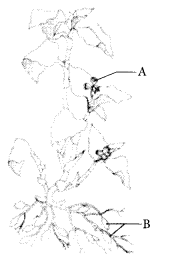
Answer:
The plant shown in figure has two types of flowers:
Flower A – chasmogamous type with stigma and anthers exposed. Such type of flowers may undergo self or cross pollination.
Flower B – Cleistogamous type – closed type of flowers, where stigma and anthers are not exposed. Such type of flowers undergo only self pollination.
Question 10.
Give reasons as to why cell division cannot be a type of reproduction in multicellular organisms.
Answer:
In multicellular organisms cell division does not divide the whole body into daughter cells as in unicellular organisms. But multicellular organisms have a well developed reproductive organs which help in reproduction.
Question 11.
In the figure given below, mark the ovule and pericarp.

Answer:
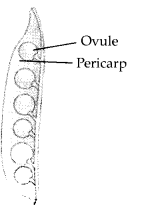
Question 12.
Why do gametes produced in large numbers in organisms exhibit external fertilisation?
Answer:
In external fertilisation, there are great chances that the sperm and the eggs released by the organisms can be affected by desiccation, predators, etc. So, to make up for the high fatality rate of the gametes, the organisms produces a lot of gametes.
Question 13.
Which of the followings are monoecious and dioecious organisms.
(a) Earthworm____________
(b) Chara ______________
(c) Marchantia____________
(d) Cockroach ___________
Answer:
(a) Earthworm – Monoecious animal
(b) Chara – Monoecious plant
(c) Marchantia- Dioecious plant
(d) Cockroach – Dioecious plant
Question 14.
Match the organisms given in Column ‘A’ with the vegetative propagules given in Column ‘B’
| Column A | Column B | ||
| i | Bryophyllum | a. | Offset |
| ii | Agave | b. | Eyes |
| iii. | Potato | c. | Leaf buds |
| iv. | Water hyacinth | d. | Bulbils |
Question 15.
What do the following parts of a flower develop into after fertilisation?
(a) Ovary__________
(b) Ovules__________
Answer:
(a) Ovary – fruit
(b) Ovules-seed
Short Answer Type Questions
Question 1.
In haploid organisms that undergo sexual reproduction, name the stage in the life cycle when meiosis Give reasons for your answer.
Answer:
In zygospore (formed by zygote) meiosis occurs. Because after meiosis it can form meiospores which can develop into haloid organisms.
Question 2.
The number of taxa exhibiting asexual reproduction is drastically reduced in higher plants (angiosperms) and higher animals (vertebrates) as compared with lower groups of plants and animals. Analyse the possible reasons for this situation.
Answer:
Both angiosperms and vertebrates have more complex structural organisation. They have evolved very efficient mechanism of sexual reproduction.
Question 3.
Honeybees produce their young ones only by sexual reproduction. Inspite of this, in a colony of bees we find both haploid and diploid individuals Name the haploid and diploid individuals in the colony and analyse the reasons behind their formation.
Answer:
Honeybees produce their young ones by sexual reproduction but parthenogenesis also occurs alongwith sexual reproduction. Fertilised eggs and parthenogenetically developed eggs give rise to different castes. In honey bees, fertilised eggs (zygotes) which is diploid give rise to queens and workers (both are females) and unfertilised eggs (ova) which is haploid develop into drones (males).
Question 4.
With which type of reproduction do we associate the reduction division? Analyse the reasons for it.
Answer:
We can associate the reduction division (meiosis) with sexual reproduction. Sexual reproduction is the process of development of new organisms through the formation and fusion of male and female gametes. It involves meiosis or reduction division i.e., halving the parental chromosomes inside the male and female gamete and their subsequent fusion resulting in the restoration of the original parental number of chromosomes, causing an increased genetic diversity.
Question 5.
Is it possibletoconsider vegetative propagation observed in certain plants like Bryophyllum, water hyacinth, ginger etc., as a type of asexual reproduction? Give two/ three reasons.
Answer:
Yes, it is possible to consider vegetative propagation as a type of asexual reproduction because of the following reasons:
Question 6.
Fertilisation is not an obligatory event for fruit production in certains plants’ Explain the statement.
Answer:
No, fertilisation is not an obligatory event for fruit production in certain plants, as fruits can also develop from unfertilised ovary also. Such fruits are called parthenocarpic fruits. The formation of this type of fruit takes place without prior’fertilisation of the flower by pollen. The resulting fruits are seedless and therefore do not contribute to the reproduction of the plant, examples are bananas and pineapples. Plant growth substances may have a role in this phenomenon, which can be induced by auxins in the commercial production of tomatoes and other fruits.
Question 7.
In a developing embryo, analyse the consequences if cell divisions are not followed by cell differentiation.
Answer:
Cell division increase the number of cells in the developing embryo while cell differentiation helps the groups of cells to undergo certain modifications and form specialised tissues and organs.
Initially all the cells of the developing embryo are alike with same genetic information. Later however, due to the phenomenon of differentiation depending on their location and internal cellular mechanism, different cells of the embryo develop differently forming embryonal axis, plumule and radicle. However, if cell differentiation does not occur the embryo will remain just a mass of undifferentiated cells or callus. There would not any plumule, radicle, cotyledons or embryo axis. A new plant will not be formed from such an embryo.
Question 8.
List the changes observed in an angiosperm flower subsequent to pollination and fertilisation.
Answer:
In an angiosperm flower, the changes that occur subsequent to pollination and fertilisation are called post-fertilisation changes. Pollen grain germinates over the stigma and forms a pollen tube carrying two gametes. Pollen tube reaches ovary and enters an ovule through one of its synergids. Fertilisation produces a diploid zygote and triploid primary endosperm cell. Zygote produces embryo and primary endosperm cell forms endosperm. Transformation takes place and ovule transforms into seed, ovary transforms into fruit and ovary wall into pericarp. The petals, stamens and style wither away.
Question 9.
Suggest a possible explanation why the seeds in a pea pod are arranged in a row, whereas those in tomato are scattered in the juicy pulp.
Answer:
Arrangement of seeds inside a fruit depends upon the type of placentation and the growth of placental axis. In pea ovary, the ovules are attached to the ventral suture i.e., marginal placentation and carpel is mono- carpellary. So, seeds are arranged in a row. In tomatoes, the gynoecium is tricarpellary with axile placentation. The placentae grow and become pulpy during fruit formation. As a result seeds get scattered in the pulpy mass in tomato.
Question 10.
Draw the sketches of a zoospore and a conidium. Mention two dissimilarties between them and atleast one feature common to both structures.
Answer:

Dissimilarities : Zoospores are motile and flagellated whereas conidia are nonmotile. Zoospore are formed inside a zoosporangium and conidia are formed (exogenously) outside on a conidiophore.
Similarity : Both are reproductive structures for asexual reproduction.
Question 11.
Justify the statement’Vegetative reproduction is also a type of asexual reproduction’.
Answer:
Refer answer 5.
Long Answer Type Questions
Question 1.
Enumerate the differences between asexual and sexual reproduction. Describe the types of asexual reproduction exhibited by unicellular organisms.
Answer:
| A sexual reproduction | Sexual reproduction |
| (1) Asexual reproduction involves the participation of single individual parent. | Sexual reproduction involves participation of two separate parents. |
| (2) It generally occurs without the involvement of sex organs. | It usually involves the sex organs. |
| (3) It does not involve meiosis or reduction division. | It involves meiosis which occurs at the time of gamete formation. |
| (4) Asexual reproduction does not involve sexual fusion or fusion of two gametes. Zygotes are not formed. | The sexual reproduction requires fertilisation to take place between two opposite gametes leading to the production of a zygote. |
| (5) Since asexual reproduction does not involve meiosis and fusion of gametes, the offsprings are genetically similar to parents and they do not show variation. | The individuals produced as a result of meiosis and gametic fusion exhibit genetic variation and differ from either of the two parents. |
| (6) It is a very quick method of multiplication and, therefore, used by plant breeders for cloning. | It is very slow method of multiplication of individuals. |
Asexual reproduction occurs usually in some organisms such as monerans, protists, in plants and in some animals.
Following are the methods of asexual reproduction in unicellular organisms :
(1) Binary fission : In this type of asexual reproduction, the parent organism divides into two halves, each half forms an independent daughter organism e.g.,
(2) Multiple fission : In this process, the parent body divides into many similar daughter individuals. Multiple fission occurs in Amoeba during unfavourable condition.
(3) Bidding : In budding, a daughter individual is formed from a small part or bud, arising from the parent body g., yeast.
Spore formation or sporulation : Spores are minute, single celled, thin or thick walled propagules. In this type of asexual reproduction dispersive structures called spores are released from parent body that germinate under favourable conditions to form new individuals. Motile spores called zoospores are formed in unicellular alga like
Question 2.
Do all the gametes formed from a parent organism have the same genetic composition (identical DNA copies of the parental genome)? Analyse the situation with the background of gametogenesis and provide or give suitable explanation.
Answer:
No, All the gametes formed from a parent organism don’t have the same genetic combination. Formation of two types of gametes-male and female, inside the gametangia, is called gametogenesis. The reproductive units in sexual reproduction are specialised cells called gametes. The gametes are generally of two kinds : male and female. The gametes of all the organisms are usually haploid cells, i.e., possess single set (or n number) of chromosomes. The gametes are usually formed by meiotic divisions. Therefore, they are haploid, i.e., have halved or reduced (n) number of chromosomes. During this processes, random segregation of chromosomes (independent assortment) and exchange of genetic material between homologous chromosomes (crossing over) result in new combinations of genes in the gametes, and this reshuffling increases genetic diversity. The coming together of two unique sets of chromosomes in the zygote forms the genetic basis of variation within the species.
Question 3.
Although sexual reproduction is a long drawn, energy-intensive complex form of reproduction, many groups of organisms in Kingdom Animalia and Plantae prefer this mode of reproduction. Give atleast three reasons for this.
Answer:
Reasons for preference of sexual reproduction in higher groups of organisms are as follows:
Question 4.
Differentiate between
(a) oestrous and menstrual cycles;
(b) ovipary and vivipary. Cite an example for each type.
Answer:
(a) Differences between menstrual and oestrous cycles are as follows:
| Menstrual cycle | Oestrous cycle |
| (1) This cycle consists of menstrual phase, proliferative phase and the secretory phase. | It consists of a short period of oestrous or heat (e.g., 12-24 hours in cow) followed by anoestrous or passive period |
| (2) Blood flows in the last few days of this cycle. | Blood does not flow in this cycle. |
| (3) The broken endometrium is passed out during menstruation | The broken endometrium is reabsorbed. |
| (4) Sex urge is not increased during menstruation. | Sex urge is increased during oestrous period. |
| (5) Female does not permit copulation during menstrual phase of the cycle. | Female permits copulation only during oestrous period. |
| (6) It occurs in primates (monkeys, apes and human beings) only. | It occurs in nonprimates such as cows, dogs, etc |
(b) Differences between ovipary and vivipary are as follows:
| Ovipary | Vivipary |
| (1) The process in which females lay fertilised/ unfertilised eggs. | The process in which females give birth to young ones. |
| (2) The development of zygote takes place outside the female’s body. | The development of zygote takes place inside the female’s body. |
| (3) Females lay eggs in a safe place in the environment but the chances of survival are less. | Females deliver young ones and the chances of survival are more. |
| (5) Example. All birds, most of reptiles and egglaying mammals. | Example. Mammals except egg-laying mammals |
Question 5.
Rose plants produce large, attractive bisexual flowers but they seldom produce fruits. On the other hand a tomato plant produces plenty of fruits though they have small flowers. Analyse the reasons for failure of fruit formation in rose.
Answer:
Both rose and tomato plants are selected by human beings for different characteristics, the rose for its flower and tomato for its fruit. Rose plant is vegetatively propagated and does not produce seeds. Fruit formation fails in rose plant due to following reasons:
We hope the NCERT Exemplar Solutions for Class 12 Biology chapter 1 Reproduction in Organisms help you. If you have any query regarding NCERT Exemplar Solutions for Class 12 Biology chapter 1 Reproduction in Organisms, drop a comment below and we will get back to you at the earliest.